ASUSTeK Computer J3NWM3B2200 Notebook PC User Manual XP731GB Cover p65
ASUSTeK Computer Inc Notebook PC XP731GB Cover p65
User Manual

LET02xx-003A
INSTRUCTIONS
Before Use
Read and follow the instructions of this manual to use your Mobile
mini note PC correctly.
Always read the “Safety Precautions” and “Operation Notes.” Keep
this manual and the warranty card for further reference.
Thank you for purchasing the JVC MP-XV841GB Mobile mini note PC.
2003 VICTOR COMPANY OF JAPAN, LIMITED
MP-XV841GB
Printed in Taiwan
0803KHY
*
IDASS
VICTOR COMPANY OF JAPAN, LIMITED
Mobile mini note PC
·This equipment with RLAN is intended to be used in Germany, UK,
Austria and Switzerland.
Outdoor use may be restricted to certain frequencies and/or may
require a licence for operation.
·The built-in V.90 modem is installed for use on official analog
telephone lines in Germany, UK, Austria, France and Switzerland.
0197
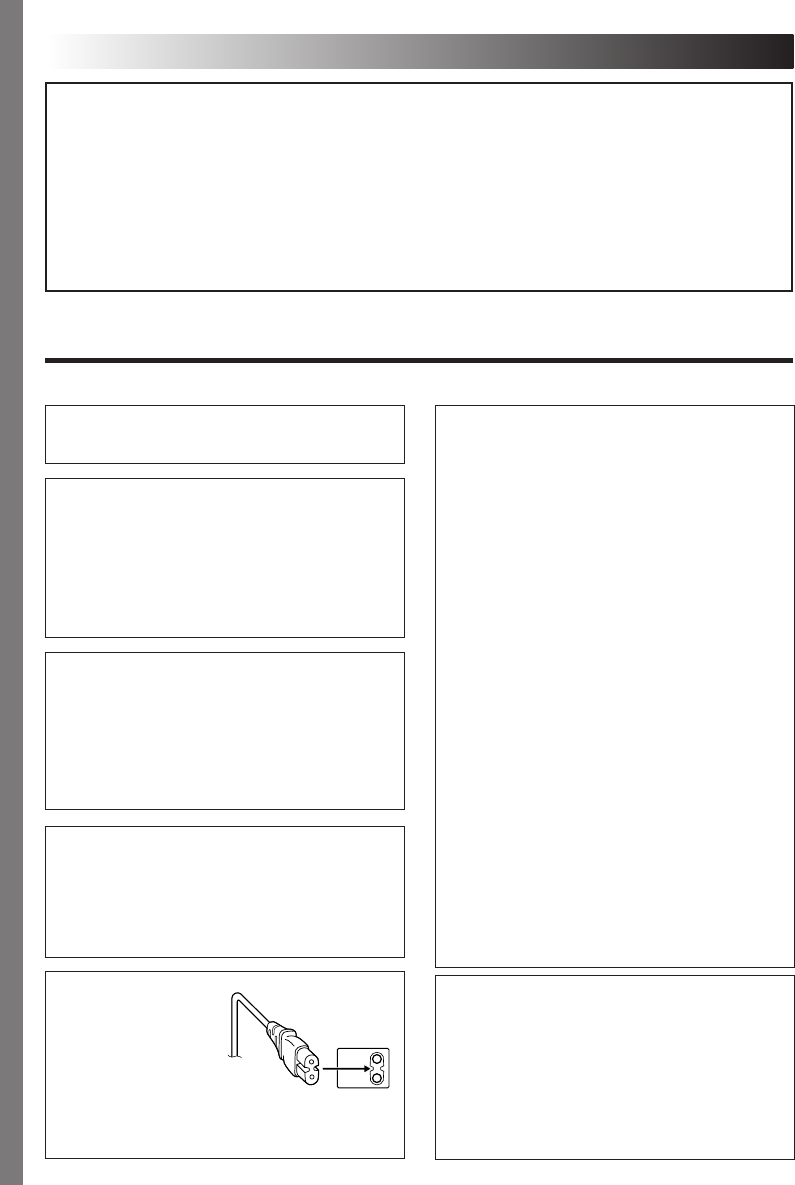
2 EN
It is recommended that you . . .
.... read thoroughly the Safety Precautions. They contain extremely important information regarding the safe
use of this product.
SAFETY PRECAUTIONS
NOTES:
●
The rating plate (serial number plate) and safety
caution are on the bottom and/or the back of
the main unit.
●
The rating information and safety caution of the
AC Adapter
are
on the bottom of the adapter.
Dear Customer,
Thank you for purchasing this Mobile mini note PC. Before use, please read the safety information and
precautions contained in the following pages to ensure safe use of this product.
Hereby, JVC declares that this equipment is in compliance with the essential requirements and other
relevant provisions of Directive 1999 / 5 / EC.
The modem incorporated in this product was tested according to the standard TBR21.
The correct function on a public analogue telephone line and a wireless LAN network is confirmed with
the listed cautions.
Should you have any problem on a specific network, we kindly ask you to inform your JVC
Service Centre the nature of the problem and details of which service provider you are using.
WARNING
DANGEROUS VOLTAGE INSIDE
CAUTIONS:
ⅢTo prevent shock, do not open the cabinet. No
user serviceable parts inside. Refer servicing to
qualified personnel.
ⅢWhen you are not using the AC Adapter for a
long period of time, it is recommended that you
disconnect the power cord from the AC outlet.
CAUTION:
To avoid electric
shock or damage to
the unit, first firmly
insert the small end of
the power cord into
the AC Adapter until it
is no longer wobbly, and then plug the larger
end of the power cord into an AC outlet.
IMPORTANT for the U.K.
DO NOT cut off the mains plug from this equipment. If
the plug fitted is not suitable for the power points in your
home or the cable is too short to reach a power point, then
obtain an appropriate safety approved extension lead or
consult your dealer.
BE SURE to replace the fuse only with an identical approved
type, as originally fitted.
I
f, nonetheless, the mains plug is cut off be sure to re-
move the fuse and dispose of the plug immediately, to
avoid a possible shock hazard by inadvertent connec-
tion to the mains supply.
If this product is not supplied fitted with a mains plug then
follow the instructions given below:
IMPORTANT.
DO NOT make any connection to the terminal which is
marked with the letter E or by the safety
earth
symbol or
coloured green or green-and-yellow.
The wires in the mains lead on this product are coloured
in accordance with the following code:
Blue : Neutral
Brown : Live
As these colours may not correspond with the coloured
markings identifying the terminals in your plug proceed
as follows:
The wire which is coloured blue must be connected to
the terminal which is marked with the letter N or coloured
black.
The wire which is coloured brown must be connected to
the terminal which is marked with the letter L or coloured
red.
IF IN DOUBT - CONSULT A COMPETENT ELECTRICIAN.
WARNING: TO PREVENT FIRE OR SHOCK
HAZARD, DO NOT EXPOSE THIS UNIT TO RAIN
OR MOISTURE.
This unit should be used with 110 – 240 V~, 50/60 Hz
only.
CAUTION: To prevent electric shocks and fire hazards,
do NOT use any other power source.
CAUTIONS:
●I
f used near a radio, this unit may interfere with
reception.
●
Prevent inflammables, water and metallic objects from
entering the unit.
●
Do not disassemble or modify the unit.
●
Do not apply shocks to the unit.
●
Do not subject the unit to direct sunlight.
●
Avoid using the unit in extremely hot or humid places.
●
Avoid using the unit in places subject to vibrations.
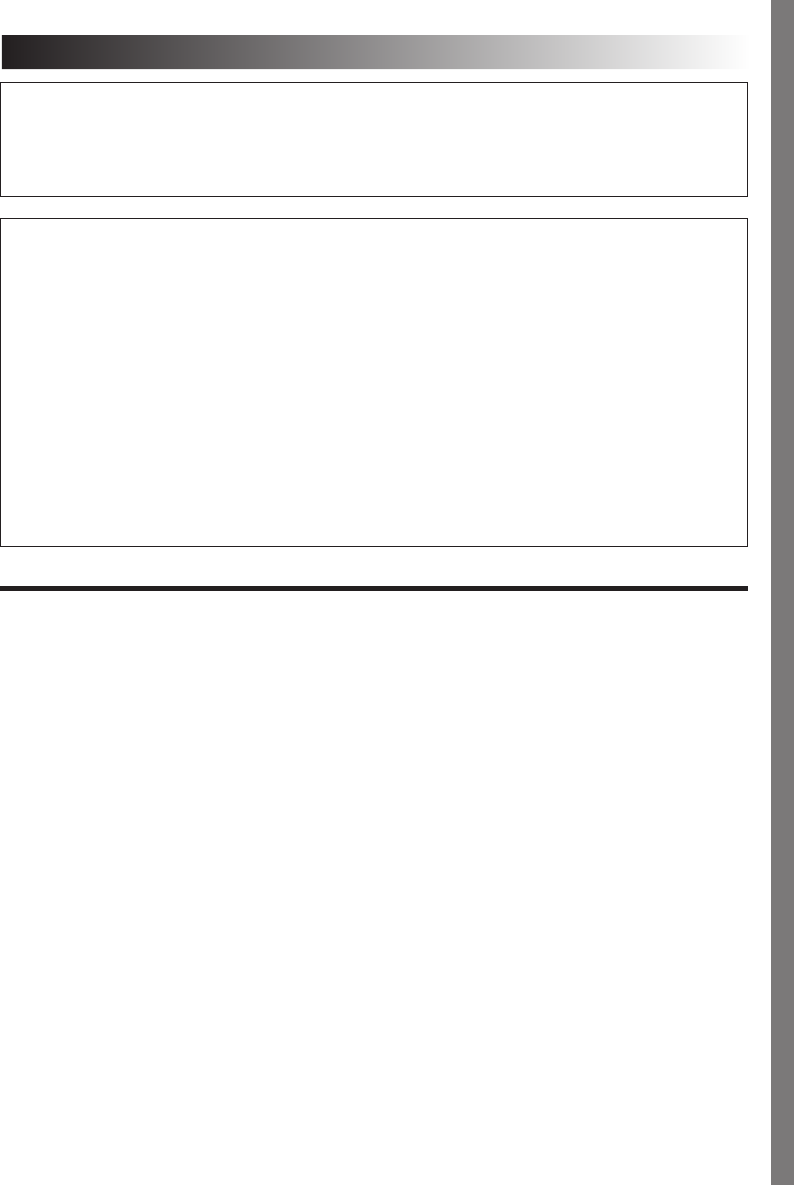
EN3
CAUTIONS:
●This Mobile mini note PC is designed to be used with the JVC BN-LS12E/LL22E battery packs and, to
recharge them or to supply power to the Mobile mini note PC from an AC outlet, use the provided AC
Adapter and Power Cord. (An appropriate conversion adapter may be necessary to accommodate
different designs of AC outlets in different countries.)
When the equipment is installed in a cabinet or on a shelf, make sure that it has sufficient space on all
sides to allow for ventilation (10 cm or more on both sides, on top and at the rear).
Do not block the ventilation holes.
(If the ventilation holes are blocked by a newspaper, or cloth etc. the heat may not be able to get out.)
Do not allow the Mobile mini note PC or AC adapter to operate with the base resting directly on anyone’s
lap. Allowing sustained contact may cause discomfort or, eventually, a burn.
No naked flame sources, such as lighted candles, should be placed on the apparatus.
When discarding batteries, environmental problems must be considered and the local rules or laws
governing the disposal of these batteries must be strictly followed.
The apparatus shall not be exposed to dripping or splashing.
Do not use this equipment in a bathroom or places with water.
Also do not place any containers filled with water or liquids (such as cosmetics or medicines, flower vases,
potted plants, cups etc.) on top of this unit.
(If water or liquid is allowed to enter this equipment, fire or electric shock may be caused.)
SOME DO’S AND DON’TS ON THE SAFE USE
OF EQUIPMENT
This equipment has been designed and manufactured to meet international safety standards but, as with any
electrical equipment, care must be taken if you are to obtain the best results and safety is to be assured.
DO read the operating instructions before you attempt to use the equipment.
DO ensure that all electrical connections (including the mains plug, extension leads and interconnections
between pieces of equipment) are properly made and in accordance with the manufacturer’s
instructions. Switch off and withdraw the mains plug when making or changing connections.
DO consult your dealer if you are ever in doubt about the installation, operation or safety of your
equipment.
DO be careful with the LCD panel on equipment.
DON’T continue to operate the equipment if you are in any doubt about it working normally, or if it is
damaged in any way — switch off, withdraw the mains plug and consult your dealer.
DON’T remove any fixed cover as this may expose dangerous voltages.
DON’T leave equipment switched on when it is unattended unless it is specifically stated that it is designed for
unattended operation or has a standby mode. Switch off using the switch on the equipment and make
sure that your family knows how to do this. Special arrangements may need to be made for infirm or
handicapped people.
DON’T use equipment such as personal stereos or radios so that you are distracted from the requirements of
road safety. It is illegal to watch the LCD panel while driving.
DON’T listen to headphones at high volume, as such use can permanently damage your hearing.
DON’T obstruct the ventilation of the equipment, for example with curtains or soft furnishings. Overheating
will cause damage and shorten the life of the equipment.
DON’T allow electrical equipment to be exposed to rain or moisture.
ABOVE ALL
—NEVER let anyone especially children push anything into holes, slots or any other opening in the case —
this could result in a fatal electrical shock;
—NEVER guess or take chances with electrical equipment of any kind — it is better to be safe than sorry!
LL23E

4 EN
CAUTION
To reduce the risk of fire, use only No. 26 AWG or larger telecommunication line cord.
IMPORTANT SAFETY INSTRUCTIONS:
1. Avoid using a telephone (other than a cordless type) during an electrical storm. There may
be a remote risk of electric shock from lightning.
2. Do not use the telephone to report a gas leak in the vicinity of the leak.
3. Use only the power cord and batteries indicated in this manual. Do not dispose of batteries
in a fire. They may explode. Check with local codes for possible special disposal
instructions.
When using the wireless LAN
WARNING
Please heed the warning below.
•Do not turn on the PC’s power in trains, aircraft, hospitals or other places where the use of
wireless LANs is restricted or prohibited. Use in such places may have an adverse effect
on the electronic devices or medical equipment and cause accidents. At present, the
policy of airline companies is to prohibit the use of electronic devices in aircraft at certain
stages of a flight (take-off and landing). This PC is classified as an “electronic device.” For
further details, contact the airline companies.
Radio waves emitted from wireless LANs
WARNING
Please heed the warning below.
•Do not use the wireless LAN in trains full of passengers and other crowded locations.
Wireless LANs emit radio waves which can adversely affect pacemakers and other medical
devices.
•Do not use the wireless LAN if you are bringing this PC on board an aircraft or into a
hospital. Wireless LANs emit radio waves which may adversely affect measuring instruments
and medical equipment.
•Stop using the wireless LAN in this PC if other equipment is being adversely affected by
the wireless LAN. Wireless LANs emit radio waves which may adversely affect other
equipment and cause accidents triggered by equipment malfunctioning.
Mobile mini note PC with Radio Local Area Network (RLAN)
OPERATING AT 2412 TO 2462 MHz
•This equipment with RLAN is intended to be used in Germany, UK, Austria and Switzerland.
Outdoor use may be restricted to certain frequencies and/or may require a licence for operation.
0197
Hereby, JVC declares that this MP-XP73 1GB is in compliance with the essential requirements
and other relevant provisions of Directive 1999 / 5 / EC.
XV841
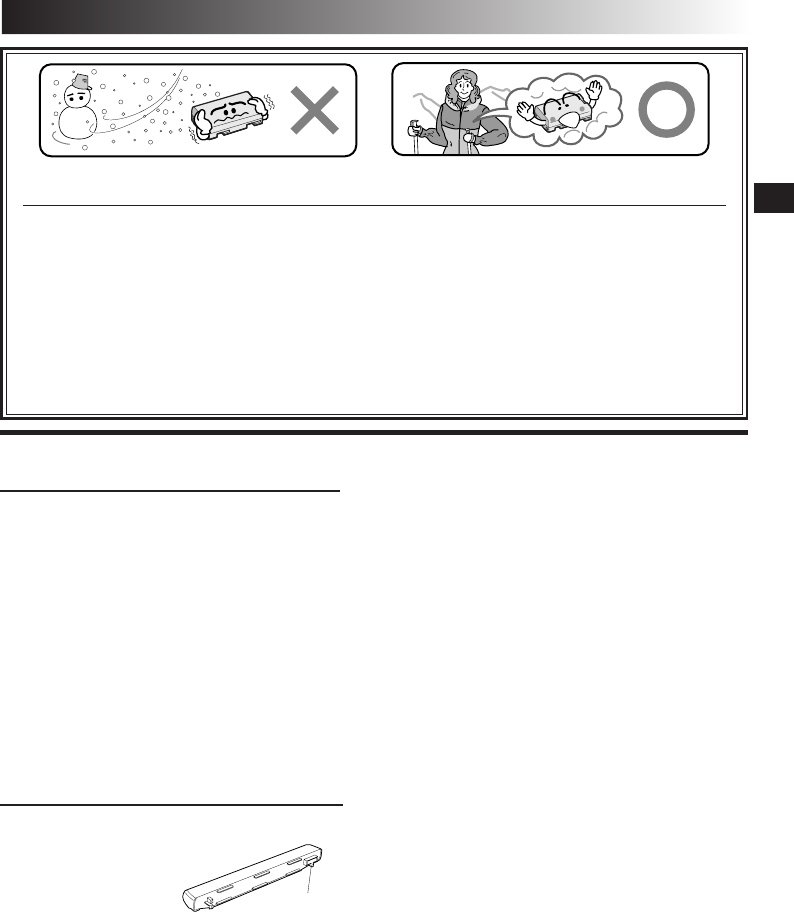
EN5
Lithium-ion is vulnerable in colder temperatures.
About Batteries
DANGER! Do not attempt to take the batteries apart, or expose them to flame or excessive heat, as it may
cause a fire or explosion.
WARNING! Do not allow the battery or its terminals to come in contact with metals, as this can result in a
short circuit and possibly start a fire.
Caution! Danger of explosion if the battery is incorrectly replaced. Replace only with the same or equivalent
type.
The Benefits Of Lithium-Ion Batteries
Lithium-ion battery packs are small but have a large power capacity. However, when one is exposed to cold
temperatures (below 10°C), its usage time becomes shorter and it may cease to function. If this happens, place the
battery pack in your pocket or other warm, protected place for a short time, then re-attach it to the Mobile mini
note PC. As long as the battery pack itself is not cold, it should not affect performance.
(If you’re using a heating pad, make sure the battery pack does not come in direct contact with it.)
General Battery Precautions
Use only the following batteries:
Please make note of the following rules for battery
use. When misused, the batteries can leak or
explode.
1. When replacing batteries, refer to page 16.
2. Do not use any different size of batteries from
those specified.
3. Be sure to install batteries in the correct
direction.
4. Do not expose the batteries to excessive heat
as they can leak or explode.
5. Do not dispose of the batteries in a fire.
CAUTIONS
Battery Packs
The supplied battery pack
is a lithium-ion battery.
Before using the supplied
battery pack or an
optional battery pack, be
sure to read the following
cautions:
1. To avoid hazards . . .
.... do not burn.
.... do not short-circuit the terminals. When
transporting, make sure the provided battery
cap is attached to the battery. If the battery
cap is misplaced, carry the battery in a
plastic bag.
Terminals
.... do not modify or disassemble.
.... do not expose the battery to temperatures exceeding
60°C, as this may cause the battery to overheat,
explode or catch fire.
.... use only specified chargers.
2. To prevent damage and prolong service life . . .
.... do not subject to unnecessary shock.
.... charge in an environment where temperatures are
within the tolerances shown in the chart below. This
is a chemical reaction type battery—cooler
temperatures impede chemical reaction, while
warmer temperatures can prevent complete
charging.
.... store in a cool, dry place. Extended exposure to high
temperatures will increase natural discharge and
shorten service life.
.... fully charge and then fully discharge the battery
every 6 months when storing the battery pack over a
long period of time.
.... remove from charger or power unit when not in use,
as some machines use current even when switched
off.
NOTES:
●
It is normal for the battery pack to be warm after
charging, or after use.
Temperature Range Specifications
Charging ............. 10°C to 35°C
Operation ........... 0°C to 40°C
Storage ............... –10°C to 30°C
●
Recharging time is based on room temperature of 20°C.
●
The lower the temperature, the longer recharging takes.
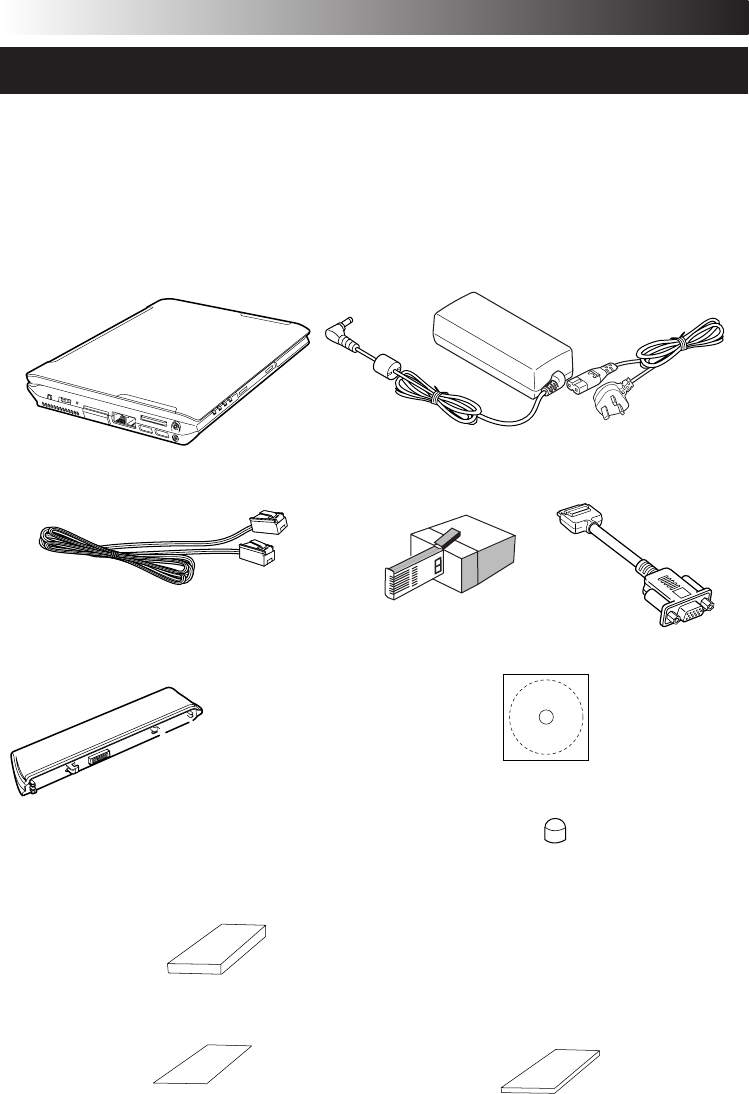
6 EN
•Mobile mini note PC •MP-ACX21 AC power adapter
(including dedicated AC cable)
•Two Application CD-ROMs
•Instruction manual (this book)
Lithium ion battery pack
•BN-LS12E standard
•Warranty card
CHECKING INVENTORY
Before using your Mobile mini note PC (hereinafter Mobile PC), make sure that all of the
following system components have been included in the container.
If you have found any shortage or problem, contact the sales shop.
* The illustrations provided in these instructions may differ in part from the actual products.
•Modem cable (1.8-meters long)
•Two stick caps
•Protection cover (of battery terminal)
•Start Here manual
• Telephone adapter
•External display cable
(MP-VGX32E)
(standard)

EN7
JVC Software License Agreement
Important:
Thank you for purchasing JVC Mobile mini note PC (“Product”).
Please carefully read this End-User License Agreement (“Agreement”) before installing or using
JVC original software accompanied with or pre-installed into the Product (“Software”). The right
to use the Software is granted by Victor Company of Japan, Limited (“JVC”) to You only on the
condition that You agree to the following Agreement. If You do not agree to the terms of the
Agreement, you may not use the Software any more. Then, please give the Software with the
Product back to the dealer from whom you bought the Product. HOWEVER, USING THE
PRODUCT OR UNPACKING THE PACKAGED MEDIA CONTAINING THE SOFTWARE INDICATES
YOUR ACCEPTANCE OF THESE TERMS AND CONDITIONS.
END-USER LICENSE AGREEMENT
1. Copyright; Ownership
You acknowledge that all copyrights and other intellectual property rights in the Software as
well as associated materials such as instruction manual and other documents (“Associated
Materials”) are owned by JVC and its licensor, and remain vested in JVC and such licensor.
The Software is protected under the copyright law of Japan and other countries, and related
Conventions.
2. Grant of License
(1) Subject to the conditions of this Agreement, JVC grants to You a non-exclusive right to use
the Software.
(2) You may install and/or use the Software on an HDD or other storage devices incorporated
in the Product only.
(3) You may make a single copy of the Software for the back-up and storage purpose, if a back-
up copy of the Software has not been included with the Product on physical media such as
CD-ROM. You may use such back-up copy solely for the archival purpose.
(4) The terms of this Agreement will apply to any updated Software provided by JVC to You at
JVC’s sole option. Such update will be also deemed as the Software.
3. Restriction
(1) You may not reverse engineer, decompile or disassemble (except to the extent as permitted
by the applicable laws) the Software in any manner.
(2) You may not modify, copy or otherwise dispose of the Software, in whole or in part, other
than as expressly specified in this Agreement.
(3) You have no right to grant a license to use the Software, and may not sell, lease or rent the
Software to any other person for any purpose.
4. Transfer of the Software
Subject to the fulfillment of the following conditions, You may assign the license granted
under this Agreement to other person.
(1) You assign and transfer such other person the Product including the Software, any copy of
the Software contained in the packaged media as well as any Associated Materials, and
then will not possess them.
(2) Such other person as assignee agrees to the Agreement.

8 EN
5. Limited Warranty
(1) THE SOFTWARE IS PROVIDED “AS IS” WITHOUT WARRANTY OF ANY KIND. SHOULD
THERE BE ANY PROBLEM ARISING FROM OR CAUSED BY THE SOFTWARE, YOU
SHOULD SETTLE ALL SUCH PROBLEM AT YOUR OWN COSTS AND RESPONSIBILITIES.
(2) THIS SECTION PROVIDES JVC’S EXCLUSIVE WARRANTY REGARDING THE SOFTWARE.
JVC DOES NOT MAKE ANY OTHER WARRANTIES, EXPRESS OR IMPLIED.
6. Limitation of Liability
JVC WILL HAVE NO LIABILITY WITH RESPECT TO ITS OBLIGATIONS UNDER THIS
AGREEMENT OR OTHERWISE FOR CONSEQUENTIAL, EXEMPLARY, INCIDENTAL OR
PUNITIVE DAMAGES EVEN IF IT HAS BEEN ADVISED OF THE POSSIBILITY OF SUCH
DAMAGES. YOU WILL INDEMNIFY AND HOLD HARMLESS JVC FROM ANY LOSS,
LIABILITY OR COSTS ARISING OUT OF OR IN ANY WAY CONNECTED TO CLAIMS FROM
ANY OTHER PERSONS RELATING TO THE USE OF THE SOFTWARE.
7. Term
This Agreement will become effective on the date when You start to use the Product or You
unpack the packaged media containing the Software, whichever is earlier, and continue to
be in effect until termination under Section 8 below, interpretation and performance of this
Agreement.
8. Termination
(1) Should You breach any provision of this Agreement, JVC may terminate this Agreement
without giving any notice to You. In this event, JVC may claim against You any damages
caused by Your breach.
(2) Should this Agreement be terminated, You should immediately destroy the Software
including any copy (including erasure from any memory in the Product) and any associated
Materials, and then will not possess them.
9. Export Control
You agree that You will not ship, transfer or export the Software or underlying information
and technology to any countries to which Japan and other relevant countries have embargoed
goods.
10.General
(1) No modification, change, addition, deletion or other alteration of or to the Agreement
will be valid unless reduced to writing and signed by an authorized representative of JVC.
(2) Even if any part of the Agreement is held invalid by or in conflict with any law having
jurisdiction over this Agreement, the remaining provisions will remain in full force and
effect.
(3) To the maximum extent permitted by the applicable law where the Software was acquired,
any conditions or warranties imposed or implied by law are hereby excluded. You may
nevertheless have the benefit of certain rights or remedies pursuant to the applicable law
in respect of which liability may not be excluded. In any case, however, JVC's entire
liability will be limited to those which apply to the Product.
(4) The Agreement shall be governed by and interpreted under the laws of Japan. The Tokyo
District Court has jurisdiction over all disputes which may arise with respect to the
execution, interpretation and performance of this Agreement.

EN9
END-USER LICENSE AGREEMENT
Important:
Please carefully read this End-User License Agreement (“Agreement”) before installing or using
the G.726 Decoder (“Software”) on your PC. The right to use the Software is granted by Victor
Company of Japan, Limited (“JVC”) to You only on the condition that You agree to the following
Agreement. If You do not agree to the terms of the Agreement, you may not install the Software
any more. HOWEVER, INSTALLING OR USING THE SOFTWARE INDICATES YOUR
ACCEPTANCE OF THESE TERMS AND CONDITIONS. The Software also includes the associated
materials, and any modification, upgrade and update of the Software granted to You by JVC.
1. Copyright; Ownership
You acknowledge that all copyrights and other intellectual property rights in the Software is
owned by, and remain vested in Sharp Corporation, a Japanese corporation, and JVC is the
authorized licensee of Sharp Corporation to duplicate, use and distribute the Software. The
Software is protected under the copyright law of Japan and other countries, and related
Conventions. You must use the Software in the same manner as You use any other copyrighted
work in compliance with these laws and conventions and other regulations.
2. Grant of License
(1) Subject to the conditions of the Agreement, JVC grants to You a non-exclusive right to use
the Software.
(2) You may install and use the Software in Your PC.
(3) You may make a copy of the Software in whole or in part for the back-up and storage
purposes.
3. Restriction
(1) You may not modify, reverse engineer, decompile or disassemble (except to the extent as
permitted by the applicable laws) the Software in any manner.
(2) You may not copy or use the Software, in whole or in part, other than as expressly specified
in this Agreement.
(3) You may not remove the copyright and/or other proprietary rights notice from the Software.
You may make copies of the Software hereunder, provided that each such copy contains
copyright and/or other proprietary rights notice in the same manner as appeared originally
on this Agreement and the Software.
(4) You have no right to grant a license to use the Software, and may not sell, lease or rent the
Software to any other person for any purpose.
4. Transfer of the Software
You may not transfer or assign the Software (either stored in the recording media or not) to any
other person, unless such other person as the transferee or assignee agrees to this Agreement.
Such assignee or transferee will be bound by the same conditions as provided for in this
Agreement, and the license originally granted to You hereunder will then be null and void.
5. Limited Warranty
THE SOFTWARE IS PROVIDED “AS IS” WITHOUT WARRANTY OF ANY KIND. JVC DOES
NOT MAKE ANY OTHER WARRANTIES, EXPRESS OR IMPLIED, INCLUDING BUT NOT
LIMITED TO WARRANTIES OF MERCHANTABILITY OR FITNESS FOR A PARTICULAR
PURPOSE. SHOULD THERE BE ANY PROBLEM ARISING FROM OR CAUSED BY THE
SOFTWARE, YOU SHOULD SETTLE ALL SUCH PROBLEMS AT YOUR OWN COST AND
RESPONSIBILITY.

10 EN
6. Limitation of Liability
JVC WILL HAVE NO LIABILITY WITH RESPECT TO ITS OBLIGATIONS UNDER THIS
AGREEMENT OR OTHERWISE FOR CONSEQUENTIAL, EXEMPLARY, INCIDENTAL OR
PUNITIVE DAMAGES EVEN IF IT HAS BEEN ADVISED OF THE POSSIBILITY OF SUCH
DAMAGES. YOU WILL INDEMNIFY AND HOLD HARMLESS JVC FROM ANY LOSS, LIABILITY
OR COSTS ARISING OUT OF OR IN ANY WAY CONNECTED TO CLAIMS FROM ANY OTHER
PERSONS RELATING TO THE USE OF THE SOFTWARE.
7. Term
This Agreement will become effective on the date when You download and/or install the
Software onto Your machine, and continue to be in effect until termination under the reasons
as below:
Should You breach any provision of this Agreement, JVC may terminate this Agreement without
giving any notice to You. In this event, JVC may claim against You any damages caused by
Your breach. Should this Agreement be terminated, You should immediately destroy the
Software stored in Your machine (including erasure from any memory in Your PC), and then
will not possess such Software.
8. Export Control
You agree that You will not ship, transfer or export the Software or underlying information and
technology to any countries to which Japan and other relevant countries have embargoed
goods.
9. Restricted Rights Legend
The Software including related documentation has been developed at private expense of Sharp
Corporation, and is commercially available.
If the Software is acquired by You under a United States Department of Defense contract, the
use, duplication or disclosure by the Government is subject to the restrictions as set forth in
subparagraph (c)(i)(ii) of the Rights in Technical Data and Computer Software clause at DFARS
252.227-7013. Contractor: Victor Company of Japan, Limited, 12, 3-chome, Moriya-cho,
Kanagawa-ku, Yokohama, Kanagawa 221-8528 Japan.
If the Software is acquired by You as any other agency of the U.S. Government, the use,
duplication, or disclosure by the Government is subject to the restriction as set forth in
subparagraph (g)(3) of FAR 52.227-14 or FAR 52.227-19, as applicable.
10. General
(1) No modification, change, addition, deletion or other alteration of or to the Agreement will
be valid unless reduced to writing and signed by an authorized representative of JVC.
(2) To the maximum extent permitted by the applicable law where the Software was acquired,
any conditions or warranties imposed or implied by law are hereby excluded. You may
nevertheless have the benefit of certain rights or remedies pursuant to the applicable law
in respect of which liability may not be excluded. In any case, however, JVC’s entire
liability will be limited to those which apply to your Mobile mini note PC.
(3) Even if any part of the Agreement is held invalid by or in conflict with any law having
jurisdiction over this Agreement, the remaining provisions will remain in full force and
effect.
(4) The Agreement shall be governed by and interpreted under the laws of Japan. The Tokyo
District Court has jurisdiction over all disputes which may arise with respect to the
execution, interpretation and performance of this Agreement.

EN11
Table of Contents
SAFETY PRECAUTIONS ....................................... 2
SOME DO’S AND DON‘TS ON THE SAFE
USE OF EQUIPMENT .......................................... 3
When Using The Wireless LAN ............................ 4
Radio Waves Emitted From
Wireless LANs ...................................................... 4
CAUTIONS ......................................................... 5
CHECKING INVENTORY ..................................... 6
JVC Software License Agreement ...................... 7
END-USER LICENSE AGREMENT ...................... 9
PARTS AND COMPONENT NAMES .................. 12
SETTING UP
SETTING UP ...................................................... 16
TURN-ON ......................................................... 19
Turning (On/Off) Key ON ...................... 19
Initial Setup of Microsoft Windows ............... 20
Turn-off ......................................................... 22
JVC ORIGINAL SOFTWARE AND
SYSTEM APPLICATIONS
JVC ORIGINAL SOFTWARE ............................... 24
Setup of JVC Original Software ...................... 24
DVC’s USB Drivers ......................................... 25
CC Converter .................................................. 27
PD-TS decorder .............................................. 29
Easy Network Changer .................................... 30
Using Bootable CD Creater (BCDC) ................ 31
STANDARD APPLICATION ................................ 32
To Set Up the Standard Applications
Again .............................................................. 34
To Uninstall a Standard Application ................ 34
NAVIGATE IN THE INTERNET WORLD!
TO CONNECT TO THE INTERNET ..................... 36
Contracting with the Internet
Service Provider .............................................. 36
Connection of Telephone Line and
Modem Setup ................................................. 37
The Internet Connection Setup ........................ 39
Connecting to the Internet .............................. 44
Disconnection from the Internet ..................... 45
Accessing a Web Page .................................... 46
E-MAILING ........................................................ 47
Setting Up E-Mail Software ............................. 47
Sending and Receiving E-mails ....................... 50
HARDWARE
Using the Pointing Device ................................. 54
Using Hot Keys .................................................. 56
Using the Numeric Keypad ................................ 56
If a Key Top Has Come Off ................................. 57
Increasing the (Optional) Memory
Capacity ............................................................ 58
Adding or Removing a Memory Board ............... 59
Checking the Additional Memory Board ............ 61
Using an External Monitor ................................. 62
Connecting to a Network ................................... 63
Setting for Network Connection ......................... 63
General Description of Wireless LAN ................. 67
Types of Wireless LAN Networks ........................ 67
Suggestions for Using the Wireless LAN ............. 68
Setup Procedure for the Wireless LAN ................ 68
How to Shut Down the Wireless LAN
Functions ........................................................... 73
How to Set the Wireless LAN Function .............. 74
Checking the Battery Level ................................. 76
Power-saving Mode ........................................... 77
Unknown Partition on Hard Disk ....................... 79
PC RECOVERY (REPEATED PC SETUP)
Setting Up Your PC Again ................................... 82
System Recovery Procedure ............................... 83
TROUBLESHOOTING
Q&A .................................................................. 86
Power ............................................................. 86
Startup and Operation of Windows ................. 87
Display ........................................................... 89
Using the Internet ........................................... 90
Wireless LAN .................................................. 93
Battery ............................................................ 94
Miscellaneous ................................................. 95
APPENDIX
List of Support Centres .................................... 98
Trademark Notice ........................................... 99
How to Disposal ........................................... 100
Specification ................................................. 101
Wireless LAN Specifications ......................... 102
Options (separately available) ....................... 103
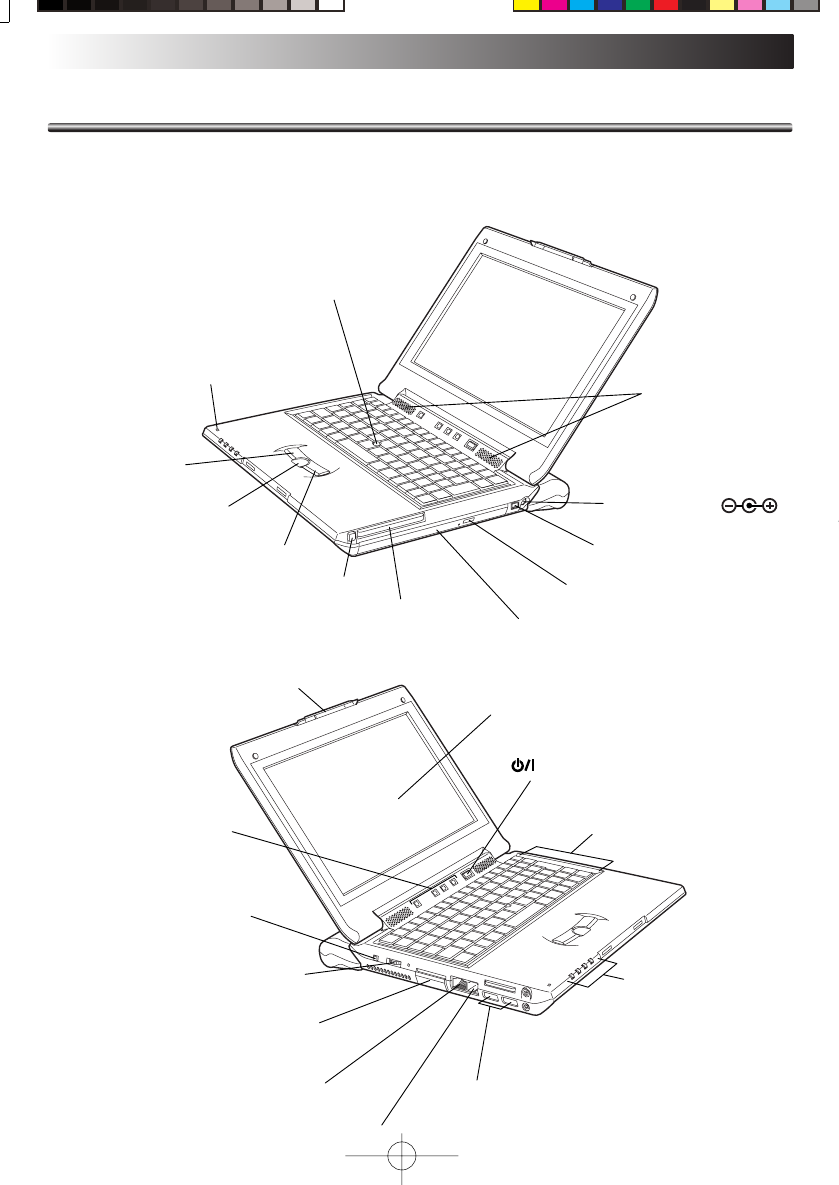
12 EN
PARTS AND COMPONENT NAMES
Your Mobile PC has the following parts and components.
Built-in
lithium ion
battery pack
Display panel
Buckle
i-Link connector
RESET button
Keyboard
Speakers
Ventilation slots
PC card
slot
PC card eject button
Stick
Scroll button
Headphone
output Microphone input
USB
connectors
External monitor output
Modem jack
DC Input connector
LAN connector
(On/Off) Key
Left button
Right button
Wireless LAN
antenna
Wireless LAN
antenna
Lithium ion battery pack
BN-LS12E standard
Wireless LAN ON/OFF switch
20
モバイルミニノート PC の各部を、取扱説明書では下図のように呼んでいます。
各部のなまえ
スティック(64 ページ)
電源コネクター
(
)
(25 ページ)
スクロールボタン
(64 ページ)
左ボタン
(64 ページ)
右ボタン(64 ページ)
バックル
ディスプレイ(99 ページ)
PC カードスロット
PC カード取り出しボタン
キーボード(66 ページ)
i.LINK コネクター
スピーカー
(電源)キー(27 ページ)
ワイヤレス LAN
ON/OFF スイッチ
(80 ページ)
モジュラージャック(46 ページ)(モデム)
LAN コネクター(74 ページ)
外部ディスプレイ出力端子
(73 ページ)/
ドッキングポート
USB コネクター
内臓マイク
(ネットミーティングに使います)
DVD マルチドライブ(00 ページ)
EJECT ボタン(00 ページ)
センターキー
(80 ページ)
ボリュームコントロール
(VOLUME)(80 ページ) CD/DVD 操作キー
(66 ページ)
MP-XV631_020-030 04.2.4, 15:46Page 20 Adobe PageMaker 7.0J/PPC
Stick
Speakers
DC Input connector
i.Link connector
EJECT button
DVD Drive
PC card slot
Scroll botton
Left button
Internal Microphone
Right button
PC card eject button
Display panel
(On/Off) Key
Keyboard
DVD/CD conrol key
Center Key
Buckle
Wireless LAN ON/OFF switch
Volume control
External monitor output /
Docking Port
LAN connector
USB connectors
Modem jack
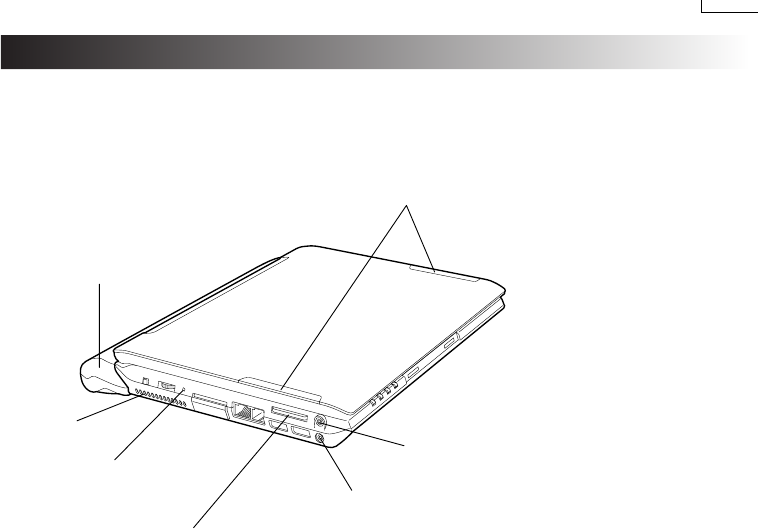
EN13
Wireless LAN antenna
Wireless LAN antenna
は
じ
め
に
マイク入力
リチウムイオンバッテリーパック
(26 ページ)(BN-LL23)
ヘッドホン出力
リセットスイッチ
(97 ページ)
通風孔
ワイヤレス LAN 用アンテナ(78 ページ)
SD メモリーカードスロット
(00 ページ)
MP-XV631_020-030 04.2.4, 15:46Page 21 Adobe PageMaker 7.0J/PPC
Wireless LAN antenna
Microphone input
Headphone output
SD memory card slot
Reset button
Ventilation slots
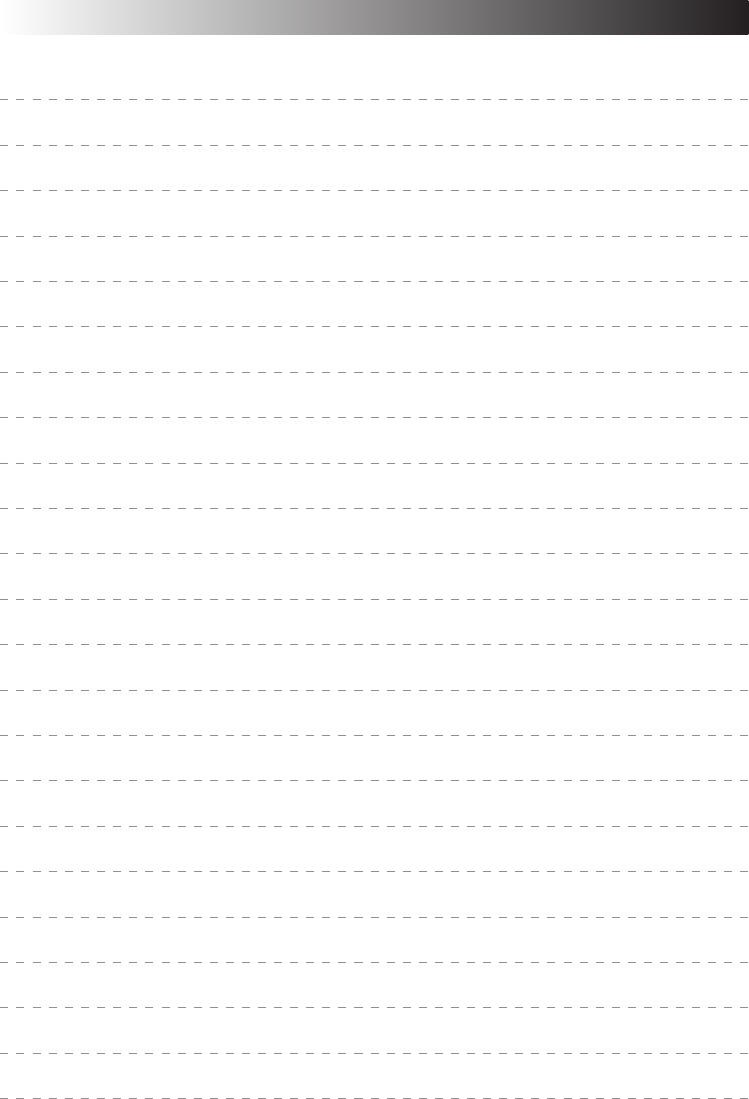
14 EN
MEMO

EN15
SETTING UP
1
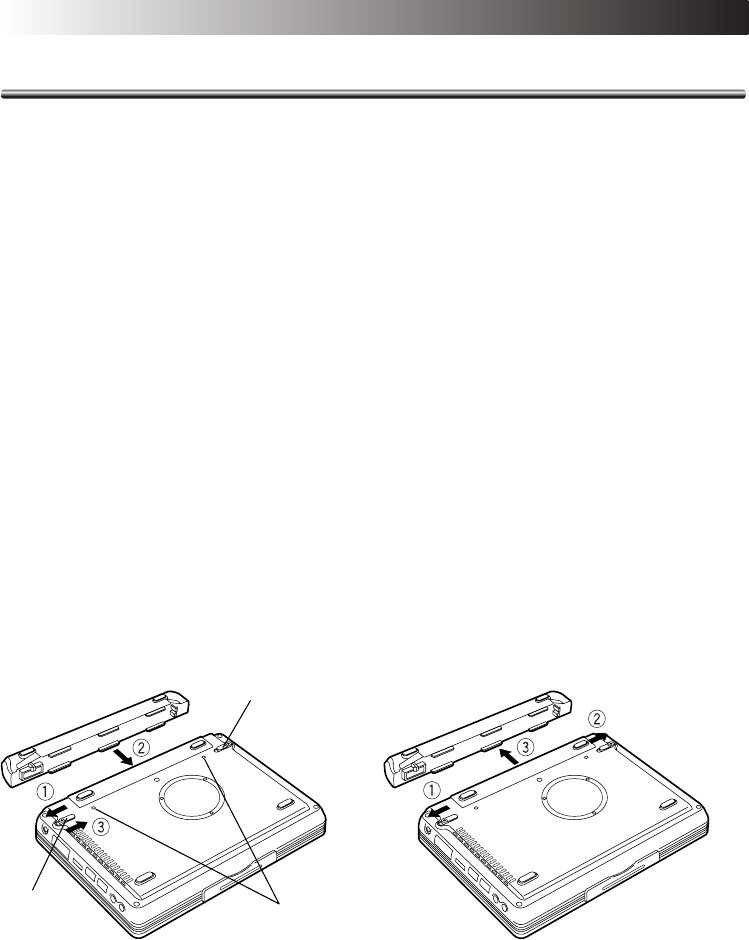
16 EN
4
( )
SETTING UP
When you first use your Mobile PC, always plug the AC power cord into the DC Input connector.
The built-in lithium-ion battery pack will be recharged during your PC setup. To avoid data loss
due to power failure or any other cause, check the points for battery recharging in Page 18.
1. Unplug the jumper pin before recharging the battery pack
Always unplug the battery terminal jumper pin from the PC rear panel when recharging the
battery pack by plugging the AC power cord into the DC Input connector.
2. Mounting/Dismounting the Lithium Ion Battery Pack
Mounting the Protection Cover
1Slide lock lever A mounted at
the bottom of the Mobile PC
in the direction of the arrow.
2Mount the battery terminal
protection cover.
3Slide lock lever A in the
direction of the arrow until it
locks.
Battery terminal jumper pin
Unplug the jumper pin
using the tip of a ball point
pen or similar.
Tips
Cover the battery terminal with the protection cover of
accessory kit if you use the Mobile PC without using the
standard lithium ion battery pack or the optional large
capacity lithium ion battery pack.
Holes for mounting
optional large-capacity
lithium ion battery pack
1Slide lock lever A in the direction of the
arrow (outward).
2Mount and lock the battery pack until it
clicks.
3Slide lock lever A in the direction of the
arrow (inward).
4Tighten two coin screws (when the large
capacity lithium ion battery pack is used).
1Slide lock lever A in the direction of the arrow.
2Slide and hold lock lever B in the direction of the
arrow, and pull out and dismount the battery pack
in direction 3 as shown.
SETTING UP
• Mounting Battery Pack • Dismounting Battery Pack
Jumper pin
The jumper pin is factory-mounted to
disconnect the battery pack from the
circuitry. The removed pin is not used again.
Lock lever A
Lock lever A
Lock lever B
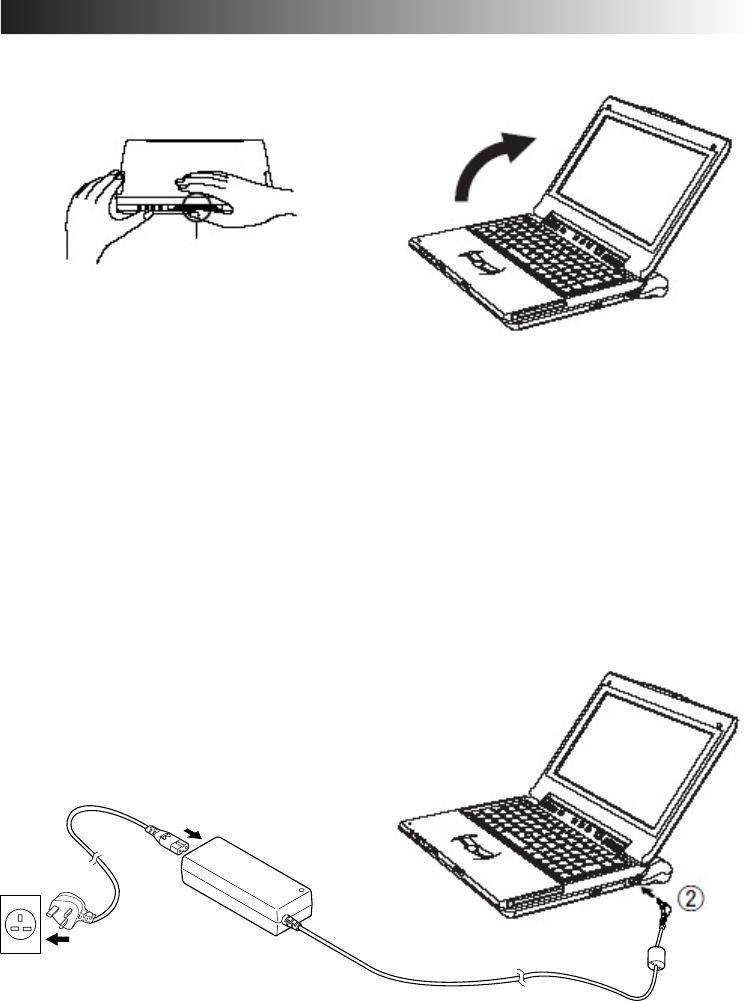
EN17
3. Open the display panel
Buckle
1Slightly pull up the buckle of the Note
PC, and the display panel will be
unlocked.
2Carefully open the display panel to the desired
angle. You can open the display panel to 180
degrees.
4. Recharge the built-in battery pack by plugging the AC cord into DC Input
connector
When recharging the built-in battery pack:
1Plug the AC power cord into the AC adapter.
2Plug the DC cord of the adapter into the DC Input connector of the Mobile PC.
3Plug the AC cord of the AC adapter into the power receptacle.
3
2
1
DC cord
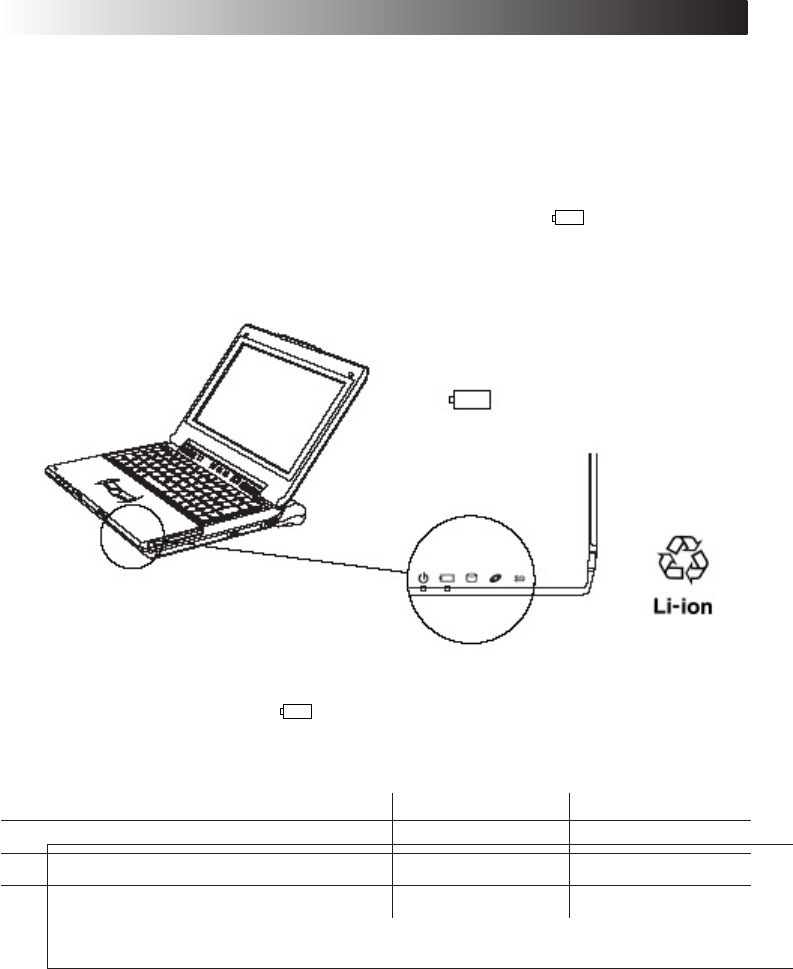
18 EN
5. Make sure that the battery pack is fully recharged
To avoid an interruption of your operation due to power failure, check the battery voltage when
you start to use your PC in the field. See “Checking the battery level” (see Page 76) to check the
battery voltage level.
¡ Make sure that the battery pack is fully recharged
When you are using the AC adapter and when the battery indicator (
) lights in green, the
battery pack is fully (100%) recharged. When it lights in orange, the battery pack is being recharged.
Battery recharge starts with the built-in battery or external battery pack, whichever has less
remaining power.
1
2
Built-in battery indicator
External battery indicator
Standard battery pack or large
capacity battery pack
( )
If you have unplugged the DC cable of the AC adapter and if you drive your PC with the lithium
battery pack, the battery indicator (
) goes out.
Approximate recharging times (when the PC’s power is off) :
80% recharging time 100% recharging time
Built-in battery pack Approximately 50 minutes Approximately 90 minutes
Both built-in battery pack and BN-LS133E standard battery pack Approximately 70 minutes Approximately 140 minutes
Both built-in battery pack and BN-LL232E large capacity battery pack Approximately 120 minutes Approximately 200 minute
s
Cautions
•If the battery pack is discharged quickly even after its recharging, the battery service life has
expired. Replace it with a new one. (The built-in battery pack and CMOS backup cells are
service parts.)
•The standard recharging times listed above are typical values in an ambient temperature of
20°C to 25°C.
•It may take up to 1.5 times longer to recharge the battery pack if the PC is being used.
SETTING UP
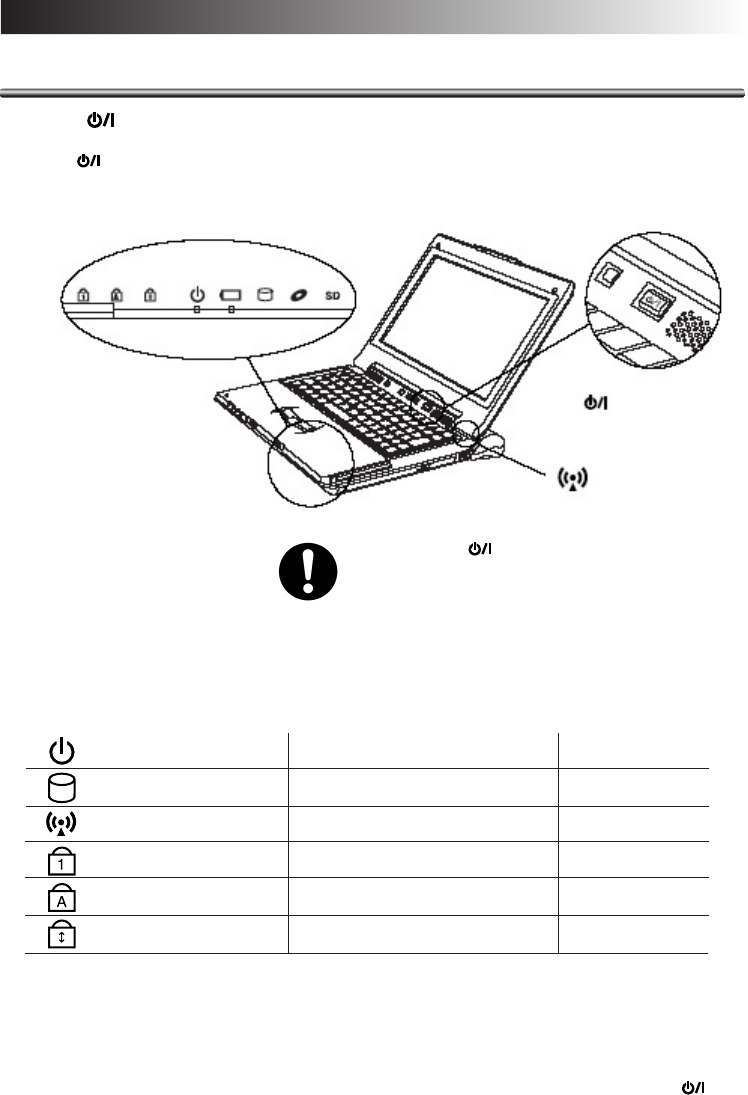
EN19
1A
TURN-ON
Turning (On/Off) Key On
Press the (On/Off) key.
The PC will turn on and the Windows logo will appear.
Caution
•Turn Off the PC (On/Off) key in areas such as hospitals
and aircraft where use of the PC is prohibited. Otherwise,
your PC may influence the electronic and medical
equipment and may cause a serious problem.
At present, most airlines prohibit the use of electronic
devices in an airplane according to the flight condition
(taking off and landing) of the aircraft and others. This
machine is also grouped in these electronic devices.
Consult each airline for details.
• Status indicators
Stand By lamp When the PC is turned on Lights up green.
HDD access lamp When the HDD is accessed Lights up green.
Wireless LAN access lamp
When wireless LAN is accessed Lights up orange.
Num Lock lamp When the Num Lock key is active Lights up green.
Caps Lock lamp When the Caps Lock key is active Lights up green.
Scroll Lock lamp When the Scroll Lock key is active Lights up green.
Caution
Disconnect all peripheral devices (such as a telephone or printer) when you press the (On/
Off) key first. Otherwise, your PC setup may fail.
(On/Off) Key
*The
Wireless LAN access lamp
flashes rapidly during data reception and
transmission. In addition, it flashes at frequent intervals during communication
with the access point.
*

20 EN
Initial Setup of Microsoft Windows
When using your PC for first time, you must prepare to use Microsoft Windows.
Once you have finished the initial Windows setup, you can use the software and various PC
functions. Use the following procedure to initially set up Microsoft Windows.
For pointing device and keyboard operations, see Pages 54 to 56.
1. When the “Welcome to Microsoft Windows” screen appears, click [Next] at the
right lower corner of the screen.
The “The End User License Agreement” screen will appear.
2. Read the “The End User License Agreement” information and click “Yes, I accept”
option if you accept the agreement. Then, click [Next].
The “What’s your computer’s name?” screen will appear.
Note
If you select the “No, I don’t accept” option, the initial Windows setup is cancelled. You
cannot use the Microsoft Windows and the PC software.
3. Rename your computer and click [Next].
The “An Internet connection could not be chosen” or “How will this computer connect to
the Internet?” screen appears.
Tips
A unique computer name is required so that your PC is distinguished from other computers
if you connect your PC to the network. Although the PC is named automatically and shown
in the “Computer name” column, you can change it to a name which is easy to remember.
4. Click [Next].
The “Ready to register with Microsoft?” screen appears.
5. Click “No, not at this time” option, and click [Next].
The “Who will use this computer?” screen may appear.
Tips
If you select “Yes, I’d like to register with Microsoft now” option, you can start online user
registration. For Internet connection setup, see Page 36 “To Connect to the Internet” section.
TURN-ON
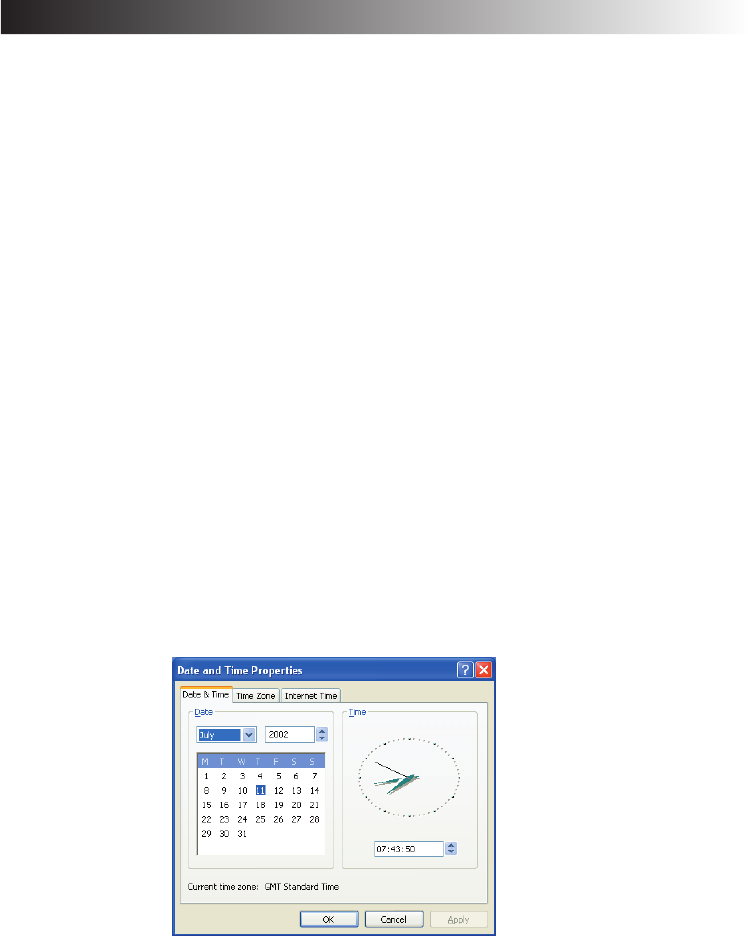
EN21
6. Enter the user name and click [Next].
The “Thank you!” screen will appear.
Tips
The name you have entered is shown on the “welcome” screen that appears when you turn
the PC power switch on after initial Windows setup. To start up Microsoft Windows, click
the user name shown on the screen.
7. Click [Finish].
The initial Windows setup has completed.
Cautions
• No guarantees are made for operation if an operating system other than the one already
installed in your PC is installed.
•When a week has passed after initial startup of the Microsoft Windows, a confirmation
screen asking for the deletion of desktop icons appears.
This is the Desktop Cleanup program that can delete icons that you have not used for a
certain period from the desktop screen. The software is not deleted even if you have
cleared its icon from the desktop screen.
•Use the following procedure to change the Windows date and time.
1. Double-click the time display in the task tray at the lower right of the desktop. The
“Date and Time Properties” dialog box appears.
2. Click the “Time Zone” tab and select your time zone from the list box.
3. Click the “Date & Time” tab and enter the correct date and time.
4. Click “OK” to save your change.
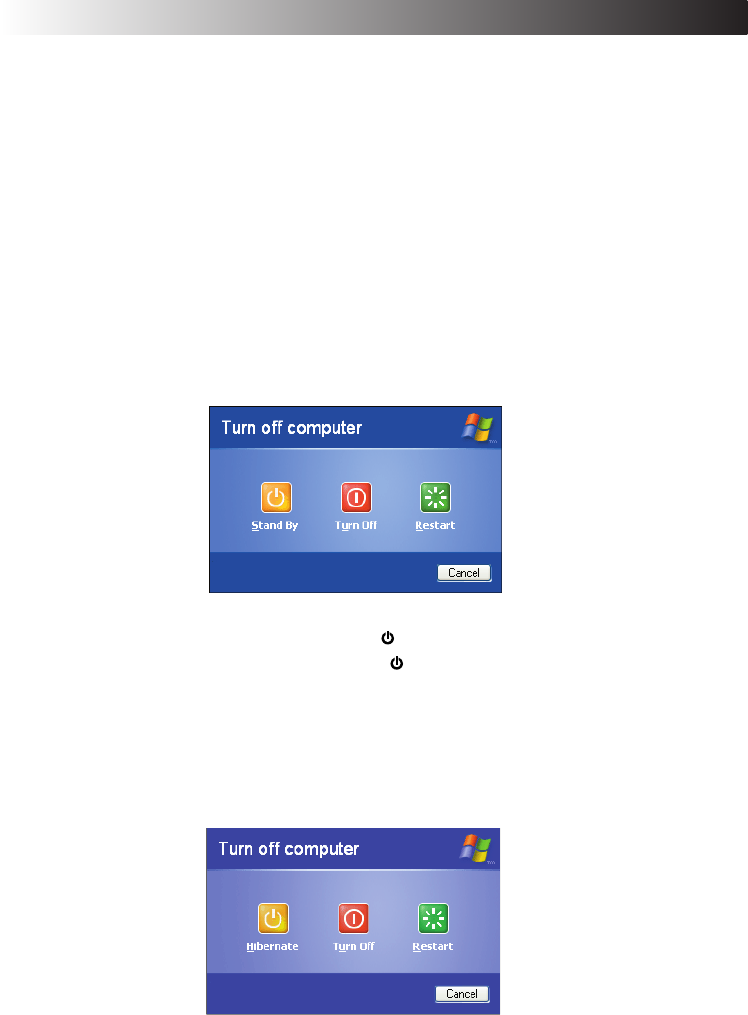
22 EN
Turn-Off
Caution
• Always use this procedure to turn off the PC. Otherwise, your PC may fail.
1. Click [start].
The “start” menu will appear.
2. Click [Turn Off computer].
The “Turn off computer” screen will appear.
3. Click [Turn Off].
The PC will be turned off automatically, and (Stand By) lamp will go out.
Before closing the LCD panel, make sure that (Stand By) lamp has turned off.
Tips
To restart Windows without turning off the power, click [Restart] on the “Turn off computer”
screen. Alternatively, press the [Shift] button on the keyboard while “Turn off computer”
screen is displayed. The screen below will appear and the PC can be put into [Hibernate].
For details on the [Stand By] and [Hibernate] modes, refer to pages 77 and 78.
TURN-ON

EN 23
JVC ORIGINAL SOFTWARE
AND SYSTEM APPLICATIONS
2
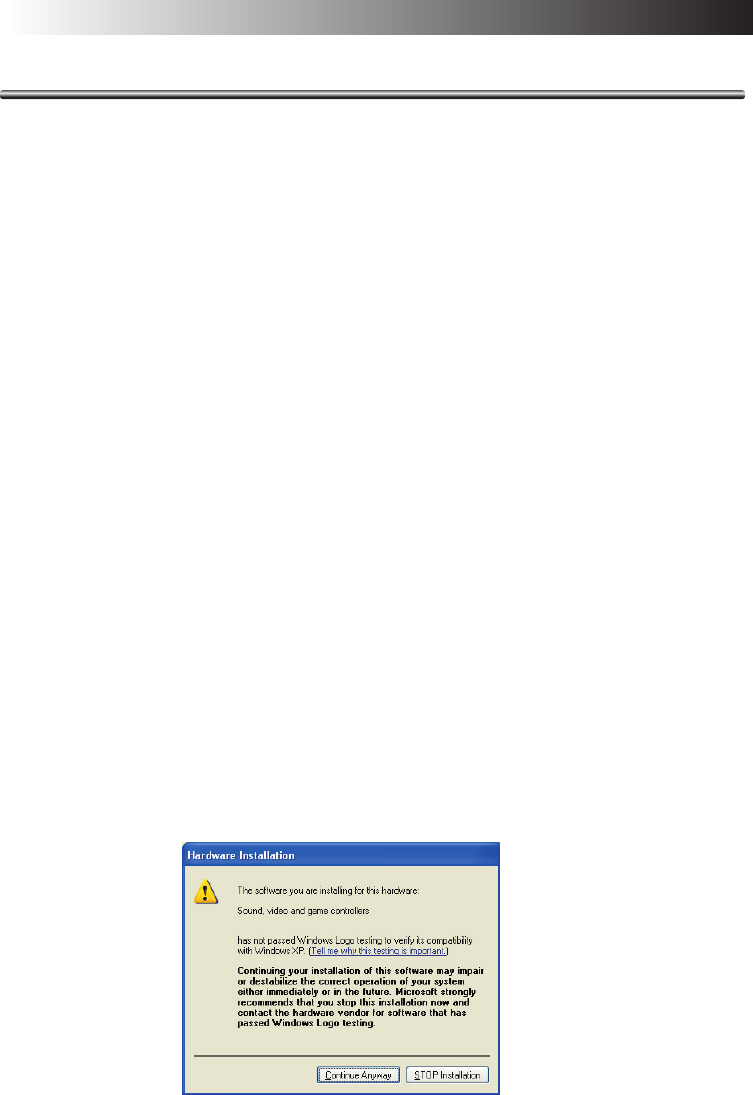
24 EN
JVC ORIGINAL SOFTWARE AND SYSTEM APPLICATIONS
JVC ORIGINAL SOFTWARE
To use the JVC original software, you must set it up in the “Setup of JVC Original Software” given
below. You can setup the following software programs.
Setup software
• CC converter (See Page 27.)
• JVC’s DVC (Digital Video Camera) utilities
Tips
•The JVC’s DVC utilities are USB drivers dedicated to GR-DV4000EK, DV3500EK, DV3000EK,
DV2000EK, DV700EK, DV600EK, DV500EK, DV400EK, DX300EK, DX100EK, DX95EK,
DX75EK, DX70EK, DX60EK, DX55EK, DX45EK, DX35EK, DX25EK, DV70EK, DV60EK,
D50EK, D40EK, DVP9EK, DVP8EK, DVP7EK and DVP3EK systems. If you are using any of
these DVC’s, you can use it without uploading the USB driver from the DVC’s CD-ROM
disk.
•For DVC connection and operations, see its instruction manual.
Setup of JVC Original Software
Before starting the software setup, quit and save the currently active application if any. Otherwise,
your working data will be lost.
1. Click [start] and click [Run first] at the right lower end of the Menu.
The “Preparing to Install... ” screen will appear, and the software setup will start up.
2. Read the License Agreement when displayed.
If you accept the Agreement, click [Yes]
3. During setup, the “Sound, video and game controllers has not passed Windows
Logo testing to verify its compatibility with Windows XP.” message may be
displayed. Ignore it as it does not affect the system operation. Click [Continue
Anyway] to continue software setup.
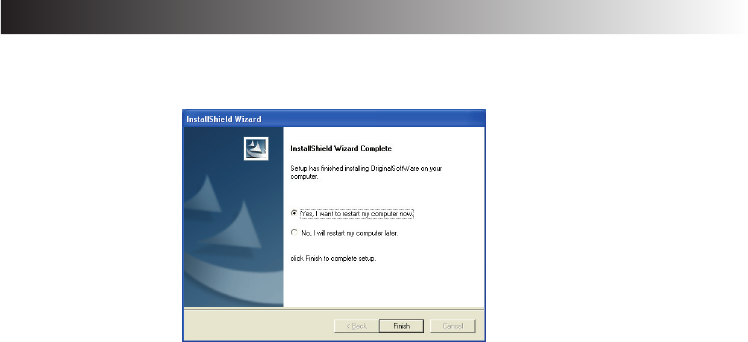
EN 25
4. When the software has been set up, a prompt for PC restarting appears. Click
[Finish] to restart the PC.
Caution
This setup cannot install all DVC utilities.
After you have set up the original software, plug the DVC cable into the USB socket of your
PC. The device type will be recognized automatically and setup of its USB driver will start
up.
DVC’s USB Drivers
The DVC connection and the USB driver to be set up vary depending on the DVC model you use.
For details, see the DVC instruction manual.
1. Connect the DVC to the USB connector of your PC.
2. The hardware installation screen will appear.
3. Select the “Install the software automatically” option and click [Next].
Cautions
•The driver to be set up depends on the DVC operation mode.
•There is no operation problem although the “has not passed Windows Logo testing…”
message appears.
Continue to next page

26 EN
4. Click [Continue Anyway].
The driver will be installed automatically.
5. When “Completing the Found New Hardware Wizard” message appears, click
[Finish].
Caution
As your PC has two USB ports, you need to set up both of them if you use them. If you are
prompted to set up the USB port when you attach a device to it, repeat the above procedure
again.
JVC ORIGINAL SOFTWARE AND SYSTEM APPLICATIONS
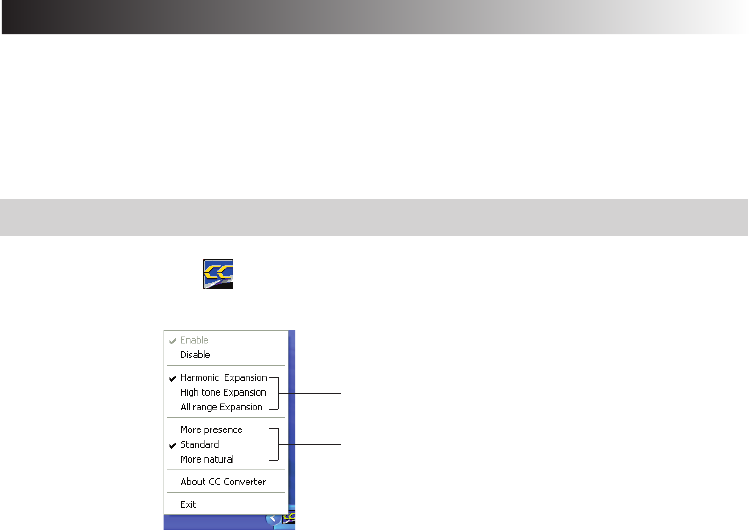
EN 27
About the expansion effect modes
(see next page for details)
About the intensity
(see next page for details)
CC Converter
This is a data-band expansion system JVC has developed for audio applications. It reproduces
the timbre of the original sound from high-quality and compressed music data as well.
The CC converter operates as a system filter so that it takes effect regardless of the playback
application.
To make the effect valid or invalid or to change the effect level:
1. Open a shortcut of (CC Converter) icon in the task tray (by clicking the right
mouse button).
2. When the menu above appears, click on the desired option.
Cautions
•If you have disabled the effect, the CC Converter icon is shown in monochrome color in the
task tray.
•The actual sound playback may slightly be delayed due to processing of playback data.
Explanation of menu options
•Enable
Makes the CC converter processing valid.
•Disable
Makes the CC converter processing invalid.

28 EN
The following menu options are effective only when you have checked the “Enable”
option.
About the expansion effect modes
One of the following three effect modes can be selected.
Each has its own special characteristics as described below depending on the frequency band
pattern which is to be expanded.
•Harmonic Expansion
Expanding the harmonic components contained in music accentuates the lingering tones
and gives the sound an added brilliance. This mode is particularly suited to vocals and
music made by acoustic instruments. It can have an effect on almost all genres of music,
and it is the mode which is normally used.
•High tone Expansion
Expanding the high-tone components enhances the feeling of the sound’s resolution. It is
particularly suited to hard-sounding types of music made by electronic instruments. With
rock or pop music, you can enjoy a more lively sound.
•All range Expansion
This provides an expansion effect over all the range contained in the music. Since there is
no focus on a particular point to be expanded, the CC converter can have an effect with all
types of music.
About the intensity
One of three menu options can be selected as the intensity level of the effect to be exerted by
the CC converter. It is recommended that you select the level of intensity that matches the size
of the speakers that will reproduce the sound, the performance of the headphones and type of
sound data (compressed or non-compressed).
•More presence
The CC converter functions to have the maximum effect.
The “More presence” level is suited to playing back compressed music data through the PC’s
built-in speakers or other small-sized speakers. With some types of music, the noise may be
accentuated in which case the “Standard” or “More natural” option should be selected.
•Standard
With the “Standard” level, the CC converter exerts an effect which is suited to listening to
compressed music data through headphones or mini audio components. This is the setting
which is normally used.
•More natural
The CC converter functions to reproduce the original sound with the highest possible fidelity.
The “More natural” level is suited to listening to non-compressed high-quality data through
large-sized speakers.
JVC ORIGINAL SOFTWARE AND SYSTEM APPLICATIONS

EN 29
•About CC converter
Shows the CC converter version and other information.
Click [OK] to close the displayed subwindow.
•Exit
Quits the CC converter. The CC converter status you have set at this point is held. If you wish
to restart the CC converter, you can start up the program from the Start menu.
Cautions
•Do not change the sound playback device when you are playing back the sound data (such
as an audio file).
•If you have changed the sound playback device, wait five (5) or more seconds before playing
back the data.
•The CC converter can process two-channel PCM data only. A sound device may transfer
multi-channel data or non-PCM data, but the CC converter cannot process such data.
•If you play back data having a high noise level, the noise may be emphasized.
•Users other than the computer administrator (even if they have the Administrator’s authority)
may not change the CC converter setup.
PD-TS decorder
This decoder is designed to capture, using a separate personal computer (Pentium 4, 2 GHz or
faster recommended), the data which has been shot in the GR-PD1 HI-RES. mode or PS50 mode
and play the data using the Windows Media(TM) Player 9 of this unit (MP-XP731GB) in a simplified
format (at a speed of about 3 frames per second), and it is pre-installed.
•To uninstall the decoder, select [Add/Remove Programs] and delete it.
•The installer is included on the application CD-ROM so use the CD-ROM provided if you
need to re-install the decoder.
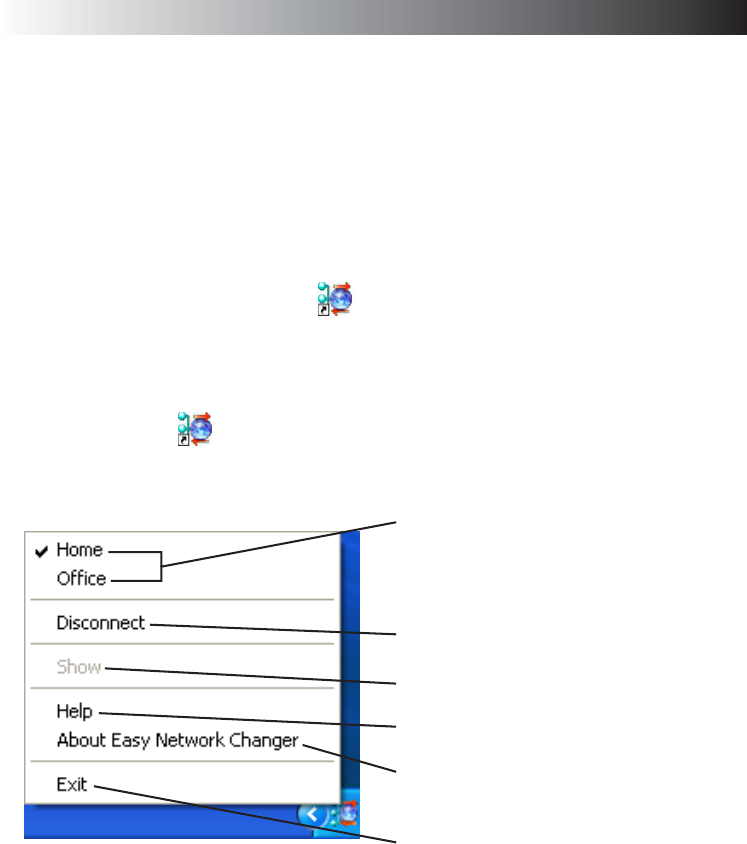
30 EN
JVC ORIGINAL SOFTWARE AND SYSTEM APPLICATIONS
Easy Network Changer
The Easy Network Changer is a network setting utility which enables network settings to be
changed easily.
This utility makes it possible to register a multiple number of profiles that define the network
settings for use at home, in the office or other connection locations. When InterLink has been
moved to a different network environment, it allows easy connection to a network by selecting
the corresponding profile.
To start the utility
Double-click the Easy Network Changer icon on the desktop.
The profile management screen now appears. To register a profile, click [New] and follow the
instructions given by the Wizard. Once a profile has been registered, it can be selected from the
profile management screen and the network settings can be changed. An easy way to change the
network is to click the icon on the task tray and select the profile from the menu which is
then displayed.
The registered profiles are displayed, and the
network is connected by selecting one of
these profiles. (The check mark indicates
the profile which is being used.)
This is used to disconnect the network.
This is used to display the help information.
This is used to display the version
information.
This is used to exit the Easy Network
Changer.
For details on how to use the utility, refer to the utility’s help information.
This is used to show the main menu.
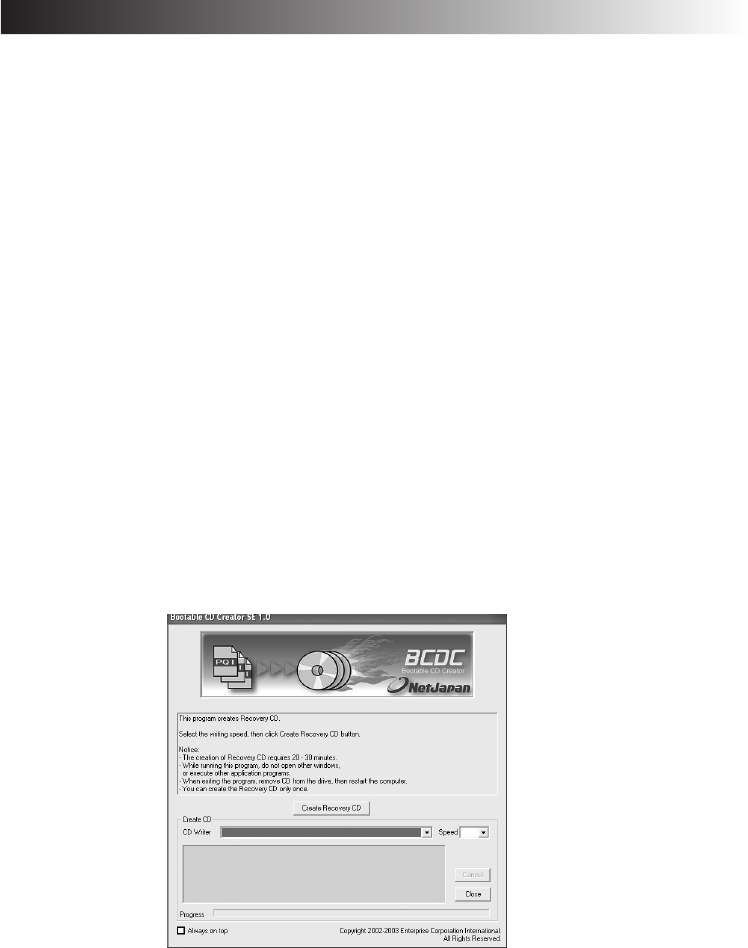
EN 31
Using Bootable CD Creator (BCDC)
1. To create the removable recovery CDs using Bootable CD Creator (BCDC), connect
the DVD-ROM & CD-R/RW drive to Interlink.
2. Once the DVD-ROM & CD-R/RW drive has been recognized, click [Start] [ [All
Programs] [ [BCDC SE] to start BCDC.
3. Select the writing speed, and press the “Create Recovery CD” button.
4. The “Once you have successfully created Restore CD, Create Restore CD function is
no longer available. Continue?” message now appears. Select “Yes.”
5. The number of CD-R discs required is displayed. When the CD-R discs have been
readied, click “OK.”
6. When the “3 blank CD-R/RW media are required. Continue?” message appears,
insert one of the CD-R discs into the drive, and press OK.
(The screen on which the blank CD automatic execution is selected may appear. If it
does, cancel it.)
7. Data writing now starts. The “3 blank CD-R/RW media are required. Continue?”
message will appear again so replace the disc in the drive. In this way, the procedure
for creating the recovery CDs is completed.

32 EN
STANDARD APPLICATION
Your Mobile PC has the following standard applications. Open the Help menu of each application
to check the application usage. If you have any question, contact the nearest support centre
listed on Page 98.
•Adobe Reader 6.0
Can display and print out a PDF file.
Using the Adobe Reader, you can display and print out a PDF format file.
•Norton AntiVirus 2004
The software to prevent virus infection from the Internet.
This is a highly reliable antivirus program. It can automatically restore your system from virus
infection without interrupting your current works. This program prevents the spread of viruses
as it checks for virus infection during e-mail reception and transmission. Also, it can prevent
the script-based virus infection even if you have not yet updated it to the latest antivirus
definition.
Cautions
•At the third startup after the Windows initial setup, a Norton AntiVirus Information Wizard
screen appears. Follow the on-screen instructions to set up this application program.
•You can update the antivirus definition file of this application within 90 days.
•ImageMixer with VCD 1.1 VJ
Can edit an original movie.
You can pick up movie pictures using a digital video camera (DVC) and edit them by using the
effects when you switch scenes, inserting a still image, and adding after-recording sound and
BGM.
The edited movie is recorded in the MPEG1 format, and its file size is smaller than the DV
format file. You can distribute the movies to your friends to enjoy the camcorder playback.
Furthermore, Video CDs can easily be created from MPEG1 data so that images of cherished
memories can be reproduced on the TV screen or PC screen.
Cautions
•For communication using the USB connection, this software is supported by JVC’s digital
video camera with the GR-DVP9EK and later model numbers. (It is also supported by old
model numbers i.Link is used for communication.)
•The functions for creating DVD Videos are supported if they are updated. (A fee will be
charged for the updating facility.)
•As this software is a hybrid application, read the items relating to the Windows OS when
you check the Help menu.
•RealOne Player
Can play back a video file.
The RealOne Player can play back some video files not supported by the Windows Media
Player (included in the Windows XP OS).
JVC ORIGINAL SOFTWARE AND SYSTEM APPLICATIONS

EN 33
•PINNACLE STUDIO 8 SE
The video editing software for the broadband age.
This software makes it possible to capture moving pictures or still pictures from a digital video
camera or digital camera, add various video effects and output them to a digital video camera
or create movies in a variety of formats.
The software comes with authoring and writing functions for DVDs, VCDs and SVCDs so that
finished movies can be viewed on a home-use DVD player, for instance.
Note:
•With Pinnacle Studio 8 SE which is supplied with this PC, frame loss may occur in the created
moving images when transitions (editing function effects) are inserted.

34 EN
To Set Up the Standard Applications Again
You can set up the standard applications using the Application CD-ROM. (The optional
CD-ROM drive is required.)
If you have erroneously deleted any of the standard applications, you can reinstall it from the
Application CD-ROM. For details, see the “readme.txt” file in the Application CD-ROM.
Warning
•Use the standard CD-ROMs only on the CD-ROM drive. Otherwise, your
ears or speaker system may be damaged due to loud noise.
To Uninstall a Standard Application
Use the following procedure to uninstall a standard application program.
1. Click the [start] button, then [Control Panel].
2. Click the [Add or Remove Programs] icon.
The programs currently installed are listed.
3. Click an application program you want to uninstall. Click the [Change/Remove]
button.
4. When you see a “Are you sure you want to remove ...?” message, click [Yes].
5. The uninstaller will remove the selected application program.
JVC ORIGINAL SOFTWARE AND SYSTEM APPLICATIONS

EN 35
NAVIGATE IN THE
INTERNET WORLD!
3

36 EN NAVIGATE IN THE INTERNET WORLD!
TO CONNECT TO THE INTERNET
You must contract with an Internet service provider. Also, you need to have a telephone line to
be connected to the service provider.
Contracting with the Internet Service Provider
An Internet service provider (an enterprise or an organization that provides the Internet connection
and related services) is generally called a “provider.”
•Contract with the provider
Get the information about the sign-up to the provider, connection fee, service contents and
other information from an Internet magazine.
We recommend that you compare available services and select the provider that best fits your
needs.
•If you have already contracted with a provider
You can use your provider accounts (such as user ID and password) on your PC.
•When you have contracted with a provider
You will receive a document showing your user ID, password and e-mail address. Keep this
document to hand when you set up the Internet connection.
Caution
• You may need a credit card when contracting with some providers.
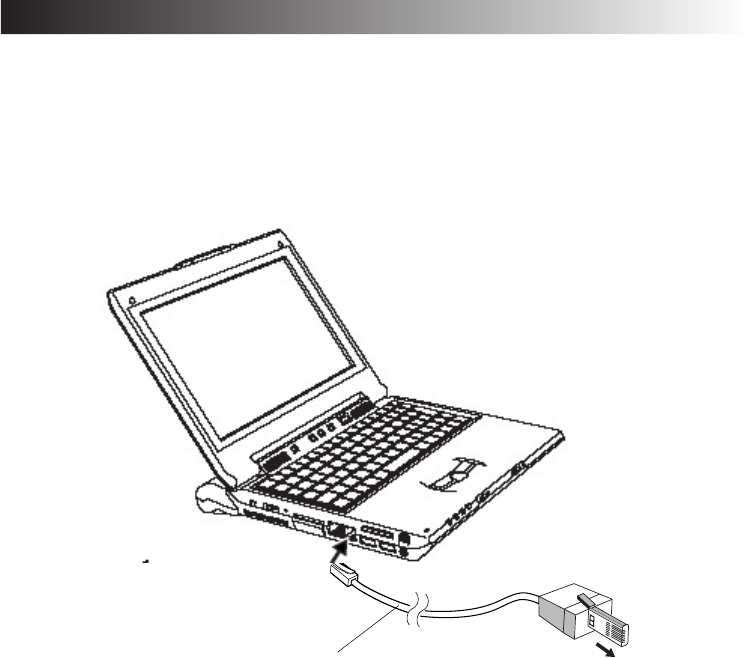
EN 37
Connection of Telephone Line and Modem Setup
Your PC has a built-in modem and a cable attached to it. You can enjoy the Internet and e-mail
services by simply connecting your PC to the telephone line.
1. Plug the attached modem cable into the Modem jack of your PC until it clicks.
Insert the cable connector into the jack in the correct direction.
Modem cable
2. Plug the other end of the modem cable into the telephone line wall jack.
If a telephone set is already connected to the telephone line, unplug the cable of the telephone
set.
Tips
Purchase a line splitter if you wish to plug in your telephone set and your PC to the same
telephone line. Remember that you cannot use the telephone set and The Internet services
simultaneously even if you have installed the line splitter.
to modem jack
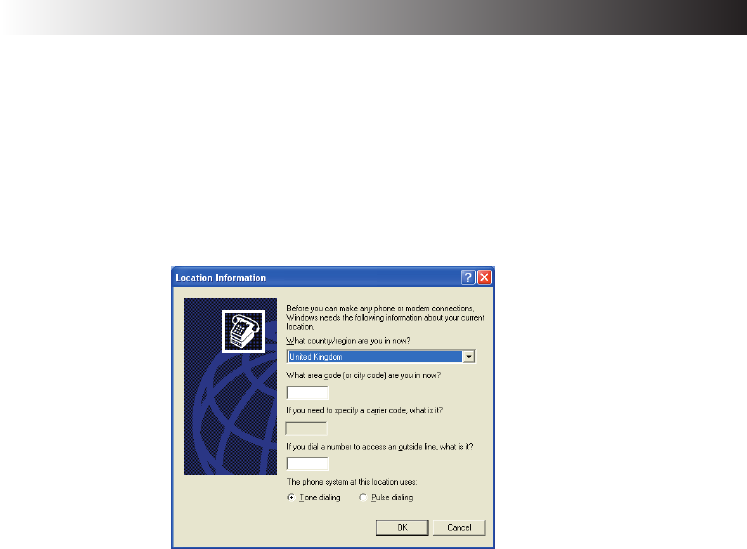
38 EN
3. Seting up the modem
1Click [start] and [Control Panel] in this order.
2Click [Printers and Other Hardware].
3Click [Phone and Modem Options].
4When the “Location Information” screen appears, enter a city code in the “area code”
field. Usually, enter your city code here.
Enter the phone company ID number and extension number as necessary. (They are
usually not required.)
5Check the dialing type of your telephone line, and select it correctly.
6Click [OK], and the “Location Information” screen will close. Modem setup will be
complete.
NAVIGATE IN THE INTERNET WORLD!
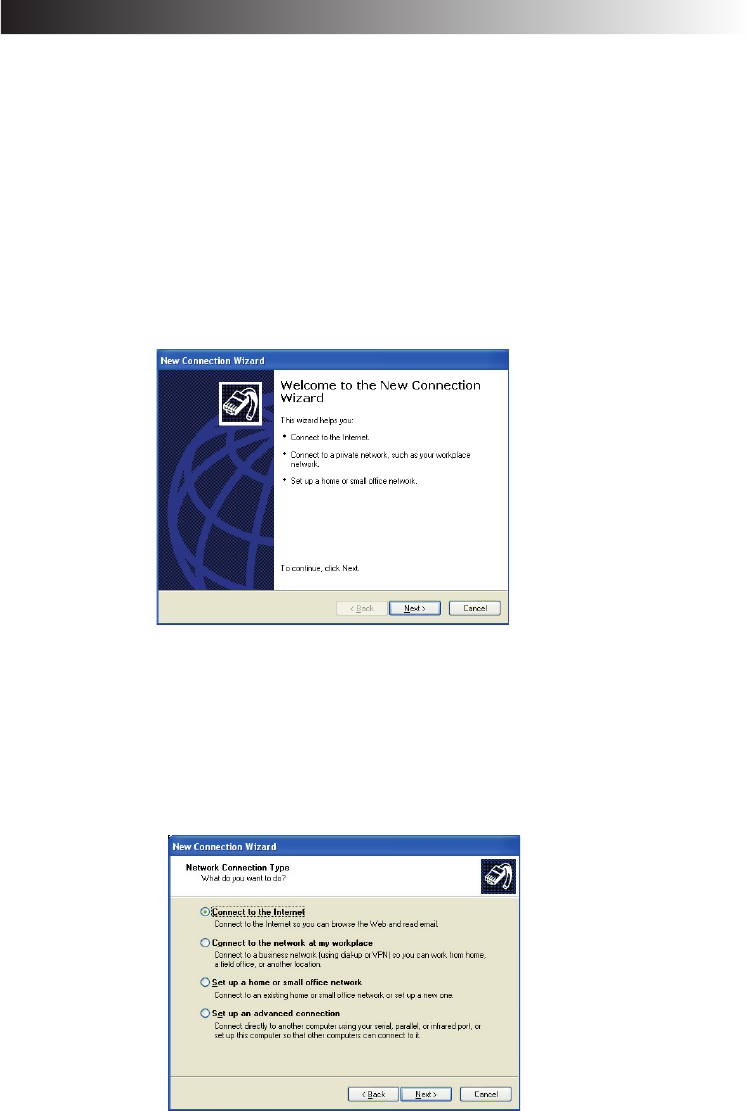
EN 39
The Internet Connection Setup
Use the following procedure to connect your PC to the Internet network. This setup example
uses the built-in modem of your PC and Microsoft’s Internet Explorer (IE) for the Internet
connection. If you have already contracted with a provider, you can manually set up the Internet
connection using the following procedure.
Tips
As your PC has networking functions, you can connect it to the Internet via the network. For the
setup procedure, when you connect to the Internet via a network, see Page 63.
1. Click [start] and then click [Internet] in the upper left part of the Menu.
The “Welcome to the New Connection Wizard” screen will appear.
Tips
If the “Welcome to the New Connection Wizard” screen does not appear, click the [start] button
and select [All Programs], [Accessories], [Communications] to start [New connection wizard].
2. Click [Next].
The “Network Connection Type” screen will appear.
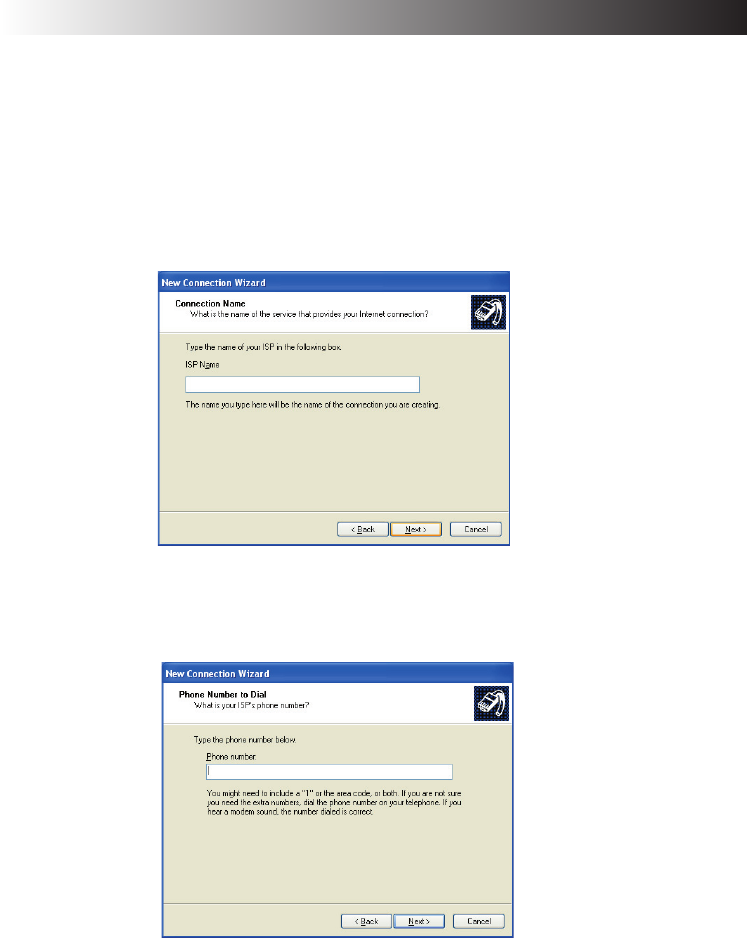
40 EN
3. Click [Connect to the Internet] option, and click [Next].
The “Getting Ready” screen will appear.
4. Click [Set up my connection manually] option, and click [Next].
The “Internet Connection” screen will appear.
5. Click [Connect using a dial-up modem] option, and click [Next].
The “Connection Name” screen will appear.
6. Enter the “ISP name” and click [Next].
The “Phone Number to Dial” screen may appear.
Tips
It is convenient to use the contracted provider name as the ISP name.
NAVIGATE IN THE INTERNET WORLD!
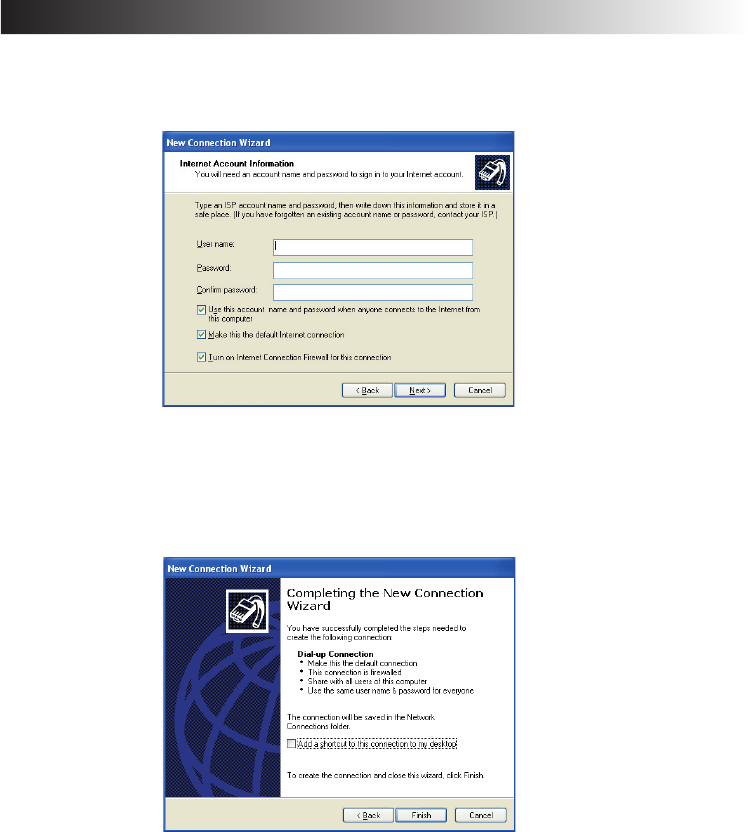
EN 41
7. Enter the phone number, and click [Next].
The “Internet Account Information” screen will appear.
8. Enter the User name and Password (and enter the password again for confirmation),
and click [Next].
The “Completing the New Connection Wizard” screen will appear.
9. Click [Finish]. The setup for connection wizard is complete.
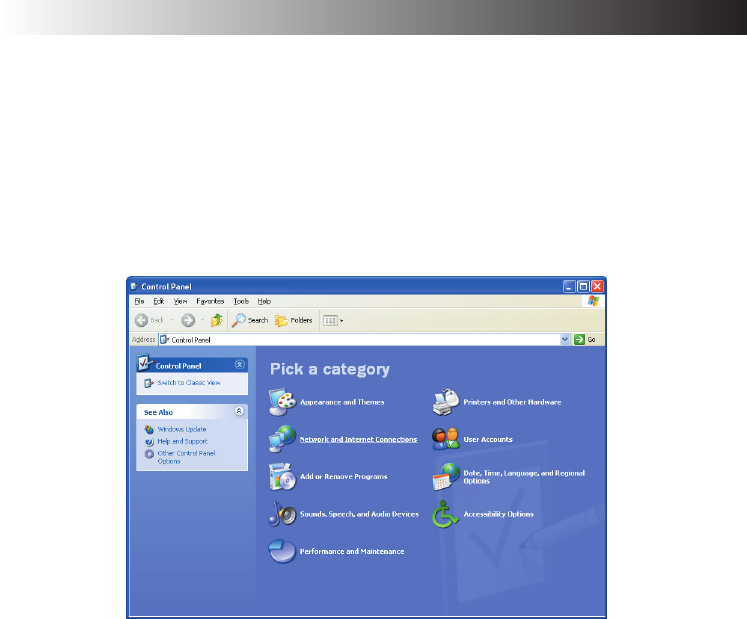
42 EN
Tips
If you need to set up the DNS server address, follow steps 10 to 20.
You may need to set up DNS server addresses (the primary and secondary DNS addresses)
for some providers. If the DNS server addresses are stated on the documents sent from your
provider, you need to set them up. If not specified, you need not set these addresses.
10. Click [start] and [Control Panel] in this order.
The “Pick a category” screen of the Control panel will appear.
11. Click [Network and Internet Connection] icon.
The “or pick a Control Panel icon” screen will appear.
12. Click [Network Connections].
The ISP name you have set in Step 6 is shown in the “Dial-up” tag.
13. Double Click the dialup connection icon.
[Connect ***] screen will appear.
14. Click [Properties].
The “Dial-up Connection Properties” screen will appear.
NAVIGATE IN THE INTERNET WORLD!
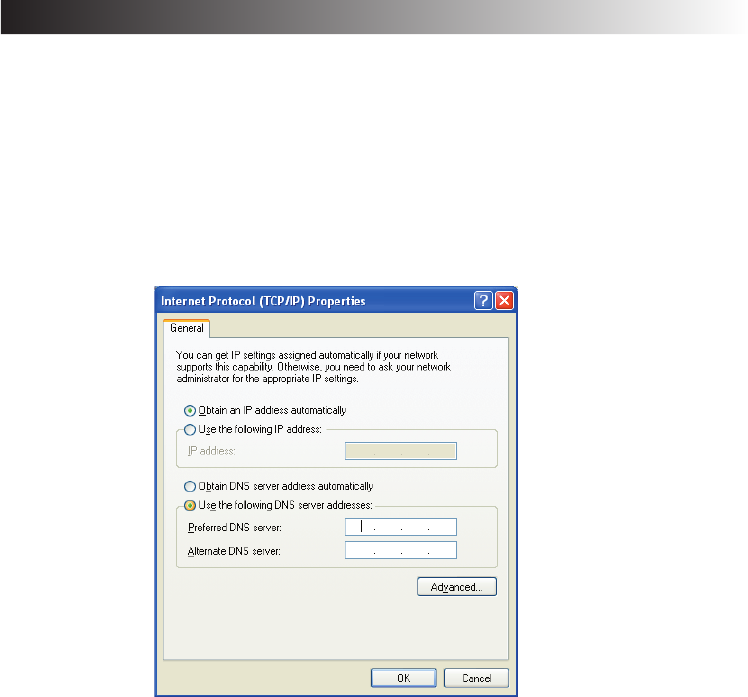
EN 43
15. Click [Networking].
16. Click [Internet Protocol (TCP/IP)] and click [Properties].
The “Internet Protocol (TCP/IP) Properties” screen will appear.
17. Click [Obtain an IP address automatically], click [Use the following DNS server
addresses], and enter the DNS server address printed on the document sent from
the provider.
18. After you have entered the addresses, click [OK].
19. Respond with [OK] to the “Dial-up Connection Properties”.
20. Click [x] at the upper right corner of the “Network Connection” screen.
All screens will close and the Internet connection is complete.
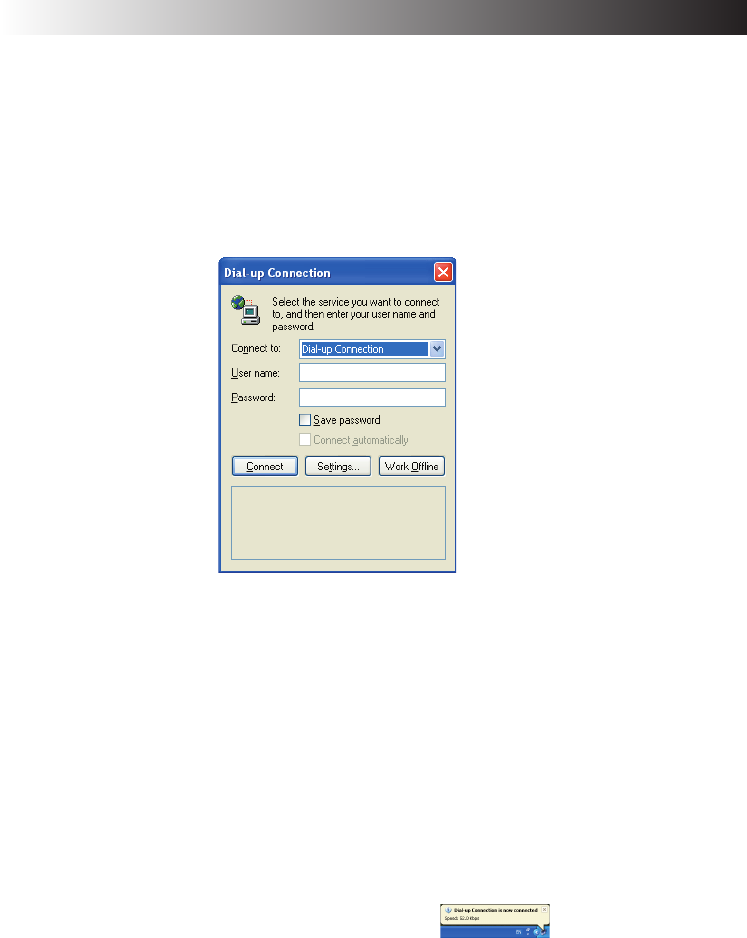
44 EN
Connecting to the Internet
After you have completed the “The Internet Connection Setup” procedure (pages 39 to 43), you
can connect to the Internet. Use the following procedure.
1. Click [start] and click [Internet] at the upper left part of the Menu.
The Internet Explorer will start up and the “Dial-up Connection” screen will appear. If the
“Dial-up Connection” does not start, use the following steps.
1Click [start] and right click [Internet] at the left upper end of the Menu. Then, select
[Internet Properties].
2Click the [Connections] tab and make sure that the ISP name (you have created in Step 6
“The Internet Connection Setup” on page 40) has been set to default in the [Dial-up and
Virtual Private Network settings]. If not set as default, select the ISP and click [Set Default].
3Click [Always dial my default connection], and click [OK].
2. Click [Connect].
The dialup connection process will start and your PC will be connected to the Internet.
Tips
When your PC is connected to the Internet, the icon appears in the Task tray
at the bottom right corner of the desktop screen.
NAVIGATE IN THE INTERNET WORLD!
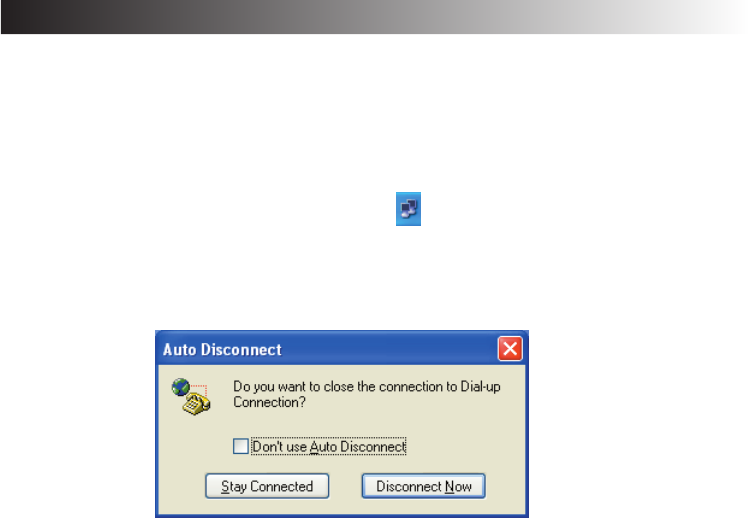
EN 45
Disconnection from the Internet
When you are connected to the Internet, the use of the telephone line and the access to the
provider are charged.
Disconnect your PC from the Internet in one of the following ways when you are finished using
the Internet.
•Double-click the task tray connection icon at the bottom right corner of the desktop
screen. When the “Auto Disconnect” dialog box appears, click [Disconnect Now].
•Quit the Microsoft’s Internet Explorer (IE). When the “Auto Disconnect” dialog box appears,
click [Disconnect Now].
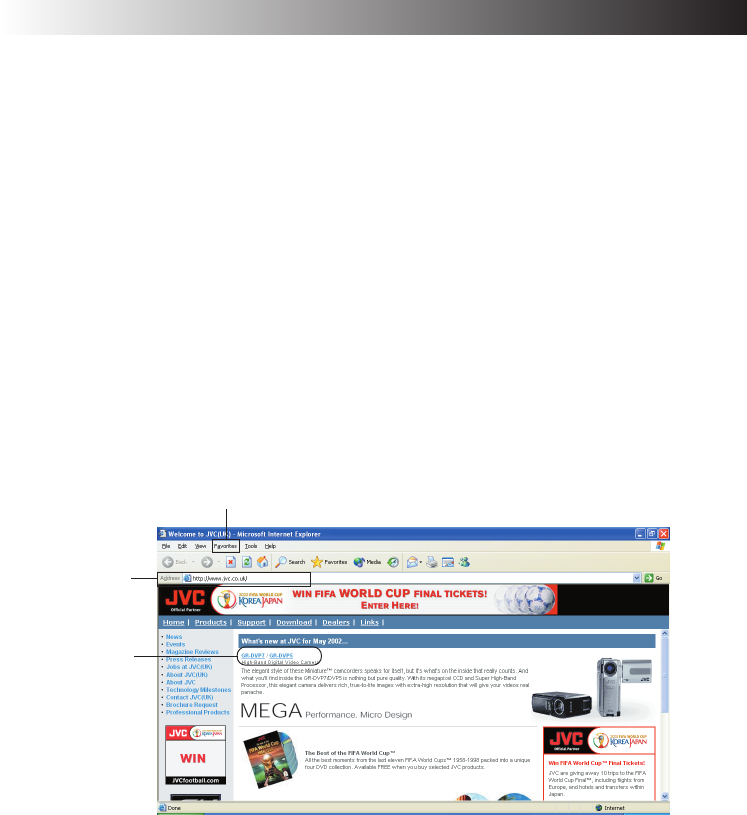
46 EN
Accessing a Web Page
There is a large number of Web sites available. You can access a Web site using Microsoft’s
Internet Explorer in your PC. The following shows three typical ways you can use to access a
Web site.
Before starting the following steps, connect your PC to the Internet using the “Connecting to
the Internet” procedure on Page 44.
When Microsoft’s Internet Explorer is active, you can access a Web site in one of the following
ways.
1. Directly enter the URL in the address bar.
2. Jump to the destination link.
3. Click [Favorites] and select Call a Web site from the Favorites.
Method 1
Method 2
Method 3
NAVIGATE IN THE INTERNET WORLD!
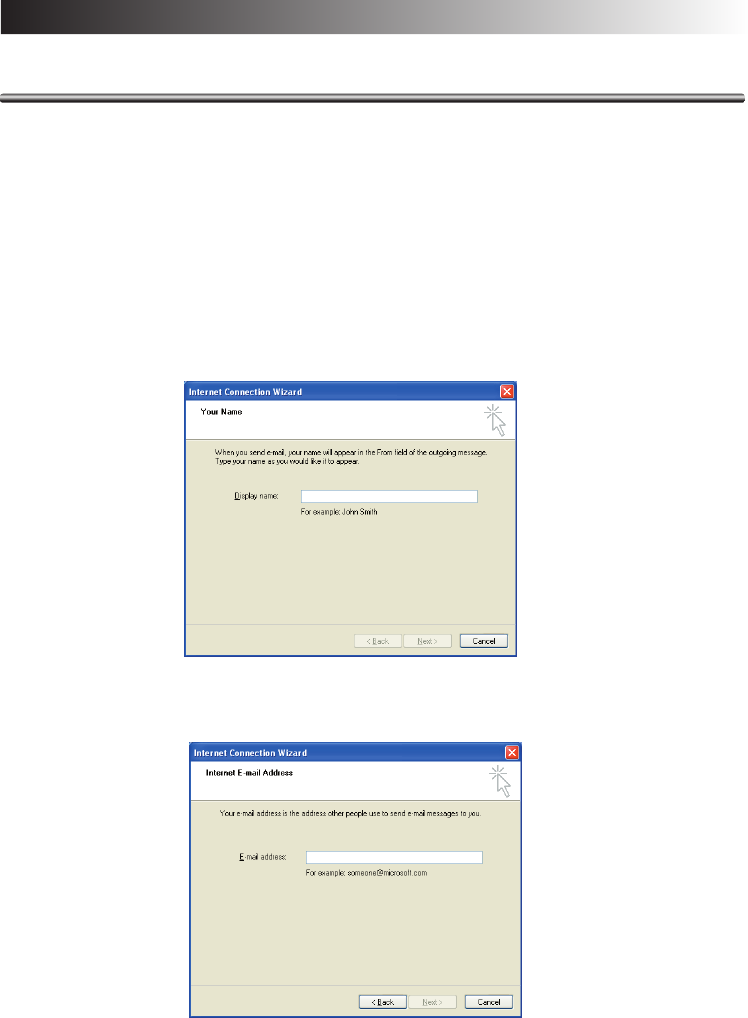
EN 47
E-MAILING
You need to set up a mailing software to send and receive E-mails.
Setting Up E-Mail Software
Set up the E-mail transmission using the Outlook Express installed on your PC.
Tips
It is convenient for E-mail setup if you have the document sent from the provider to hand.
1. Click [start] and click [E-mail] on the Menu.
Outlook Express will start and the “Internet Connection Wizard” screen will appear.
2. Enter the name you wish to display in the “Display name” and click [Next].
The “Internet E-mail Address” screen will appear.
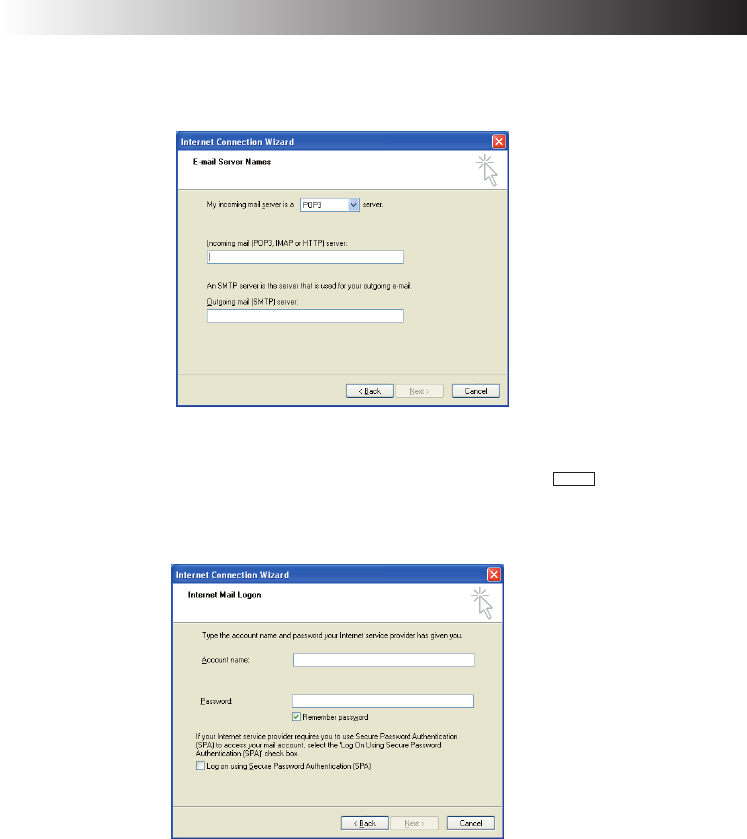
48 EN NAVIGATE IN THE INTERNET WORLD!
3. Enter your E-mail address in the “E-mail address” field, and click [Next].
The “E-mail Server Name” screen will appear.
4. Enter the “Incoming mail server” and “Outgoing mail server”, and click [Next].
Usually select “POP3” as the “My incoming mail server is a server.” but you
can change it if necessary.
The “Internet Mail Logon” screen will appear.
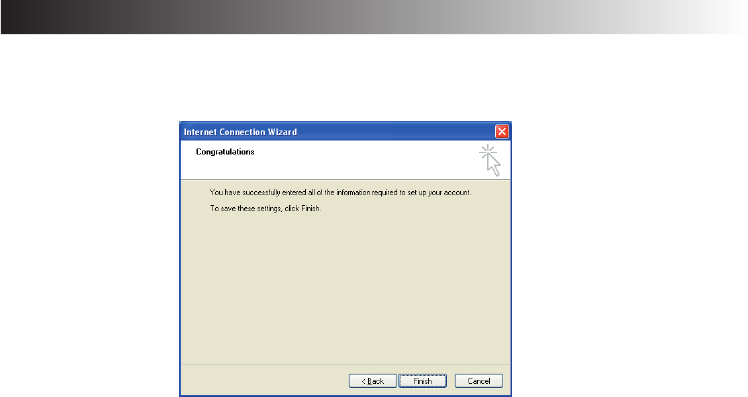
EN 49
5. Enter the “Account name” and “Password,” and click [Next].
The “Congratulations” screen will appear.
6. Click [Finish].
The “Congratulations” screen will close, and Outlook Express will start up.
The setup for the E-mail software is complete.
7. To quit Outlook Express, click [x] at the upper right corner of the screen.
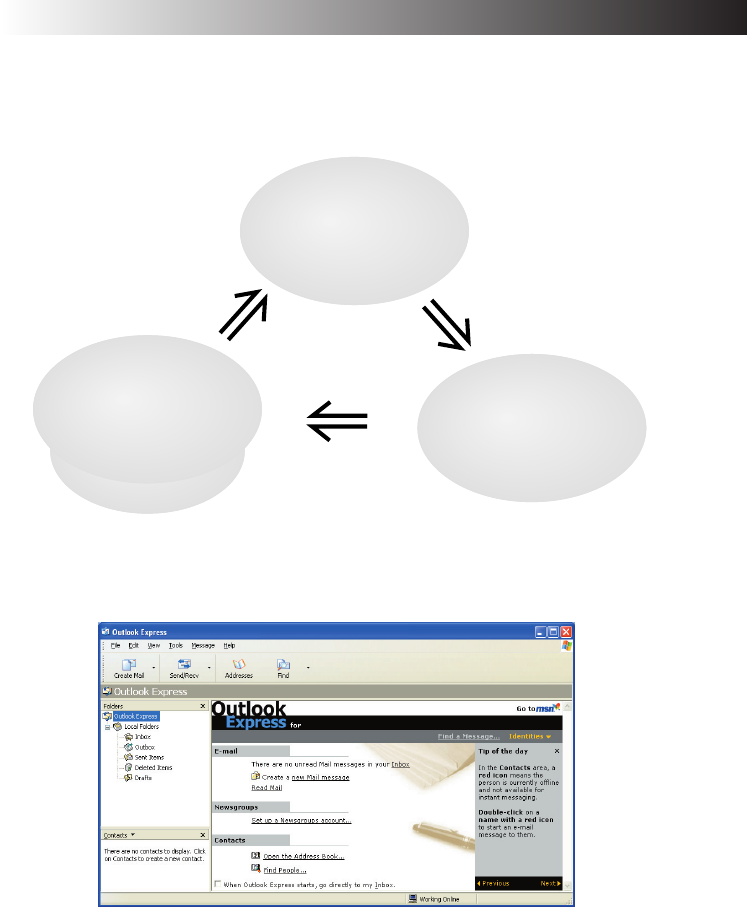
50 EN NAVIGATE IN THE INTERNET WORLD!
Sending and Receiving E-mails
You can create and send E-mail messages, and receive and read E-mail from others. You can
learn procedures to enjoy E-mailing. Use Outlook Express installed on your PC for E-mail
transmission.
1. Click [start] and click [E-mail] on the Menu.
Outlook Express will start.
2. Click [Create a new Mail message] on the screen or click [Create Mail] in the
toolbar.
The “New Message” screen will appear.
Tips
To minimize the access fee to the provider and the use of the telephone line, create your
E-mail messages before connecting to the Internet.
Disconnect from the provider.
Connect to the provider.
(Create a response/return
E-mail message)
Transmission
Create Read
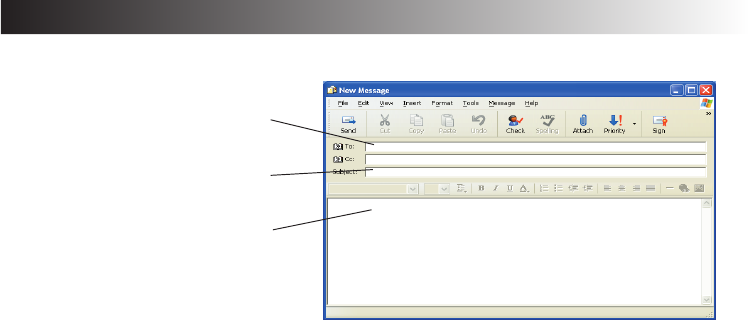
EN 51
3. Create a message.
Destination: Enter the receiver's E-mail address. (Enter your E-mail address first to test
E-mail transmission.)
Title: Enter the message title.
4. Click [Send] at the left upper end of the screen to send the created message.
The “Dial-up Connection” screen will appear.
Tips
If you have already connected to the Internet, the “Dial-up Connection” screen is not displayed
but the message is directly sent when you click [Send].
5. Click [Connect] in the “Dial-up Connection” screen to connect to the Internet.
You will be connected to the Internet, and the created mail will be sent to the specified
address.
6. If your mail transmission is successful, try to receive E-mail. When you are
connected to the Internet, click [Send/Recv] at the left upper end of the screen.
Your PC will be connected to the provider’s mail server and you can receive E-mail.
Assuming you have set your E-mail address correctly in Step 3, you can now receive the test
E-mail you have sent to yourself.
Tips
If message “You are currently working offline. Would you like to go online now?” appears
when you have clicked [Send] or [Send/Recv], respond with [Yes].
Enter the E-mail address
Enter the message title
Enter the message text here
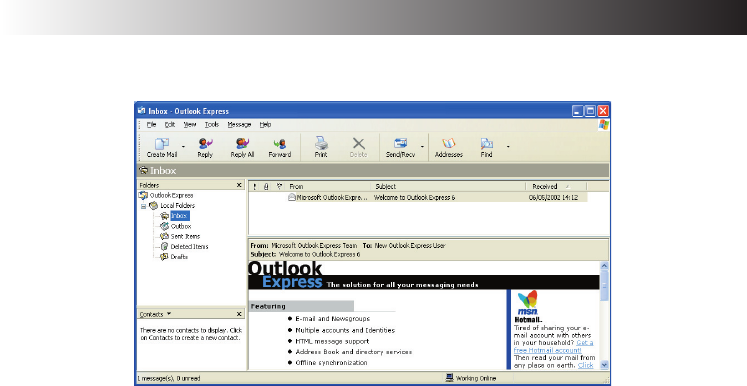
52 EN NAVIGATE IN THE INTERNET WORLD!
7. To check the received messages, click [Inbox] on the screen.
The received E-mail messages will be displayed.
8. To quit Outlook Express, click [x] at the upper right corner of the screen.
Cautions
•Disconnect your PC from the Internet after you have transmitted E-mail and finished
accessing a Web site.
• It may not be possible to send mail properly using a company network or roaming
service. If this problem arises, the method below may solve it.
Before sending the mail, first perform the receive mail operation even if no mail has
been received, and then click [Send].

EN 53
HARDWARE
4
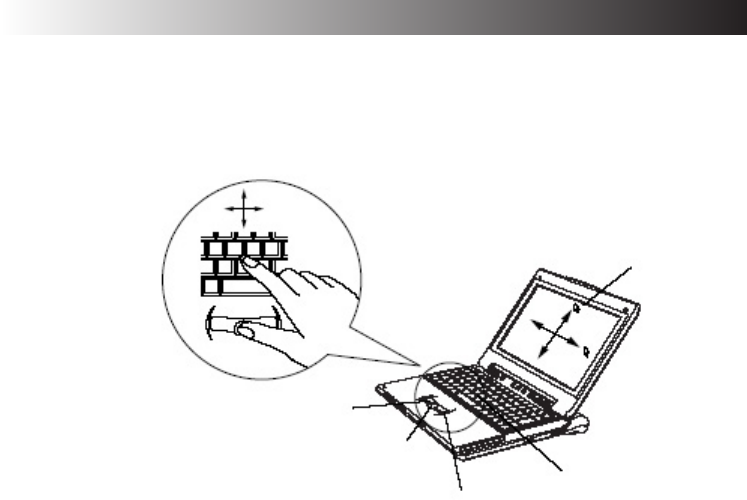
54 EN
Using the Pointing Device
The pointing devices allow you to move the mouse pointer on the screen. You can move the
cursor using the centre stick and three buttons in the similar way as the mouse.
•Stick operations
Usually operate the stick using your index finger. The mouse pointer moves in the direction
you press the stick. You can adjust the pointer moving speed by controlling the power to
press. You can control the speed of mouse pointer movement by changing the pressure to the
stick.
When you press the stick harder, the mouse pointer moves more quickly.
Notes
•If you press the stick slightly and move the pointer slowly for several seconds, the pointer
may return backward. This is not a fault.
•Two stick caps are included in the PC accessory pack. When the cap has deteriorated,
replace it with a new one.
•How to press the buttons
Usually press the three buttons using your thumb.
•Click
Press the mouse left button once and release it immediately.
Use this operation to select a menu option or to press the [OK] or [Cancel] button.
•Right click
Press the mouse right button once.
Use this operation to display a popup menu (called the shortcut).
Mouse pointer
Left button
Scroll button
Right button
Stick
HARDWARE

EN 55
•Double-click
Press the mouse left button twice in succession and release it immediately.
•Drag
Use this operation to move an icon or a file. To do so, select an icon or a file, hold down the
mouse left button and move it to the desired position, and release the mouse button.
Note
The pointing devices have initially been set for the “right-handed person” on the “Mouse
properties” tab.
•Scroll buttons
You can scroll the screen in the desired direction by holding down the scroll button and
moving the stick horizontally or vertically.
Note
Some applications may not support the scroll buttons.
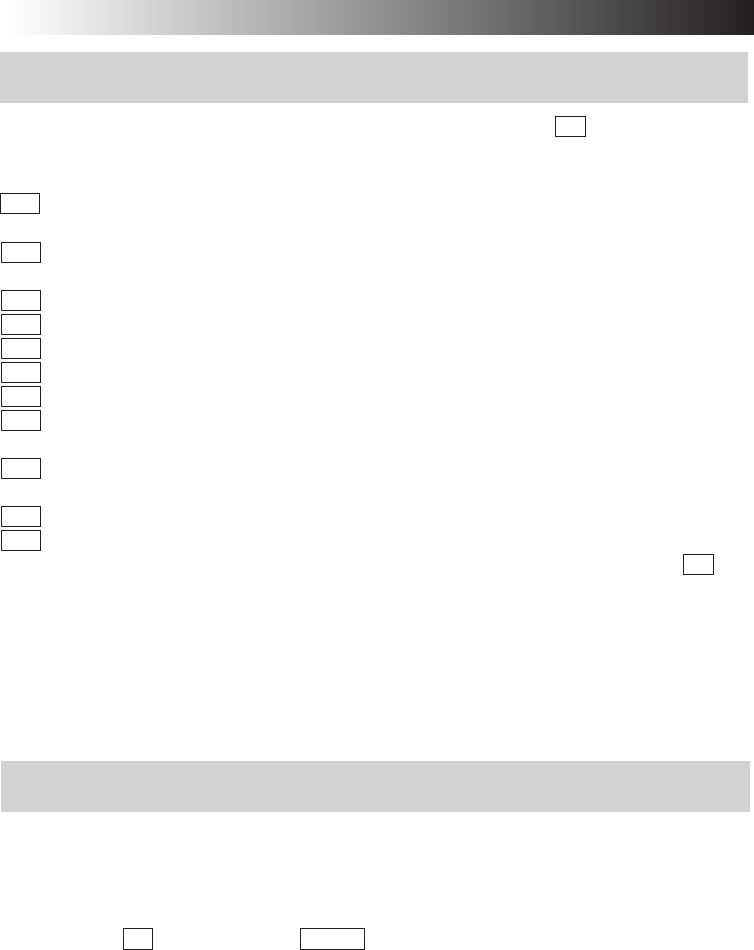
56 EN HARDWARE
Using Hot keys
You can use the coloured hot keys of the PC keyboard. Hold down the Fn key and press one of
the Hot keys to execute its command.
List of hot keys
F1 Reduces the screen brightness level. Use this command to reduce the brightness level if
the screen is too bright.
F2 Increases the screen brightness level. Use this command to increase the brightness level
if the screen is too dark.
F3 Stand by the Mobile PC.
F4 Hibernate the Mobile PC.
F5 Reduces the volume.
F6 Increases the volume.
F7 Turns the PC speaker on or off.
F10 Switches between the LCD display and an external monitor. (Please refer to page 62
about mode switching from LCD panel to CRT display, to LCD plus CRT display.)
F11Turns the Num Lock key on or off. For operation details, see “Using the Numeric Keypad”
of the next section.
F12 Turns the Scroll Lock key on or off.
Ins Issues the Print Screen (PrtSc) command. The screens displayed in the Windows are
copied onto the clipboard. You can select a window and copy it using the Alt key
together.
Notes
•The hot keys are not supported in the MS-DOS environment.
•If a key top has come off, refer to page 57.
Using the Numeric Keypad
Fifteen keys of the keyboard have been assigned to the numeric keypad. Each of these keys has
two labels in different colours to identify their functions. (Blue characters printed on the diagonal
part of the key are numeric keypad keys.)
To use the numeric keypad:
Hold down the Fn key and press the NumLK key. When the numeric keypad is functional, the
Num Lock lamp lights. (See the “Status indicators” on Page 19. Now, you can enter a numeral
printed in blue on the diagonal part of the key.
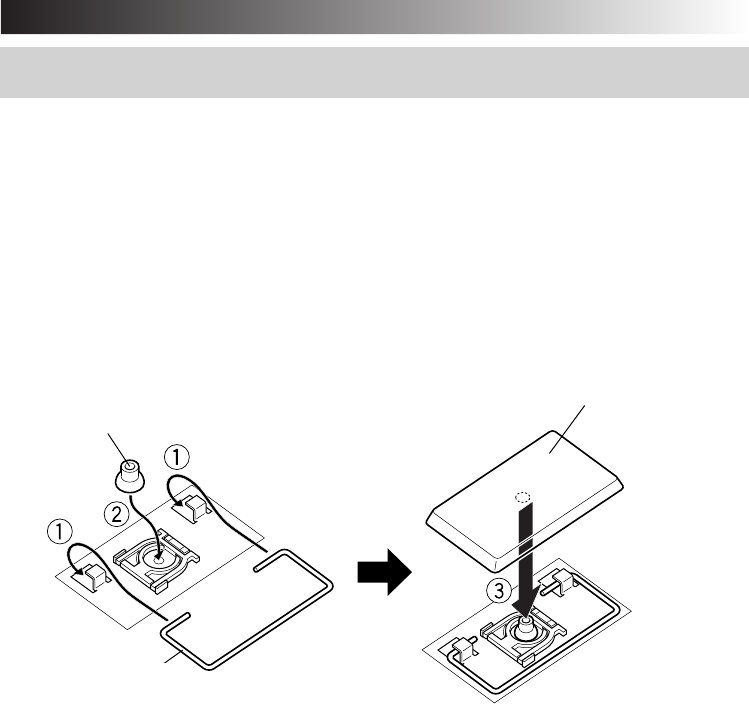
EN 57
If a Key Top Has Come Off
If a key top has come off from the keyboard, put it back in place by following the procedure
below.
•How to attach the Enter key, left Shift key or Space key top
1Take out the disengaged wire rod, and snag it onto the two projections as shown in the
figure below.
2Place the disengaged rubber cushion at the position shown in the figure below.
3Align the centre position of the key top with the centre position of the rubber cushion, and
press the key top down until it clicks into place.
4Operate the key with its key top now in place as you would operate it normally, and check
that it does not come off.
•How to attach any other key top
The wire rod shown above is provided with Enter key, left Shift key and Space key only. When
the key top of any other key has come off, follow steps 2 to 4 above.
Note
•As soon as the key top clicks into place in step 3 of the procedure to attach the key top, do
not apply any further pressure to it or the key may be damaged.
ゴムクッション
ロッド
キートップ
上から「カチッ」と
音がするまで押し込む
Rubber cushion
Wire rod
Key top
Press down until it
clicks into place.

58 EN
Increasing the (Optional) Memory Capacity
You can increase the PC memory capacity up to 768M bytes. For the built-in memory capacity,
see the Product Specifications on Page 101. You can reduce the application startup time and
increase the data process speed by adding an optional memory board.
Consult the JVC PC Technical Support Centre listed at the end of this manual for memory
expansion.
Notes
•Check the memories supported by your PC by accessing:
http://www.jvc.co.uk
The memory boards which have been checked for reliable operations are listed on our
Web site. Any other memory board may not be recognized by your PC or its operation
may be unreliable.
•The PC inside contains precision components. If you have damaged the memory board by
adding a memory, it is not covered by the warranty. Also, if you have damaged your PC,
you will be charged for its repair.
•Take care not to cause excessive static electricity. Do not add a memory board in a place
where static electricity may be generated.
•When you add or replace a memory board, take care not to drop water or other liquids
onto your PC or the memory board. Also, take care not to drop screws or other foreign
materials that may cause the failure of your PC.
•Data stored in the PC may be corrupted or damaged in the following cases.
•The battery is used incorrectly.
•The PC is affected by static electricity or electrical noise.
•The battery has discharged.
•The PC is faulty or under repair.
•The PC is dropped or exposed to severe impact.
•The PC is involved in force majeure including lightning or power failure.
HARDWARE
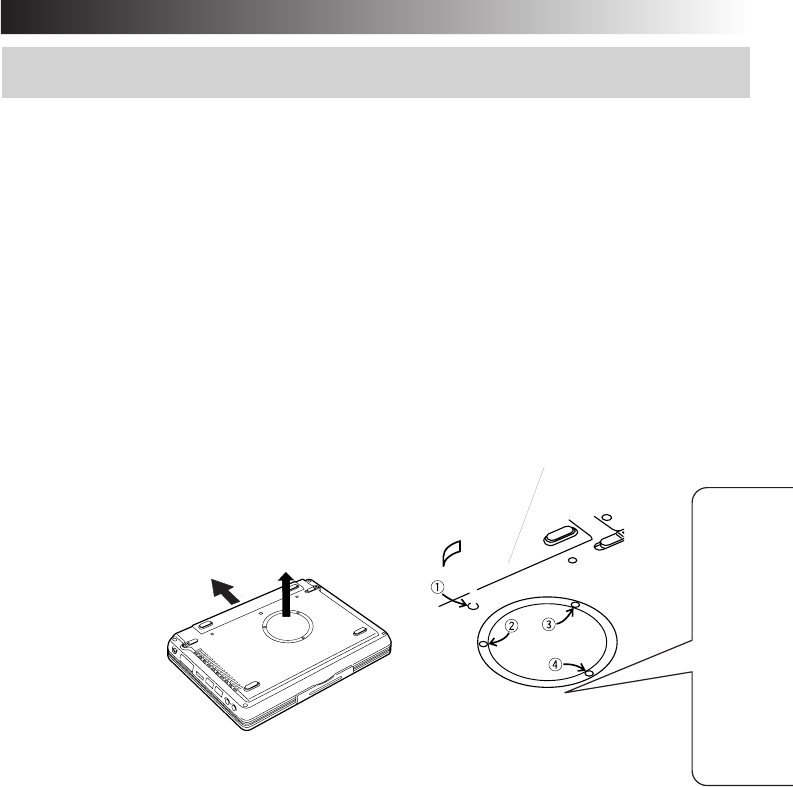
EN 59
Adding or Removing a Memory Board
If you have operated your PC, its inside may be hot and you may get a burn. Turn the power
switch off and wait for the PC to cool down.
1. Turn the PC Power switch off, and disconnect AC adapter from your PC. Then,
remove the standard lithium ion battery pack (if any) and all other peripherals
from your PC.
2. Remove the built-in lithium ion battery pack and the memory expansion cover by
taking the following steps.
1) Turn your PC upside down, and remove screws 1 to 4.
2) Remove the built-in lithium ion battery pack.
3) Open the memory expansion cover.
Cautions
•Screw 1 (10 mm) is different in length from screws 2 to 4 (3 mm). Using a wrong screw can
damage your PC.
•Do not loosen any other screws, otherwise, your PC may fail.
3. Discharge any static electricity from your body by touching something metallic
nearby. (Not on the PC)
4. Add or remove a memory board.
Caution
Add the 256M-byte memory board to expand the PC’s memory capacity of the MP-XP731GB
to the maximum 512M-bytes. Refer to page 60 for the procedure to mount and remove the
memory board.
Built in
battery pack
1)
2) 3)
Remove the
battery pack by
sliding it in this
direction.
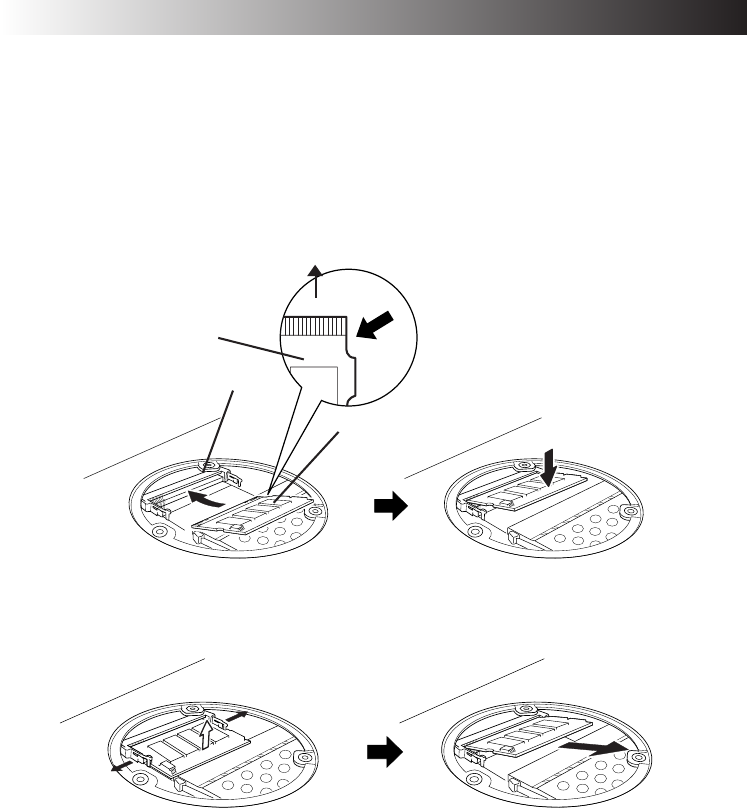
60 EN
1) Mounting a memory board
1Check the correct mounting direction of memory board (by observing the cut area).
2Slant the memory board and insert it into its socket.
3Push the memory board until it is locked, but do not apply excessive force to it.
Caution
If it is difficult to lock the memory board, make sure that the board has been inserted securely.
Do not apply excessive force to it, or the memory board may be damaged.
2) Removing the memory board
1Open the right and left support levers of the memory board by pressing them outward.
2Pull out the memory board in the arrow direction.
5. Return the memory expansion cover, mount the battery pack, and retighten the
four screws.
Caution
The screws have different lengths. Be careful to use the right screw in the right place.
2 3
1
1
1
2
Memory slot direction
Memory board
Memory slot
Memory board
HARDWARE
Position the memory board is such a
way that, when seen from above,
the cut-out is at the tip of the right
corner as shown in the figure.
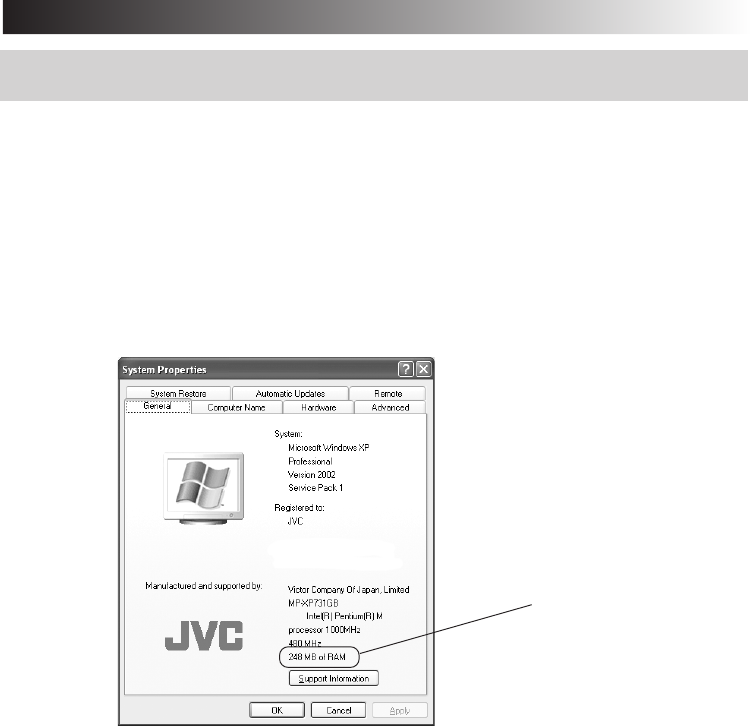
EN 61
Checking the Additional Memory Board
Use the following procedure to check the memory board installation.
1. Turn on your PC and start Windows.
2. Click [start] and select [Control Panel].
3. Click the [Performance and Maintenance] icon.
4. Click the [System] icon.
The “System Properties” screen will appear.
5. The total amount of memory appears on the screen.
•When a memory board has been added, the number indicated by the * location increases.
Note
The size of the video memory (assigned size) is automatically assigned from the main memory
to between 8MB and 64MB depending on the PC’s operating conditions. For this reason, it
cannot be changed manually.
Checking here (*)
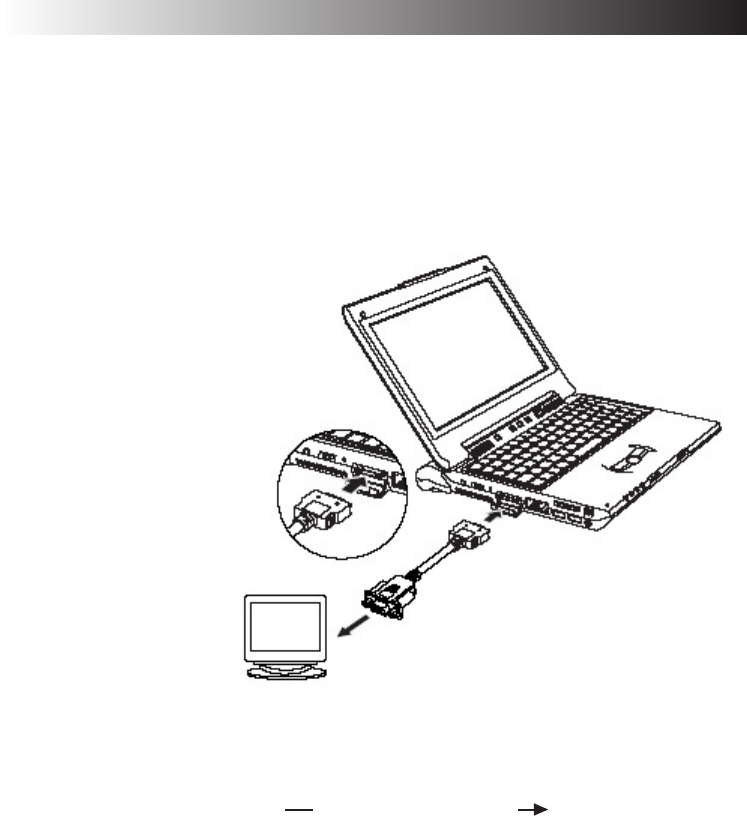
62 EN HARDWARE
Using an External Monitor
To attach an external monitor to your PC, use the MP-VGX3E external display cable.
Connecting an external monitor
When you connect an external monitor to your PC, it looks like an ordinary desktop PC. You can
use the monitor by just connecting it with the MP-VGX3E cable. You can display images on the
external monitor for other people and you can watch them on the LCD panel of your PC.
For switching the display between the external monitor (CRT) and LCD panel of your PC, press
the Fn + F10 keys, and the mode will be switched in the following sequence:
LCD (LCD panel of PC) CRT (external monitor) LCD + CRT
Notes
• To disconnect the external display connecting cable (MP-VGX2E), be absolutely sure to
pull it straight out while pressing the PUSH button at the same time.
• No switching results when the Fn + F10 keys are pressed if the CRT (external monitor)
is not connected.
• Do not disconnect the VGA cable during operation in the CRT (external monitor)
mode. The mode will not be switched by operating the Fn + F10 keys while this cable
is disconnected. To enable the operation of these keys in this state, the VGA cable
must be re-connected. It is a good idea to switch to the LCD + CRT mode first before
disconnecting the VGA cable.
Face the PUSH button
upward.
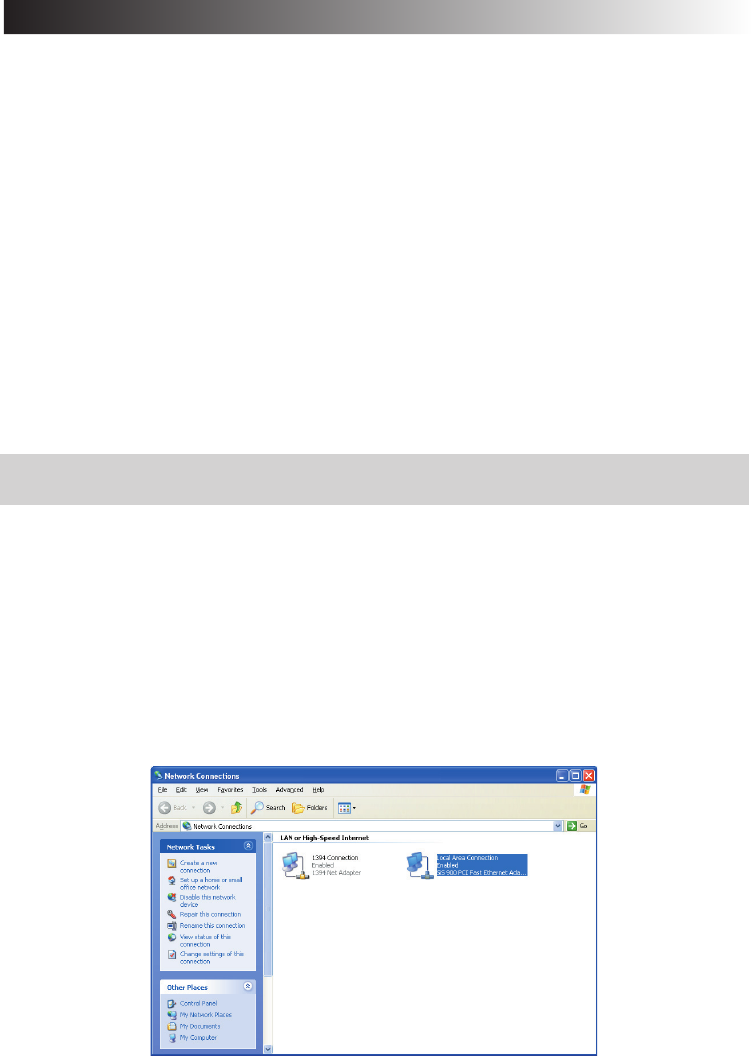
EN 63
Connecting to a Network
With the network function, you can connect to a network at your office or home to transfer data
between PCs and access the Internet from multiple PCs. For setting for intranet connection,
consult a system administrator at your company. Connection to a network requires the following
items.
• LAN cable
• Communication devices including a hub or router
Important
LAN cables are available in straight and cross types. Use a cable of the correct type for your
LAN environment.
You must contract with an Internet service provider.
Using a LAN cable, connect the LAN connector on the unit with a communication device (hub
or router).
See the following for setting.
Setting for Network Connection
•Setting the IP address manually
Important
This PC will acquire the necessary initial settings automatically. When you use this PC in
a home network environment and the IP address is assigned automatically, the following
steps are not necessary.
1 Click the [start] button and [Control Panel].
2 Click the [Network and Internet Connections] icon.
3 Click the [Network Connections] icon.
The “Network Connections” screen will appear.
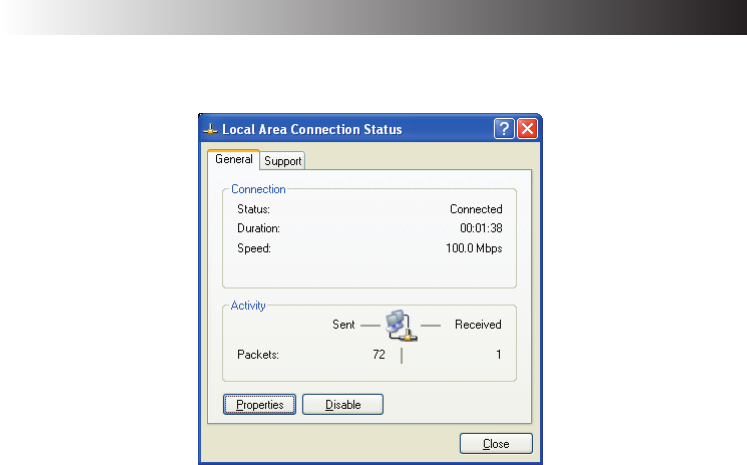
64 EN
4Double-click [Local Area Connection].
The “Local Area Connection Status” screen will appear.
5Click the [Properties] button.
The “Local Area Connection Properties” screen will appear.
6On the [General] tab, double-click [Internet Protocol (TCP/IP)].
The “Properties of Internet Protocol (TCP/IP)” screen will appear.
7Enter appropriate values in the [Use the following IP address] and [Use the following
DNS server addresses] fields.
8Click the [OK] button to save the setting.
•Setting a computer name or work group
Tips
To share data or a printer among a group of computers, you must set the computers in the
same work group. This enables you to transfer data between computers.
1 Click the [start] button and [Control Panel].
2 Click the [Performance and Maintenance] icon.
3 Click the [System] icon.
The “System Properties” screen will appear.
4Click the [Computer Name] tab.
5Click the [Change] button.
6Change the “Computer name”and/or “workgroup” as necessary.
7Click the [OK] button to save the setting.
The “Change in computer name” screen containing the “Welcome to the ***
workgroup.” message will appear.
HARDWARE
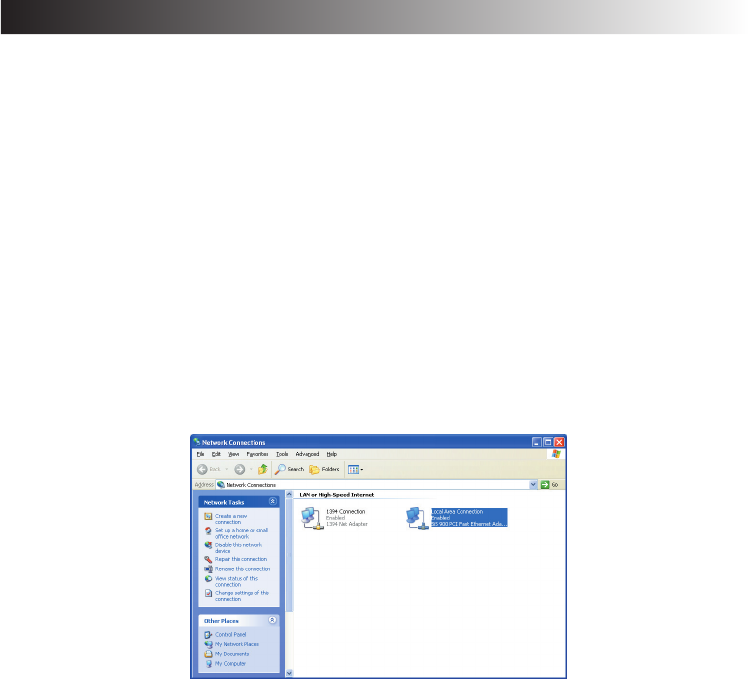
EN 65
8Click the [OK] button.
A message prompting you to restart the computer will appear.
9Click the [OK] button to make the change take effect.
0Restart the computer.
•Checking the MAC address
Use the following procedure to check the MAC address of the internal LAN card.
Important
To check the MAC address, you have to set a LAN (local area) connection in the [Network
connection] screen.
1Click the [start] button and [Control Panel].
2Click the [Network and Internet Connections] icon.
3Click the [Network Connections] icon.
With the correct LAN connection, the following screen will appear.
4Check that [Local Area Connection] is enabled.
Tips
If it is disabled, move the mouse pointer to [Local Area Connection] and press the right
mouse button to bring up a menu, click [Enable] to enable the connection.
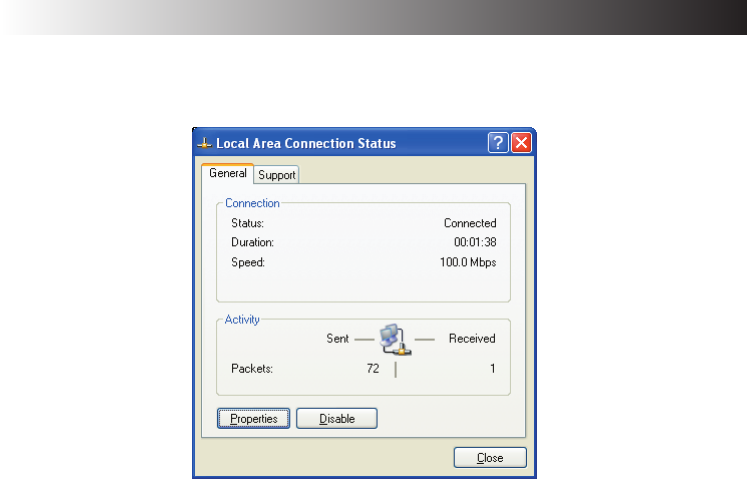
66 EN
5Double-click [Local Area Connection].
The “Local Area Connection Status” screen will appear.
6Click the [Support] tab and the [Details] button.
The “Network Connection Details” screen will appear.
7The MAC address is displayed as the “Physical Address” on the list.
HARDWARE

EN 67
Network Connections Using a Wireless LAN
The model MP-XP731GB PC comes with wireless LAN functions.
You can connect to a LAN system from any location within the wireless communication area to
access the Internal LAN or send and receive mail. By using a wireless LAN access point (available
from a retail store) which is connected to an ADSL modem (available from a retail store), you can
access broadband environments from a multiple number of PCs. Furthermore, you can bring
your PC to one of the public wireless LAN services which have been increasing of late and enjoy
accessing the Internet by wireless means.
For the wireless network settings and details, refer to [Help and Support] on the [Start] menu.
General Description of Wireless LAN
The wireless LAN in this PC supports the following functions.
•Automatic communication speed selection function: 11, 5.5, 2 and 1 (Mbps)
•Frequency channel selection : All 11 channels (2412 to 2462 MHz)
•Roaming between multi-channels
•Power management function
•Compliance with IEEE802.11 and IEEE802.11b standards
Types of Wireless LAN Networks
•AdHoc Mode
In this mode, the data is transferred directly between PCs. It is suited to wireless networks in
which data is transferred between several laptops. The peer-to-peer workgroup setting for
providing equal handling for all the laptops is established.
•Infrastructure Mode
In this mode, the PCs are connected through an access point. If the access point is connected
to an ADSL, CATV, ISDN or other such line, the PCs can be connected to the Internet as well.
XV841
/g
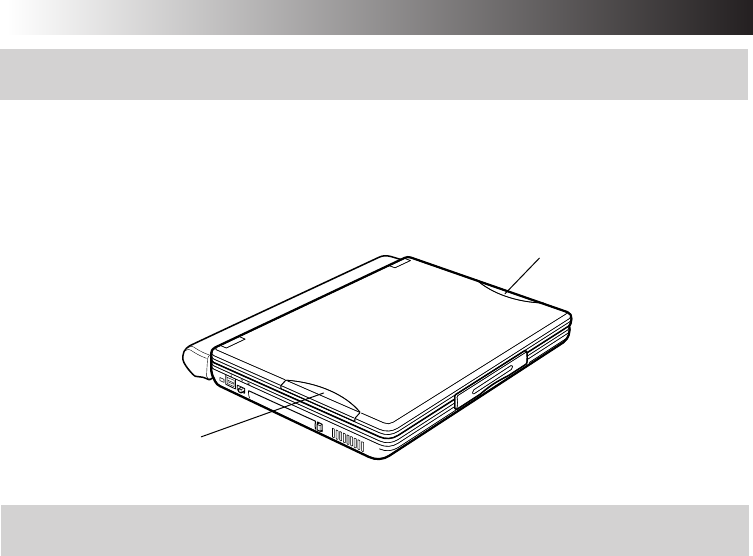
68 EN HARDWARE
Suggestions for Using the Wireless LAN
•Use the wireless LAN in a location where there are as few obstacles as possible. To maximize
the distance over which communication with the wireless LAN is possible, open the display,
and point its reverse side (the side with JVC logo) at the access point. Do not place any
obstacles such as books or thick stacks of paper between the PC and access point.
Setup Procedure for the Wireless LAN
Caution
In order to make it easier to check the operation of the PC’s wireless LAN, start the access point
before proceeding to use the wireless LAN in the infrastructure mode. For use in the AdHoc
mode, start the PC that serves as the other end of the communication where the wireless LAN
settings have already been completed if possible before proceeding to use the wireless LAN in
this mode.
Wireless LAN antenna
Wireless LAN antenna
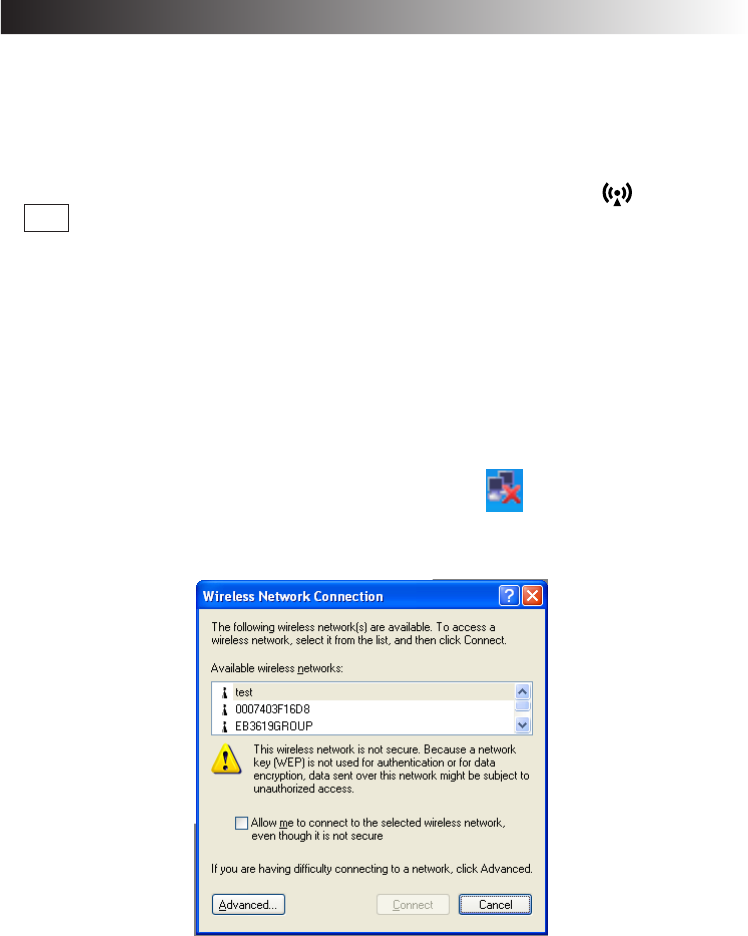
EN 69
1. Start up the PC.
If the [Intel(R) Setting Service] screen appears, click the [No] button.
This message will no longer appear if a check mark is entered for “Do not display
in the future” .
2. Set the wireless LAN to ON using the wireless LAN ON/OFF switch.
The wireless LAN now starts up, and the wireless LAN indicator above the
F10 key flashes while a search is being conducted, and it lights when a
connection is made.
(In order to prevent other electronic devices or equipment in places such as
aircraft and hospitals from being adversely affected, keep the wireless LAN
functions shut down when starting up the PC or restoring its operation from the
standby or hibernation mode.)
3. Set the IP address to be used by the wireless LAN.
This step must be taken only when the wireless LAN is to be used for the first time.
Once the wireless LAN has been successfully connected, jump to step 4 (page 72)
when re-connecting the wireless LAN for the second or any subsequent time.
1Double-click the [Wireless Network Connection] icon on the task tray.
The [Wireless Network Connection] screen now appears.
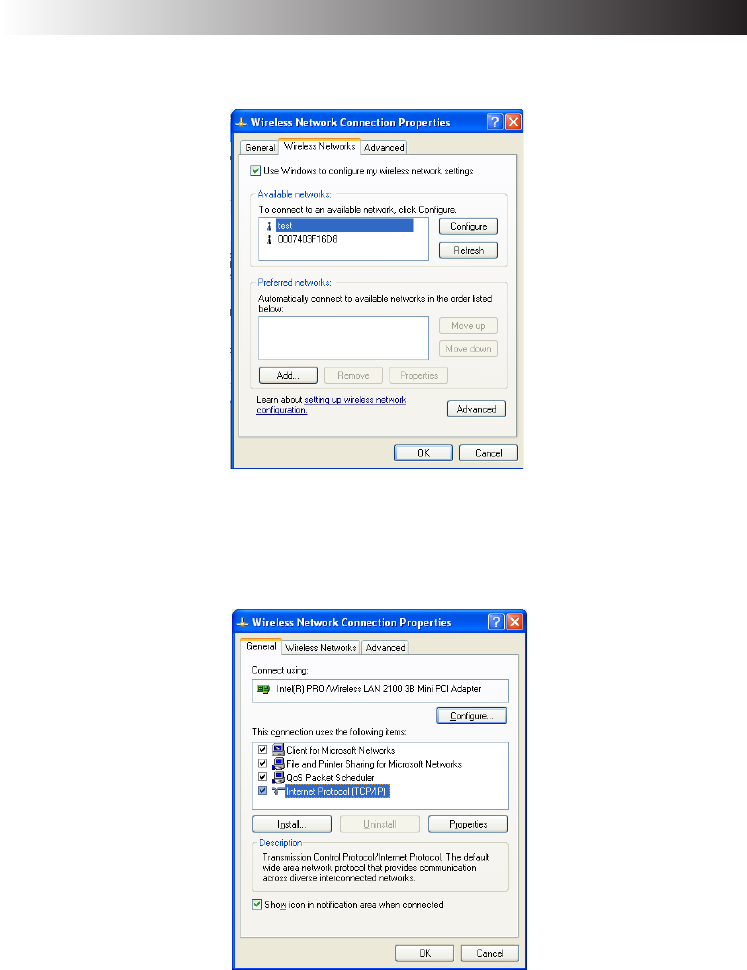
70 EN HARDWARE
2Click the [Properties] button on the [Wireless Network Connection] screen.
The [Wireless Network Connection Properties] screen now appears.
3Click the [General] tab on the [Wireless Network Connection Properties] screen, and
click [Internet Protocol (TCP/IP)] to select the Internet protocol. A screen such as the one
shown below appears.
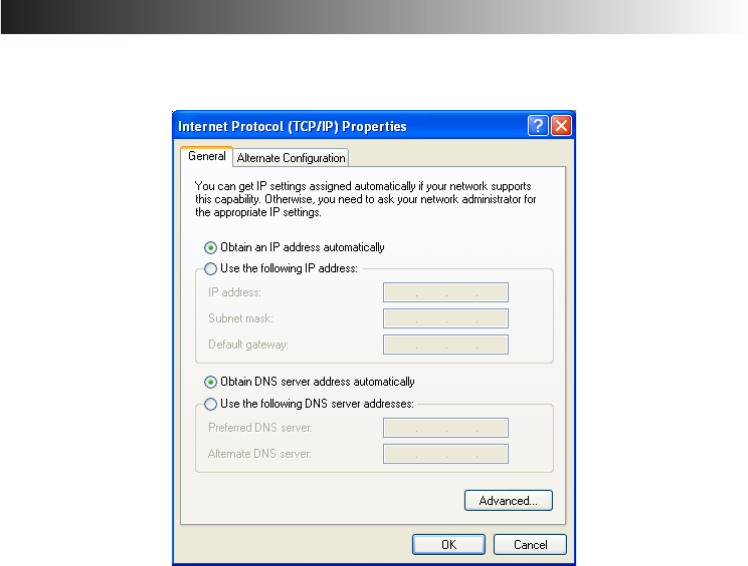
EN 71
4Click the [Properties] button on the [Wireless Network Connection Properties] screen.
The [Internet Protocol (TCP/IP) Properties] screen shown below now appears.
5Use the following example as a reference, and proceed with the settings to suit how the
wireless LAN is to be used.
For making a wireless network connection using a public wireless LAN service:
With a public wireless LAN service, it is customary for the DHCP server function that
automatically allocates the IP address to be enabled. On the [Internet Protocol (TCP/IP)
Properties] screen, click and select “Obtain an IP address automatically” and “Obtain
DNS server address automatically” and click the [OK] button.
For directly communicating with another PC using a peer-to-peer connection:
Set the IP address which has the same network address as the IP address of the PC that
serves as the other end of the communication. If, for example, the IP address at the other
end is 192.168.1.1, click and select “Use the following IP address” on the [Internet Protocol
(TCP/IP)] screen, and input 192.168.1.2, for instance, in the “IP address” field. Input
255.255.255.0 for “Subnet mask” and click the [OK] button.
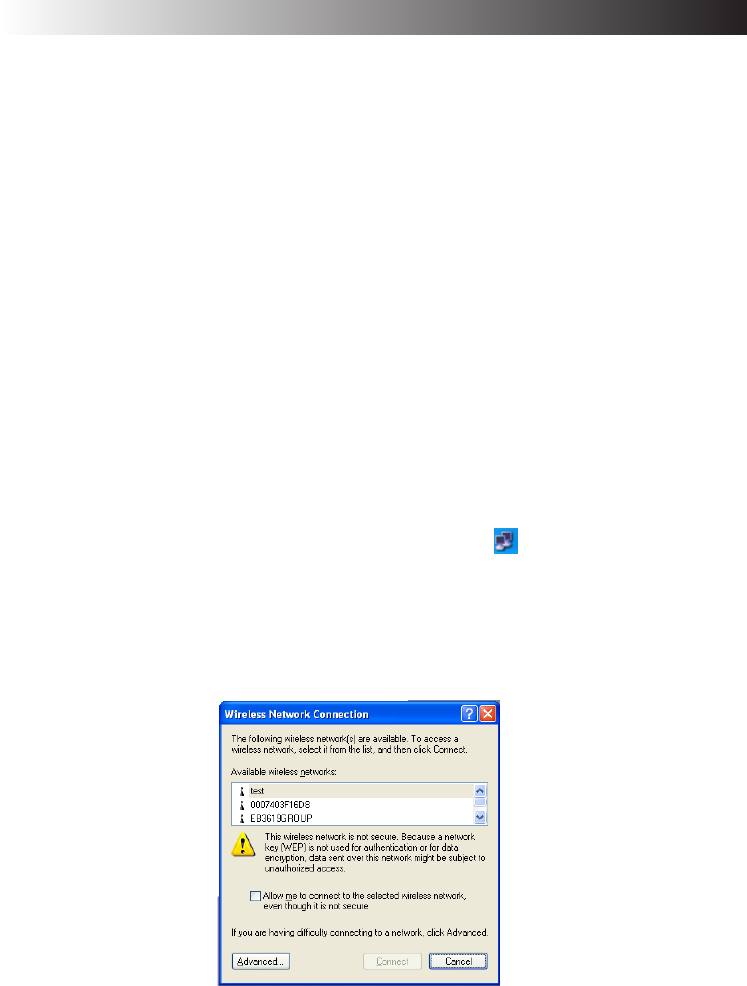
72 EN HARDWARE
For making the wireless network connection via an access point:
In cases involving an in-company LAN, etc. where a DHCP server is in operation on the
wired network to which the access point is connected, click and select “Obtain an IP
address automatically” and “Obtain DNS server address automatically” on the [Internet
Protocol (TCP/IP) Properties] screen, and click the [OK] button. (Check with a network
administrator to ascertain whether the DHCP server is in operation.)
In a home or other such environment where a DHCP server is not in operation, manually
set the IP address to the one that has the same network address as the IP address of the
access point. If, for example, the IP address of the access point has been set to 192.168.10.1,
click and select “Use the following IP address” on the PC’s [Internet Protocol (TCP/IP)
Properties] screen, and input 192.168.10.2, for instance, in the “IP address” field. Input
255.255.255.0 for “Subnet mask” and click the [OK] button.
When connecting to the Internet using a wireless LAN access point connected to an ADSL
modem (available from a retail store), check the method used to set the IP address with
the Internet service provider.
4. When the wireless LAN starts up, the PC automatically searches for the
network which can be used. When a usable network has been detected,
a message appears on the task tray.
5. Double-click the wireless network connection icon on the task tray at
the bottom right of the screen.
The [Wireless Network Connection] screen appears.
6. Select the access point to be connected from the ones in “Available
wireless networks”, and click the [Connect] button.
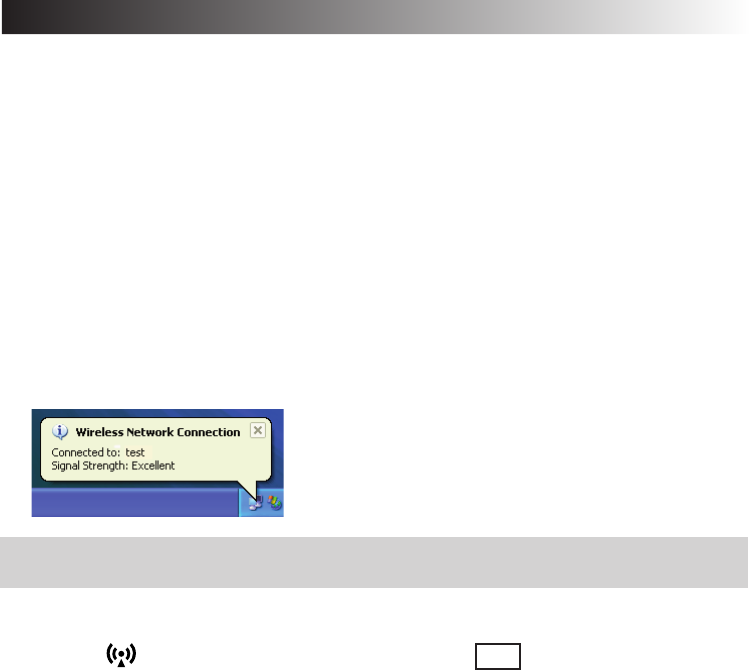
EN 73
Tips
In order to prevent wiretapping and unauthorized intrusions, a network key (WEP key)
may have been set for each access point. If a network key has been set, input as required.
For details on how to set the network key, refer to “How to Set the Wireless LAN Functions”
on page 74.
“WEP” stands for Wired Equivalent Privacy, and it refers to a technology which is used to
prevent wireless LAN wiretapping and unauthorized intrusions by encrypting the contents
of the communications between computers before sending them so as to increase the
security of the communications. To connect a computer to a wireless network in which a
“Network key” using WEP technology has been set, the same “Network key” and “Key
index” must be set.
7. When the computer is connected to the wireless network, the following
message appears on the task tray.
How to Shut Down the Wireless LAN Functions
1. Set the wireless LAN ON/OFF switch to OFF.
2. The wireless LAN indicator above the F10 key goes off.
•In order to conserve power, it is recommended that the wireless LAN functions be shut
down while they are not in use.
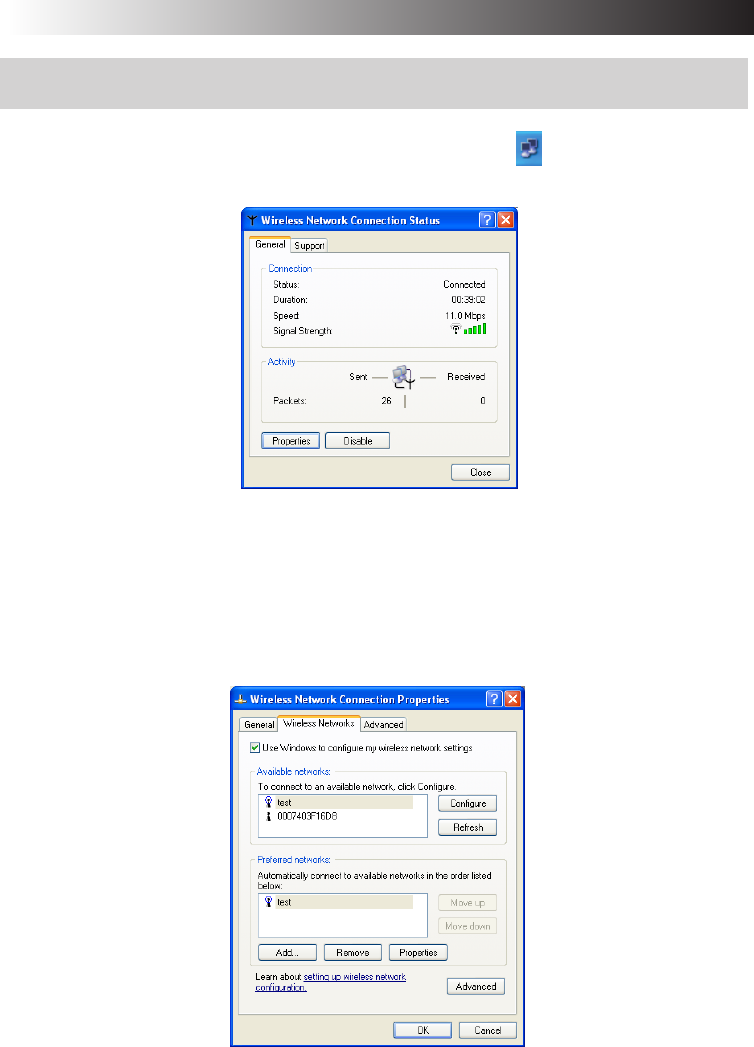
74 EN HARDWARE
How to Set the Wireless LAN Function
1. Double-click the [Wireless Network Connections] icon on the task tray.
The “Wireless Network Connection Status” screen will appear.
2. Click the [Properties] button on the [Wireless Network Connection Status]
screen.
The [Wireless Network Connection Properties] screen will appear.
3. Click the [Wireless Networks] tab on [Wireless Network Connection
Properties] screen.
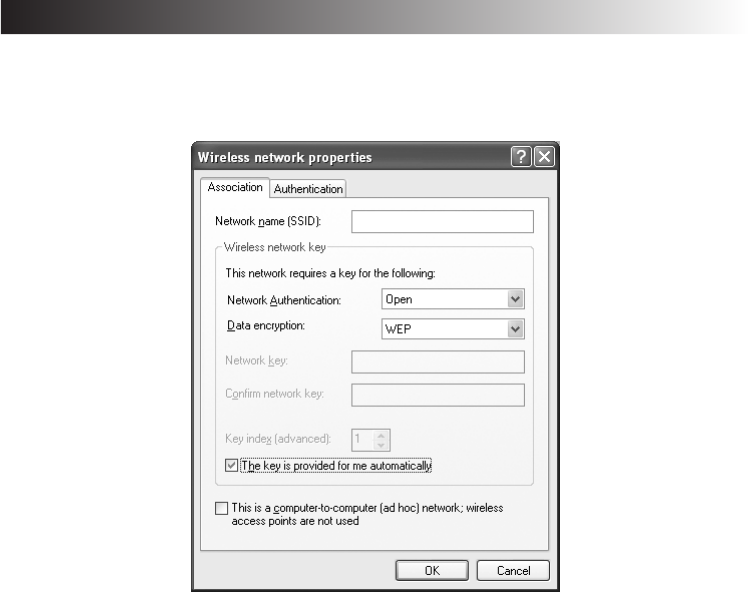
EN 75
4. Select the network used from the list of [Preferred Networks], and click
the [Properties] button.
5. Set the necessary items, and click the [OK] button.
Example 1) Set [Data encryption] to [WEP].
2) Remove the check from the “The key is provided automatically” item.
3) Input the “Network key.” (Verification input included)
With 64-bit WEP, a key consisting of up to five half-size alphanumerics (or
10 characters in the hexadecimal format) may be input.
With 128-bit WEP, a key consisting of up to 13 half-size alphanumerics (or
26 characters in the hexadecimal format) may be input.
4) Select “Key index.”
6. Close all screens. This completes the settings.
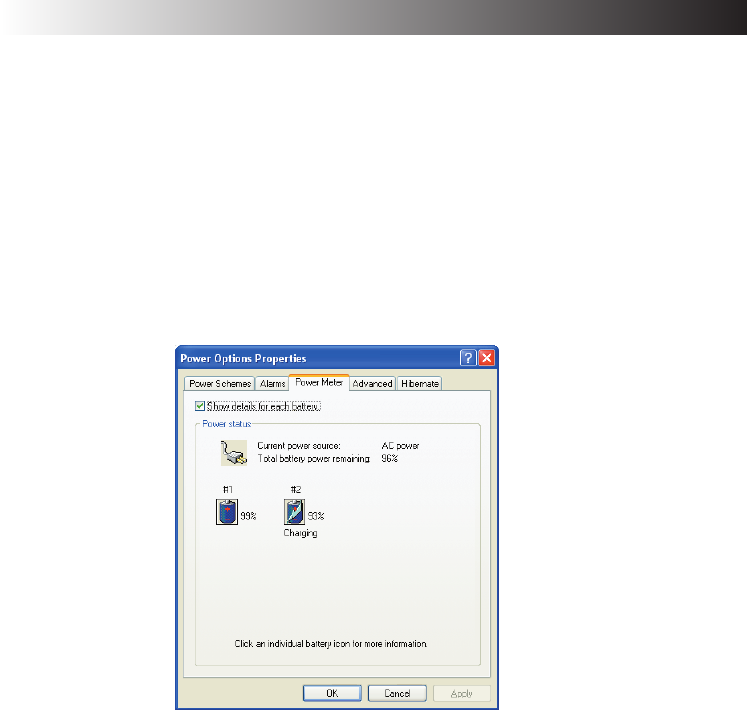
76 EN
Checking the Battery Level
On the “Power Option Properties” screen, click the [Power Meter] tab. The current total battery
level is displayed. Use the following procedure.
1. Click the [start] button and [Control Panel].
2. Click the [Performance and Maintenance] icon.
3. Click the [Power Options] icon.
The [Power Option Properties] screen will appear.
4. Click the [Power Meter] tab.
Battery gauges #1 (built-in battery) and #2 (external battery), and the total level of these two
batteries are displayed.
Important
•Battery gauge #2 (external battery) is displayed only when a standard lithium ion battery
pack or large-capacity lithium ion battery pack is used.
•Note that the external battery is consumed first.
HARDWARE
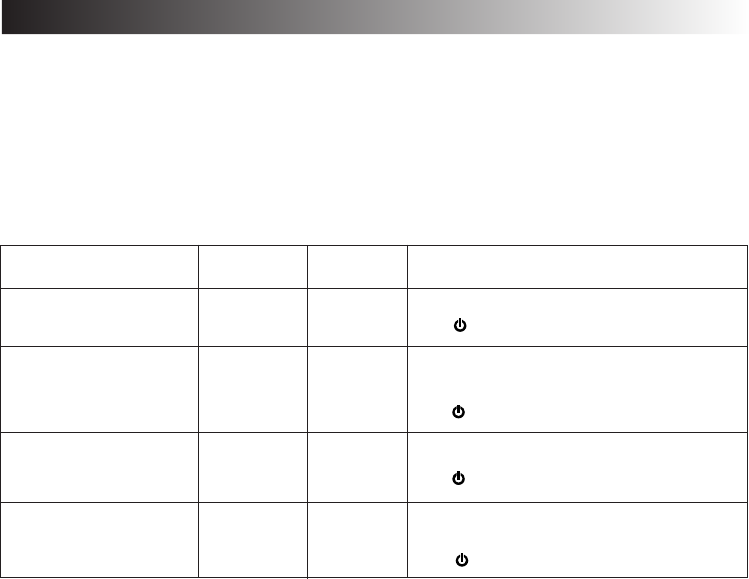
EN 77
Power-saving Mode
In compliance with the operation regulations of the International Energy Star Program, this unit
enters the power-saving mode when no operation is performed for a certain period.
On the [Power Schemes] tab in the “Power Option Properties” screen (page 76), you can specify
the time that must expire before the unit enters the power-saving mode. The table below shows
the factory settings.
Operating on
AC power
Status
1Turn off monitor: 15 minutes 5 minutes
2Turn off hard disks: 30 minutes 5 minutes
3System standby: 20 minutes 5 minutes
4System hibernates: 3 hours 2 hours
The LCD screen turns off.
The (Stand By) lamp is still lit in green.
The hard disk power is turned off with
the LCD screen kept off.
The (Stand By) lamp is still lit in green.
The PC stores the current system status
on the hard disk.
The (Stand By) lamp will go out.
The LCD screen is turned off.
The (Stand By) lamp flashes in green.
Tips
To exit status 1 or 2 , move the stick or press any key on the keyboard.
To exit status 3 , press the Power key or any key on the keyboard.
To exit status 4 , press the Power key.
Important
•In statuses 1 through 3, Windows is still running. Note that the current condition is
lost if the PC is turned off by pressing the Power key for more than 4 seconds.
Operating
on battery

78 EN
•System in standby status
The built-in battery discharges whilst the PC is in system standby status. As a result,
any unsaved data may be lost or the system may not start up. Be sure to turn off the PC
when it is not used for a long time.
Under fully charged condition, the unit can maintain the system standby status for the
following periods.
1About 25 hours with the built-in battery pack alone
2About 75 hours with the built-in and standard battery packs
•System in halt status
Continued operation on the PC displaying a battery-low warning causes the result as
follows:
1When the halt status is enabled
The PC turns off while maintaining the current data.
2When the halt status is disabled
The PC does not save the current data, which will be lost.
We recommend that you enable the halt status setting. This function is enabled at the
factory.
HARDWARE
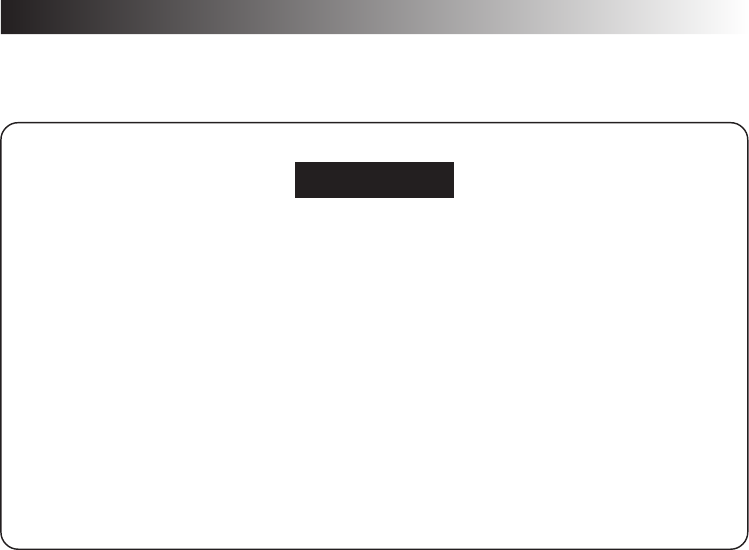
EN 79
Unknown Partition on Hard Disk
IMPORTANT!!
This PC reserves the image data required for recovery as a “recovery area” in the hard disk. If you
accidentally delete a partition of the recovery area, you cannot recover it. The important points to
keep in mind are:
•DO NOT attempt to delete a hard disk area shown as an “Unknown partition” using the
Windows XP “Administrative Tools”, or to assign it as another drive name.
•DO NOT attempt to delete the recovery area using specific software available in the market by
initializing or changing any partition in the hard disk.
Should you delete the recovery area and ask us to re-setup your PC, you will be liable for the cost.
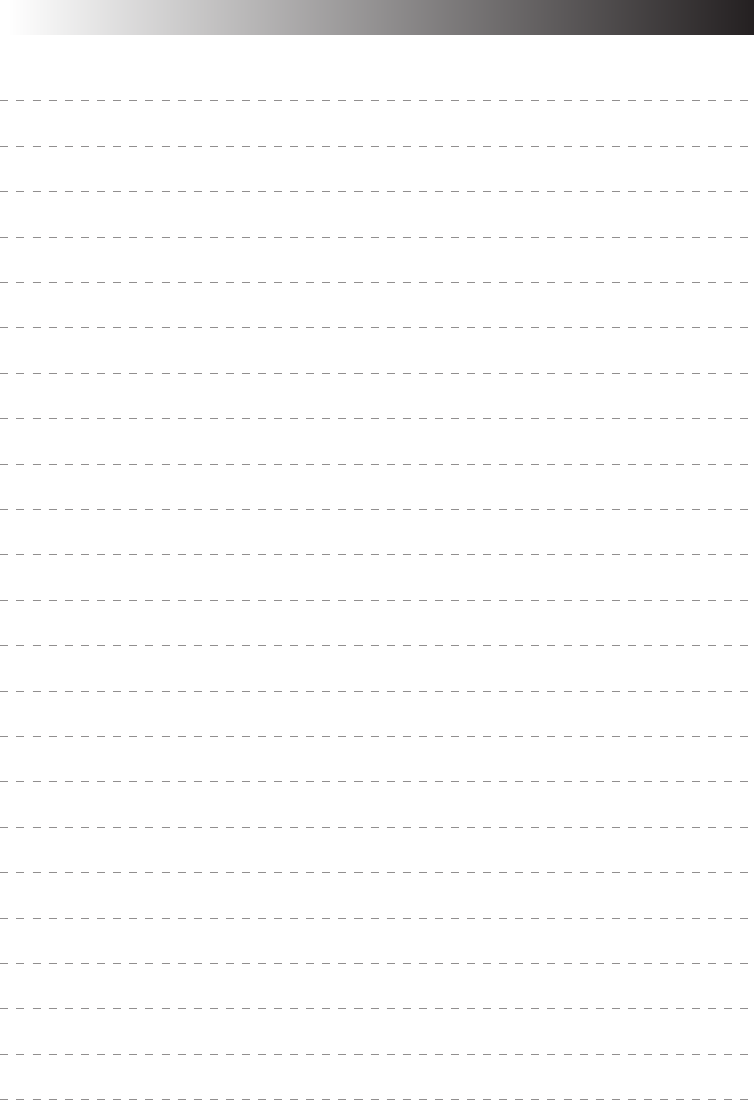
80 EN
MEMO

EN 81
PC RECOVERY
(REPEATED PC SETUP)
5

82 EN
PC RECOVERY (REPEATED PC SETUP)
Setting Up Your PC Again
1. What is the Recovery?
When you return your PC to the original state during shipment, it is called “PC recovery.”
You can recover your PC in one of the following two ways.
(1) Initialize the hard disk and restore all files.
(2) Restore the first partition of the hard disk only.
Caution
Do not reduce the capacity of drive C below 11G bytes.
For details, see “Select the recovery method (disk partitioning)” on Page 83.
2. Before Starting Repeated Setup
The following explains the preparation required befor system recovery.
•You may not solve the problem even if you have recovered your PC. If the problem
continues, consult our PC Technical Support Centre.
•You can use System Recovery on your PC only. You cannot use this software for the PC of
another manufacturer.
Cautions
1) File backup
•If you have recovered your PC, it will have been returned to the status before shipment.
All files you have created, applications you have added, and various parameters you
have set will have been cleared and lost.
Before starting system recovery, back up any important files you have created on CD-R
disk or hard disk drive D of your PC.
•If you have backed up the important information in drive D, you must select the option
in Step 2 “Select the recovery method (disk partitioning)” on Page 83 and you must
recover drive C only.
2) When starting System Recovery
Detach all peripherals from your PC. If not, the recovery may stop or the required operations
may differ from those written in the manual.
3. Repeated Setup
Execute the Recovery program to restore the information on the hard disk. The Recovery
program returns both your PC and all applications back to the original state before shipment.
If you wish to set up the application software separately, upload them from the Application
CD-ROM one at a time. (See “To Set Up the Standard Applications Again” on Page 34.)
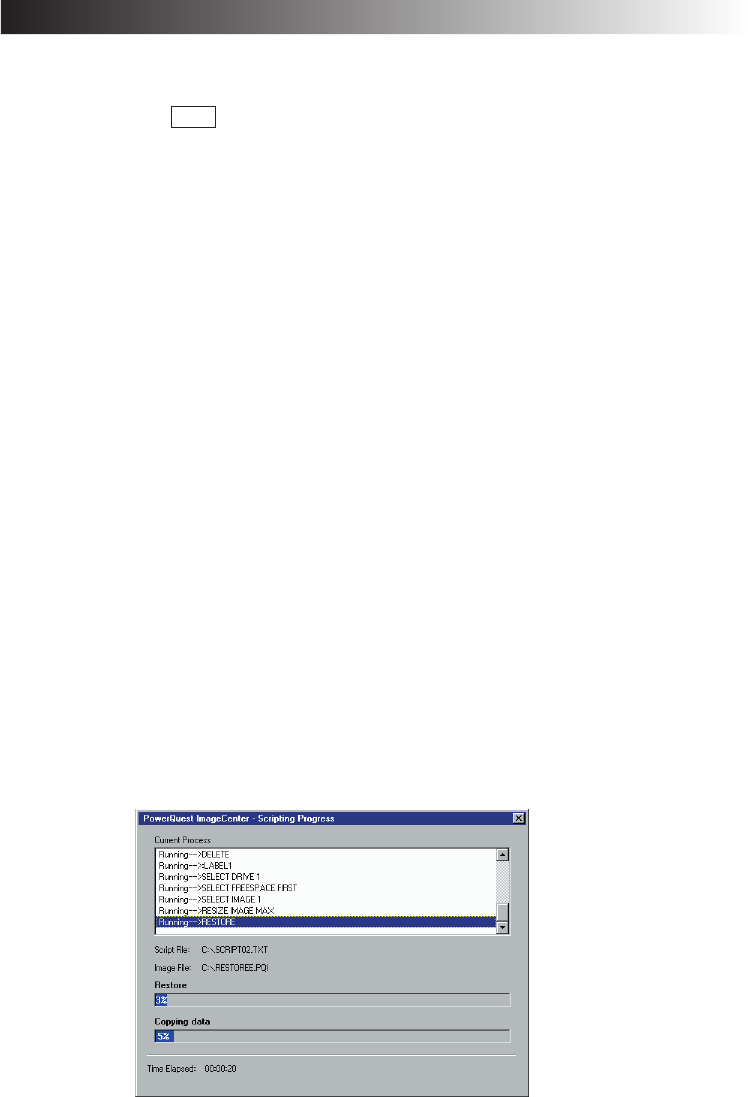
EN 83
System Recovery Procedure
1. Hold down the F10 key and press the Power button to start up your PC.
When message “Do you wish to continue? (Y/N)” appears, respond with Y.
Tips
•If you respond with N, the recovery is canceled. The PC will restart and the Windows OS
will start up.
•If too much time is taken to press the key or a continuous beep is heard for other reasons,
turn off the power, and repeat the process.
•If Windows starts up after a delay, exit Windows, turn off the power, and repeat the process.
2. Read the License Agreement when displayed.
If you accept the Agreement, type Y.
Tips
If you respond with N, the recovery is canceled. The PC will restart and the Windows OS
will start up.
3. Select the recovery method (disk partitioning).
When message “Select the recovery method (A (Recommended)/C)” appears, respond with
the 1 or 2key as follows.
1If you respond with A:
All disk partitions and files of the hard disk are recovered, and the entire PC system is
initialized to its original state.
2If you respond with C:
The files of drive C are recovered and initialized.
(Usually, all data of drive D remains unaltered, as they are, and only the data of drive C
is initialized. If drive D has already been removed, the PC only has drive C.)
4. The system recovery starts, and its progress is shown on the screen.

84 EN
COMPUTER WIEDERHERSTELLUNG (RECOVERY)
5. After the system recovery has been completed, the message “Turn Power switch
off and restart the PC.” appears. Restart your PC.
Your PC has been returned to the original state before shipment.
6. Set up the Windows OS by following the “Initial Setup of Microsoft Windows”
procedure on Page 20.

EN 85
TROUBLESHOOTING
6
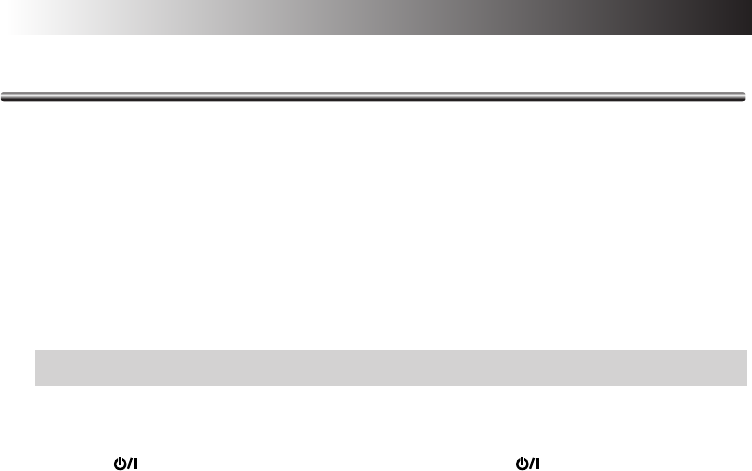
86 EN
Q&A
There are several troubleshooting keys. If you are not sure how to operate your PC, your PC does
not work well, or you suspect that your PC has been damaged, follow the relevant troubleshooting
steps in the Q&A section.
If the Q&A does not help you
Contact us.
If you cannot remove the trouble successfully, contact the JVC PC Technical Support Centre.
See the back cover for the phone number.
Power
Q. The power does not turn on.
A. Check the following.
• Check that the Power key is pressed.
Press the (On/Off) key to turn on your PC. See “Turning (On/Off) key On” on page
19.
When you are using your PC on AC power
• Check that the AC adapter is connected.
For connection, see “4. Recharge the built-in battery pack by plugging the AC cord into DC
Input connector” on page 17.
When you are using your PC on the battery
• Check that the battery is fully charged.
For how to charge the battery, see “5. Make sure that the battery pack is fully charged” on
page 18.
TROUBLESHOOTING

EN 87
Startup and Operation of Windows
Q. The screen has hung.
A. Use the following procedure to forcibly exit the applications running on your PC.
Important
When applications are forcibly terminated through this procedure, any unsaved unsaved
data will be lost.
Terminating an application forcibly
1. While holding down the [Ctrl] and [Alt] keys, press the [Del] key once.
The “Windows Task Manager” screen will appear.
2. Click the [Applications] tab.
3. Click the application that hung, then [End Task]. In most cases, applications that have
hung are indicated as “Not Responding.”
4. When a confirmation message for terminating the application appears, click [End Now].
5. Click [x] on the Windows Task Manager screen.
Tips
When the application cannot be terminated, forcibly restart Windows. To restart Windows
forcibly, start Windows Task Manager, click [Shut Down] on the toolbar, then click [Restart].
If your PC does not restart through the above procedure, press the RESET button on the
side of the unit (page 12) or keep pressing the Power key for 4 seconds or longer to turn
off the power.
About the message appearing if Windows is not exited normally
If you turn off the power without terminating Windows, the “Checking file system on c:”
message appears at the next Windows startup, Windows and hard disk conditions will be
checked, and data will be restored as necessary.

88 EN TROUBLESHOOTING
Q. If the system fails to start up when I have tried to start it up with a USB device
connected
A. Disconnect the connected USB device, start up the system, and then re-connect the device.
Q. Starting the PC in the safe mode
A. If some kind of trouble occurs on the PC, use the safe mode where the PC starts up with
minimum functions.
Use the following procedure to start up your PC in the safe mode.
1. Turn on the PC.
2. As soon as the JVC logo appears, hold down the F8 key.
Tips
If the F8 key is pressed too late, Windows tries to make a normal startup.
Restart your PC and go back to step 2.
3. Select [Safe Mode] and press Enter .
4. Check that the operating system is selected on the “Please select the operating system to
start:” screen. Press Enter .
5. When you see the “To begin, click your user name” message, click an account with
which you want to start the PC in the safe mode.
6. Clicking [Yes] starts your PC in the safe mode.
Q. If Windows will not start
A. When “Power On Self Test” is carried out at the time of power on and something wrong or
out of order is detected, an error code (2 digits) is indicated on the screen, and start-up is
suspended.
If you think that Windows will not start confirm whether an error code is indicated on the
screen. When you ask for service, please report this error code to the service centre.
An error code may not always be indicated dependent on the cause of the trouble.
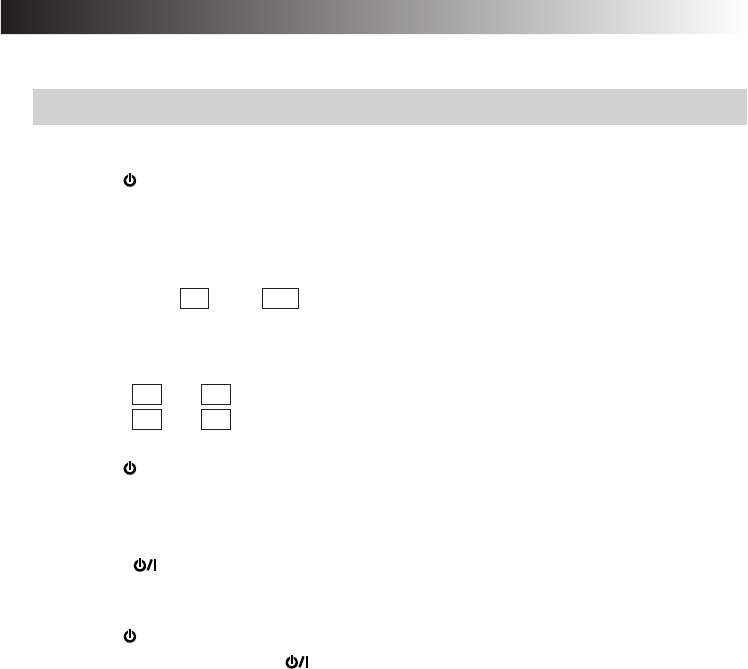
EN 89
Display
Q. The PC is turned on but nothing appears on the screen.
A. If the screen blacks out during operation, check the following.
• When the (Stand By) lamp is lit.
•Move the stick or press any key on the keyboard to check if the power-saving function is
working.
•Check if the display is configured as an external display device.
While pressing Fn , press F10 . (Each time you do this, you can change between external
display and LCD modes.)
•To adjust the LCD display brightness:
Pressing Fn and F1 turns the screen darker.
Pressing Fn and F2 turns the screen brighter.
• When the (Stand By) lamp is flashing.
The PC is in standby mode (The power-saving mode is working).
Press the On/Off key or any key on the keyboard.
Important
Pressing the (On/Off) key for more than 4 seconds terminates Windows forcibly, discarding
the unsaved data.
• When the (Stand By) lamp is not lit.
The PC is turned off. Press the (On/Off) key to turn on your PC.

90 EN TROUBLESHOOTING
Using the Internet
Q. I cannot dial up.
A. Check the connection.
•Check that the modem cable is connected.
If you see the “There was no dial tone.” message, check the connection between the unit
and the telephone line connector on the wall. Insert the modem fully until it is locked.
• When a divider is used
Connect the modem cable directly to the phone jack for checking.
•When you are connecting via an ISDN line
Check that the terminal adapter is ready.
For details, refer to the instruction manual for your terminal adapter.
•Check that the modem is recognized properly.
1. Click the [start] button and [Control Panel].
2. Click the [Printers and Other Hardware] icon.
3. Click the [Phone and Modem Options] icon, then the [Modems] tab.
4. Select the modem by clicking it, click [Properties], then the [Diagnostics] tab.
5. Click [Query Modem].
When the modem is recognized properly, the inquiry command and response to it will
be displayed.
Important
If the modem is not recognized properly, check if it conflicts with any other device.
If the modem device is displayed with a “!” mark on the Device Manager screen, it may
conflict with another device.

EN 91
Q. The PC dials but connection is not established.
A. Check the dialing setting.
•Check that the dialing type (tone or pulse) is correctly set for your telephone line.
For checking and configuration procedures, see “3. Setting up the modem” on page 38.
• When no connection operation occurs, check the destination setting.
Use the following procedure to check the setting for connecting to your Internet Service
Provider (ISP) or network.
1. Click the [start] button and [Control Panel].
2. Click the [Network and Internet Connections] icon.
3. Click the [Network Connections] icon.
4. Right-click the icon for the destination of connection to bring up a pop-up menu. Click
[Properties] in the menu.
5. Check the setting according to the instruction manual provided from your ISP.
•On the [General] tab, check the “Connect using” and “Phone number” settings.
Tips
Some ISPs have different phone numbers for access points via ISDN lines from those
for points via ordinary lines. Contact your ISP for details.
•For how to check and set the DNS server addresses (primary DNS and secondary
DNS), see DNS server address setting procedure (10-20) on pages 42 and 43.
Important
If your ISP specifies no DNS server address, click [Obtain DNS server address automatically].

92 EN
Q. The PC makes a connection operation but connection is not established.
A. Check the following.
•Check the user name and password.
Refer to the material sent from your ISP for correct user name and password.
• The internal modem dials but negotiation is not made.
The access point may have a problem. Try to establish a connection later. If this attempt
fails, use a different access point.
• Advice when using the internal modem
If “Max Battery” or “Presentation” has been selected for “Power Options” in the “Power
Options”/”Power Schemes” tab from [Power Option Properties] and the battery is being
used to power the PC, this may cause the internal modem to slow down its speed of
communication or fail to dial up, depending on the condition of the telephone line. In
cases like this, change to a setting other than “Max Battery” or “Presentation” (such as
“Portable/Laptop”).
Q. The PC cannot send or receive e-mail messages.
A. If you are using the Outlook Express software, check the e-mail software settings.
If you are using any other mailer than Outlook Express, refer to the pertinent instruction
manual or help.
1. Start Outlook Express.
Tips
If the “Dial-up Connection” screen appears, click [Work Offline] or the [x] button.
2. Click [Tools] on the tool bar (at the top of the screen). Click [Accounts] on the Tools
menu.
3. Click the [Mail] tab.
4. Click an account and [Properties].
5. Click the tabs to check that the entries are correct.
Important
Use lower-case letters only.
TROUBLESHOOTING

EN 93
Wireless LAN
Q. I can’t communicate.
A. Check the following.
• Is the device serving as the other end of the communication the kind of device which can
communicate with the PC?
A number of communication systems can be used with the wireless LAN, but unless the
same system is used at both ends, communication will not be possible.
• Has the security been set correctly?
Select the same setting for the network key (WEP encryption) of this PC’s wireless LAN as
the one used by the access point.
• Has the IP address been set correctly?
Check whether the IP address been set correctly by taking step 2 (Set the IP address used
with the wireless LAN) on page 69 in the section entitled “Network connections using a
wireless LAN.”
• If the wireless LAN cannot be set to ON or OFF
When the PC has been re-started after termination caused by an error, the wireless LAN may
remain inoperable. In a case like this, shut down the PC and then start it up again.
Q. The communication speed is slow.
A. Check the distance between the PC and the other end of the communication. In some
cases, the communication speed varies depending on the distance involved.
Q. I can’t share with other computers on the network.
A. If no other computers appear on “Local Network” selected from “My Network Places,”
establish the same “Workgroup” or “Domain” setting.

94 EN
Q. How can I check the MAC address?
A. Proceed as follows to check the MAC address of the PC’s wireless LAN.
*In order to check the MAC address, the wireless network connection must first be set
using [Network Connections].
1. Click the [Start] menu, and click [Control Panel].
2. Click the [Network and Internet Connections] icon.
3. Click the [Network Connections] icon.
4. Check that [Wireless Network Connections] is enabled.
5. Double-click [Wireless Network Connections].
The “Wireless Network Connection Status” screen appears.
6. Click the [Support] tab, and click the [Details] button.
The [Network Connection Details] screen appears.
7. The value for “Physical address” displayed on the list indicates the MAC address.
Battery
Q. The battery is not charged.
A. Check the following.
•When the built-in battery cannot be charged
This PC is shipped with a short-circuiting pin on the standard lithium ion battery pack
terminal. Be sure to remove the pin before use.
For removal, see “Mounting/Dismounting the Lithium Ion Battery Pack” on page 16.
• When the standard lithium ion battery pack cannot be charged
For how to mount the standard lithium ion battery pack, see “Mounting/Dismounting the
Lithium Ion Battery Pack” on page 16.
If you are still unable to charge the battery pack, check the following.
Check that the AC adapter is connected correctly to an appropriate power socket and the
PC unit.
For connection, see “4. Recharge the built-in battery pack by plugging the AC cord into DC
Input connector” on page 17.
Q. Battery discharge faster than expected.
A. This device continues to supply DC current to the USB port in standby in order to respond
to the wake-up signals from some USB peripherals.
If you keep this device in standby for long time with just battery power, please remove
peripherals from the USB port.
TROUBLESHOOTING

EN 95
Miscellaneous
Q. The PC is hot.
A. The PC may become warm when used for a long time, but this is not a failure.
Do not block the vents in the bottom or sides through which internal heat is removed.
Q. The PC makes no sound.
A. Check the following.
•Check if the speaker is muted.
To use the volume control, press Fn and F7 .
(This key combination turns on and off the volume control.)
Pressing Fn and F5 turns down the volume.
Pressing Fn and F6 turns up the volume.
Q. I forgot the password.
A. If you forgot your password, you cannot start the PC again.
Whenever you set a password, be careful not to forget it.
•If you forget the user account (computer administrator) password
1. When a password deleting disk has been prepared
You can delete the password using the disk. For how to prepare a password deleting disk,
see “Help and Support Centre” from the [start] menu.
2. When another computer administrator account has been created
If an additional computer administrator (a user who has the administrator rights) is created
other than the user who forgot the password, log on to the computer as the administrator
to change the password.
3. When no computer administrator account has been created
When no administrator password is set, you can change the forgotten user password by
starting up Windows in the safe mode and logging on as an administrator.
*If any of the above does not solve the problem, you must restore the factory setting. For
procedure for setting up Windows again, see “Setting Up Your PC Again” on page 82.

96 EN
•If you forget the BIOS password
The following passwords can be set on the BIOS.
•Supervisor Password
This is the password used by the administrator. If it has been set, it means that only an
individual who inputs this password correctly can set or change any of the items. The
user will be asked for this password at boot-up and BIOS setup.
•User password
When this password is set, the user is requested to enter the password to start Windows
or change a BIOS setting.
•HDD password
The password required for accessing the hard disk.
Important
•You cannot delete the BIOS password even if you forget it. To delete it forcibly, you
have to return your PC to us for chargeable service. (It may require hard disk drive
replacement.)
•To bring up the BIOS menu, turn on the PC and press the Alt and F2 keys while the
JVC logo screen is shown.
Do not change the BIOS setting unless you have adequate knowledge of computers.
A wrong setting can make your PC unable to start up again or, worse, damage it.
Q. Setting procedure does not complete.
A. If Internet, e-mail, or any other setting does not complete through the procedure described
in this manual, check the following.
•If the [Control Panel] display is in Classical mode, change it to the Category mode. All
the setting procedures in this manual assume the Category display mode.
TROUBLESHOOTING

APPENDIX
7

98 EN
List of Support Centres
1. ImageMixer with VCD 1.1 VJ
http://www.imagemixer.com
2. Norton AntiVirus 2004
http://www.symantec.com/region/reg-eu/techsupp/index.html
3. RealOne Player
http://www.service.real.com
4. PINNACLE STUDIO 8 SE
http://www.pinnaclesys.com
APPENDIX

EN 99
Trademark Notice
1. i.LINK refers to IEEE1394-1995 and their expanded specifications. i.LINK and the
i.LINK logo are trademarks of Sony Corporation, devised to make people more
familiar with IEEE 1394.
2. Microsoft, Windows, Windows Media are trademarks or registered trademarks of
Microsoft Corporation in the U.S. and other countries. The official name for
Windows is Microsoft Windows Operating System.
3. RealOne Player is a registered trademark or pending trademark of RealNetworks,
Inc. in the U.S. and other countries.
4. Adobe, the Adobe logo, and Adobe Acrobat are trademarks of Adobe Systems
Incorporated.
5. Symantec, the Symantec logo, and product names are trademarks or registered
trademarks of Symantec Corporation in the U.S. and other countries.
6. Symantec, the Symantec logo, and Norton AntiVirus are registered trademarks of
Symantec Corporation in the U.S.
7. CC Converter and the CC Converter logo are trademarks.
8. The Pinnacle System Inc. logo and product names are registered trademarks of
Pinnacle System Inc. in the U.S.
9. Other system, product, and service names may be trademarks or registered
trademarks of respective developers.
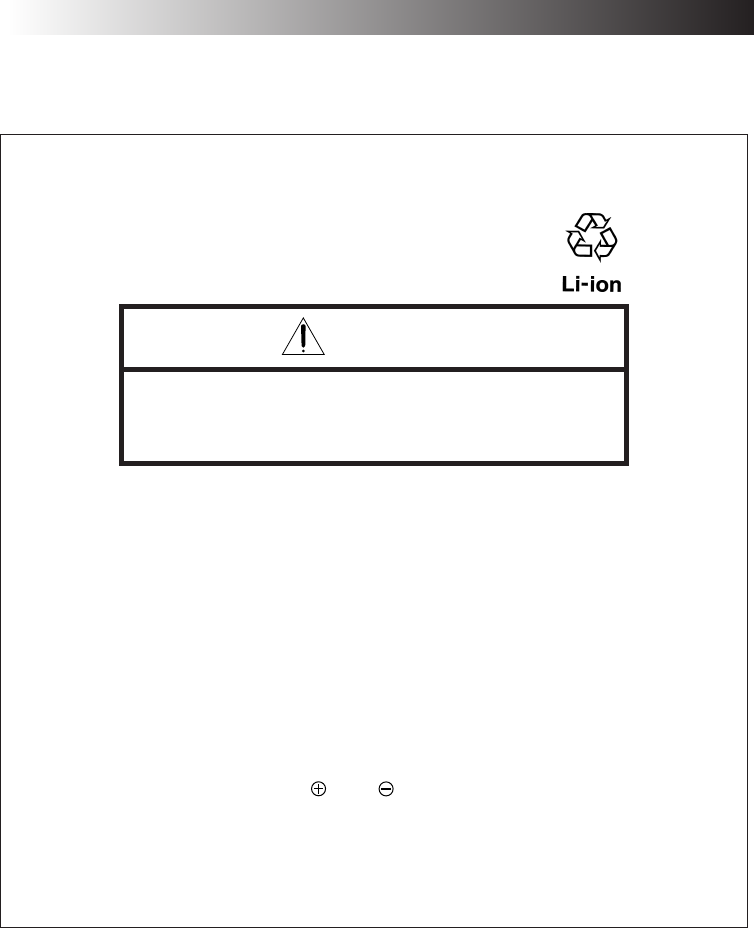
100 EN APPENDIX
How to Disposal
Recommendations for product disposal
Lithium-ion battery packs which are no longer required constitute a
precious recyclable resource.
When disposing of the product, do not dispose of the lithium-ion
battery pack but recycle it instead.
•How to remove the lithium-ion battery pack
1. To remove a standard battery pack or large-capacity battery
pack, refer to page 16.
2. For details on how to remove the internal battery pack, refer to
page 59.
*Take care not to short the “ ” and “ ” terminals of a battery pack
which has been removed.
Under no circumstances must the lithium-ion
battery packs be disassembled.
Doing so may cause a fire, electric shocks and/or injury.
Warning
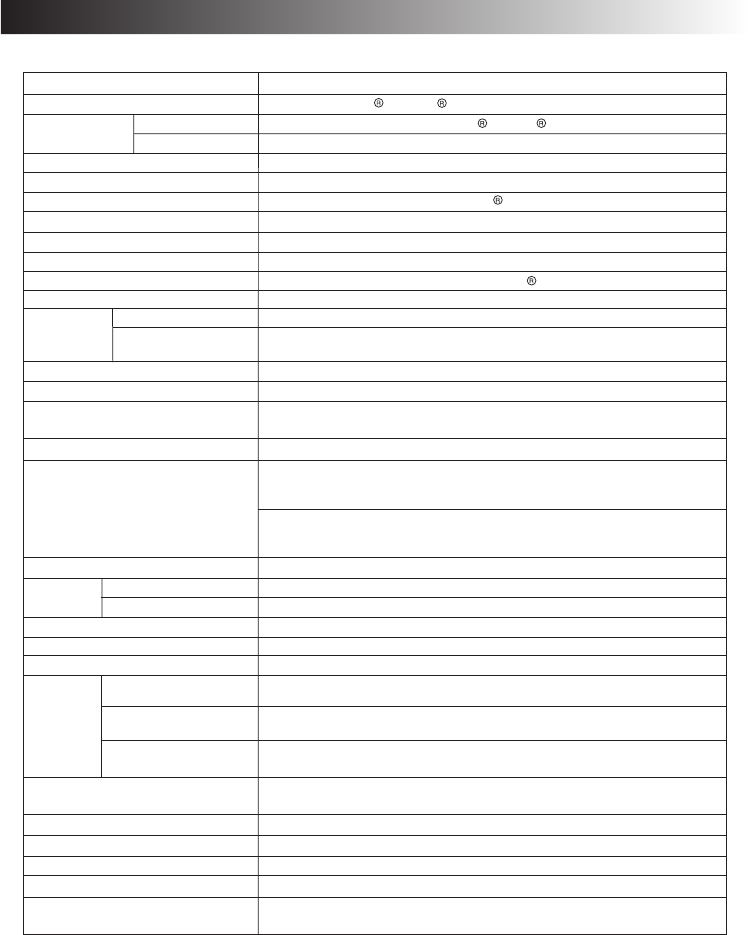
EN 101
Model Name MP-XV841GB
OS Microsoft Windows XP Professional (Build in Service Pack 1)
CPU Model
Intel
Clock speed 1GHz
Bus clock speed 400MHz
Secondary cache memory 1MB
Main memory 256MB, standard (256MB on-board)/768MB, max.
Extended memory slot (available slot) MicroDIMM (DDR333) slot x 1 (1)
Hard disk 40GB
*1
Graphic accelerator Built-in
Video memory Shared with main memory (max. 64MB)
*2
Built-in monitor
Screen size
8.9-type low-temperature polysilicon TFT liquid crystal (with backlight)
LCD screen
(machine body)
1024 x 600 dots, 16.77 million colours
External monitors
*4
*10
*11
*12
*5
*4
*8
800 x 600-2048 x 1536 16.77 million colors
Sound Compatible with built-in Chipset AC'97, built-in stereo speakers
Built-in fax/modem Max. transmission speed: 56kbps (data receive), 33.6kbps (data send), 14.4 kbps (fax)
Compliant with V.90/K556flex
TM
standard (auto-change)
Interfaces External monitor outputs
/Modem jack (RJ-11) x 1
/USB(2.0) x 2
/iLINK (IEEE1394) 4-pin S400 x 1
/LAN connector (10/100BASE-TX) x 1 /SD Card x1
MIC IN (mini-jack mono) x 1
/Headphone OUT (mini-jack stereo) x 1
/Type-II PC-card slot x 1 (compatible with CardBus)
Keyboard Key pitch 16 mm
Key stroke 1.5 mm
Pointing device Stick type
Power supply AC adapter or lithium ion battery packs
Power consumption Max. 46W
Battery
operation
Built-in battery Approx. 1.8 hours
(JEITA 1.0)
Approx. 3.5 hours
(JEITA 1.0)
Approx. 7.0hours
(JEITA 1.0)
Built-in battery +
standard battery pack
Built-in battery +
Large battery pack
Battery charging time (OFF times)
Built-in battery: Approx. 50 min. (80%), 90 min. (100%)
Standard battery pack: Approx. 70 min. (80%), 140 min. (100%)
Dimension 225 mm (W) x 29.5 mm (H) x 152 mm (D)
225 mm (W) x 29.5 mm (H) x 177 mm (D)
Dimension with standard battery pack installed
Weight Approx. 905 g
Approx. 1075 g
Weight with battery pack installed
Ulta Law Voltage Intel Pentium M processor
Chipset 855GME
Intel 855GME
Maximum2048 x 1536 dots, 16.77 million colours (Vertual display mode)
*3
Wireless LAN
*6
Internal (IEEE 802.11b/g standard met)
*7 /Docking port x1
Mechanical Switch Wireless LAN ON/OFF
*9
Lithium-ion standard battery pack, AC adapter, application CD-ROMs x 2
instruction manual, External display cable
Main accessories
Specification Main unit
*1 The hard disk capacity is given as a multiple of 1GB which is taken to be the equivalent of one billion
bytes. Bear in mind that if a method of calculation where 1MB defined as being equivalent to 1024KB
is used, the resulting number of bytes will differ from the above hard disk specification. For the partitions,
approximately 2.3GB (which cannot be used by the user) are pre-assigned as the recovery area,
approximately 5GB are assigned to drive D, and the rest of the memory is assigned to drive C.
*2 The video memory of 8MB to 64MB is automatically assigned from the main memory depending on the
PC’s operating conditions. For this reason, it cannot be changed manually.
*3 This is achieved by the dithering function.

102 EN
*4 An optional connecting cable (MP-VGX2E) is required for the connection with the external monitor.
Depending on the external monitor used, some modes may not be displayed.
*5 Displayed on the external monitor only.
*6 The channels which can be used by this wireless LAN are 1 to 11. An access point is required in
addition if the wireless LAN is to be used to connect to a LAN system or the Internet. Use a Wi-Fi
certified unit.
*7 Not all operations of USB-support devices are guaranteed.
*8 Not all operations of i.LINK-support devices are guaranteed.
*9 The lithium-ion battery is a consumable.
*10 The battery operation times are the values measured in the power saving mode; they vary depending
on the setup or usage.
*11 While the PC is being used, the battery charging time may taken up to 1.5 times as long as the value
given here.
*12 These CD-ROMs are required to re-install the software provided with the PC. They do not contain the
operating system. A separate CD-ROM drive is required. The data on these disks can be installed in
this PC only.
APPENDIX
Wireless LAN Specifications
Note:There is a correlation between the communication distance of a wireless device and its
communication speed: The lower the communication speed of the wireless communication,
the further the communication distance. Furthermore, the communication distance is
susceptible to the effects of the ambient environment, and it may be reduced in the following
cases.
•Inside condominiums and other reinforced concrete structures, houses in which metal is
used in the building construction materials
•Near large pieces of furniture, etc. made of metal
MP-ACX1 AC Power Adapter (including dedicated AC Cable)
Input Voltage AC 100 to 240 V 1.5 A 50/60Hz
Output Voltage DC 19 V 2.64 A
Wireless frequency band 2412 to 2462 MHz (all 11 channels)
Modulation system DSS (Direct Spread Spectrum system)
CCK
(communication speed: 5.5 Mbps, 11 Mbps)
DQPSK (communication speed: 2 Mbps)
DBPSK (communication speed: 1 Mbps)
Spread spectrum system 11-chip Barker sequence
Rated output 16 dBm
Communication distance Recommended communication distance
between PC and device serving as other end of
communication: 25 metres indoors
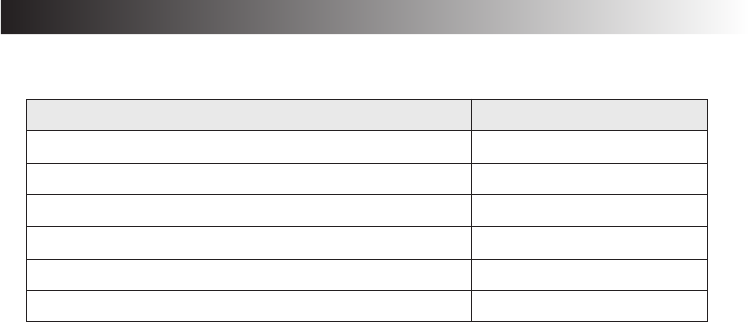
EN 103
Options (separately available)
Option name Model
CD-ROM drive *1 MP-CDX1E
DDVD-ROM/CD-RW/RCDtandard lithium ion bat MMP-WDX2Eery pack *2 BN-LS12E
Large-capacity lithium ion battery pack *3 BN-LL232E
Battery charger *4 MP-BCX1E
AC adapter *2 MP-ACX21GB
External display cable MP-VGX32E
*1 Connected with a PC card and powered from the Mobile mini note PC. Maximum read
speed is 16x. (Not corresponding to boot.)
*2 Same items as those supplied with the product.
*3 Enables 7.6 hours of continuous operation when used with the built-in battery.
It comes with a carrying case. This is used exclusively by this PC. It cannot be used by any
other models released to date.
*4 High-speed battery charger. It supplies power to the Mobile mini note PC and charges the
built-in battery pack while charging an external battery pack.
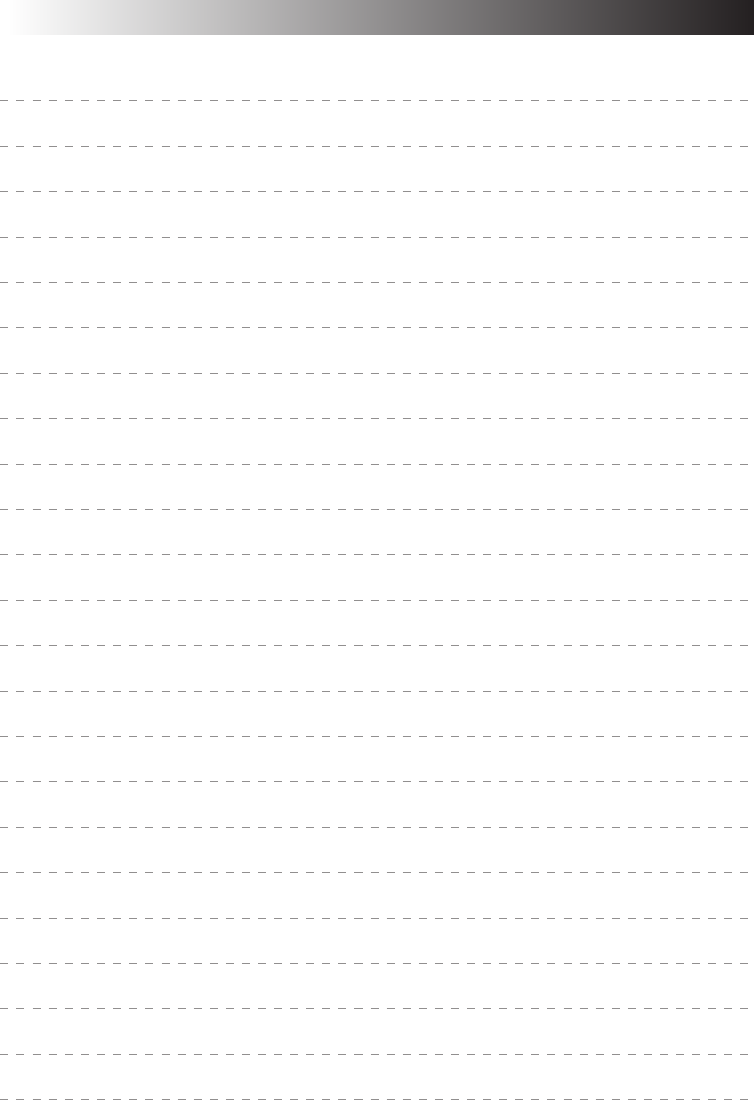
104 EN
MEMO

EN 105
MEMO

LET0240-003A
INSTRUCTIONS
Before Use
Read and follow the instructions of this manual to use your Mobile
mini note PC correctly.
Always read the “Safety Precautions” and “Operation Notes.” Keep
this manual and the warranty card for further reference.
Thank you for purchasing the JVC MP-XP731GB Mobile mini note PC.
2004 VICTOR COMPANY OF JAPAN, LIMITED
MP-XP731GB
Printed in Taiwan
0803KHY
*
IDASS
VICTOR COMPANY OF JAPAN, LIMITED
Mobile mini note PC
·This equipment with RLAN is intended to be used in Germany, UK,
Austria and Switzerland.
Outdoor use may be restricted to certain frequencies and/or may
require a licence for operation.
·The built-in V.90 modem is installed for use on official analog
telephone lines in Germany, UK, Austria, France and Switzerland.
0197